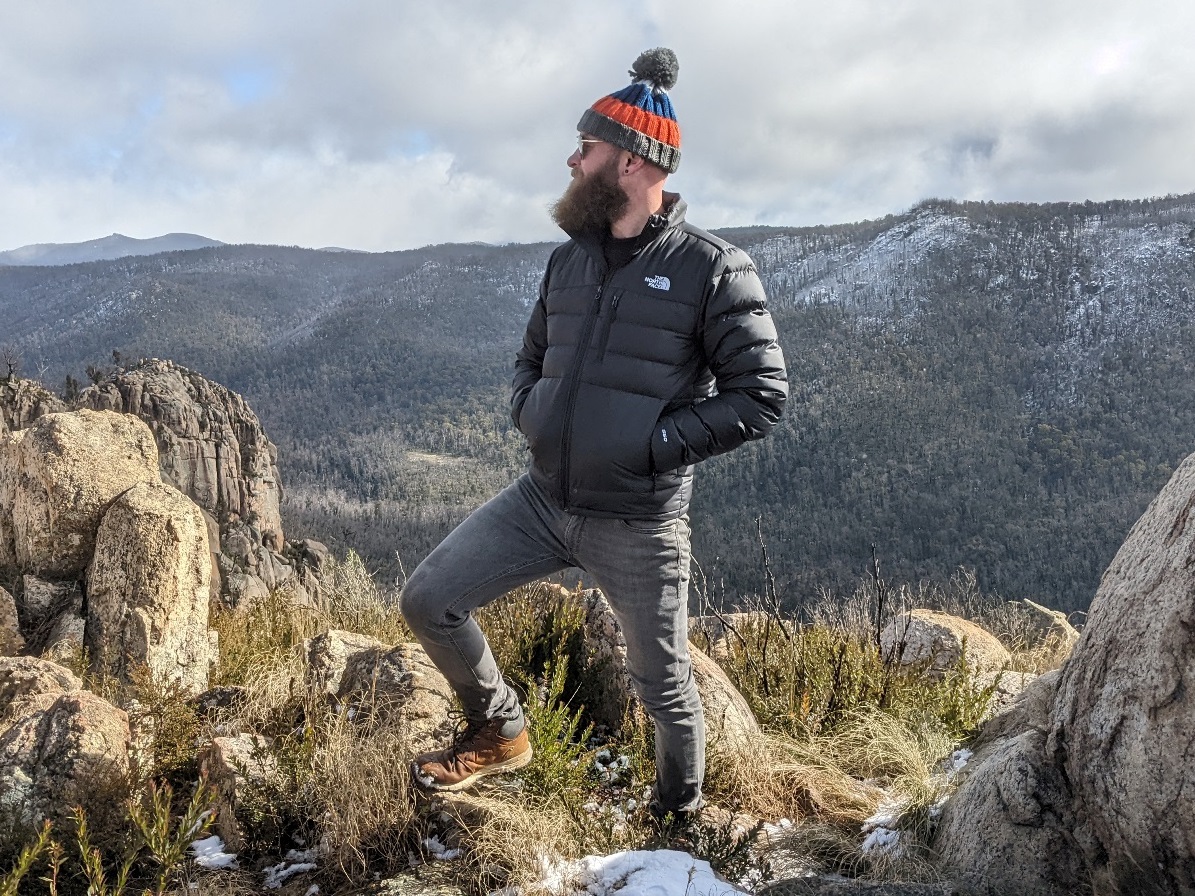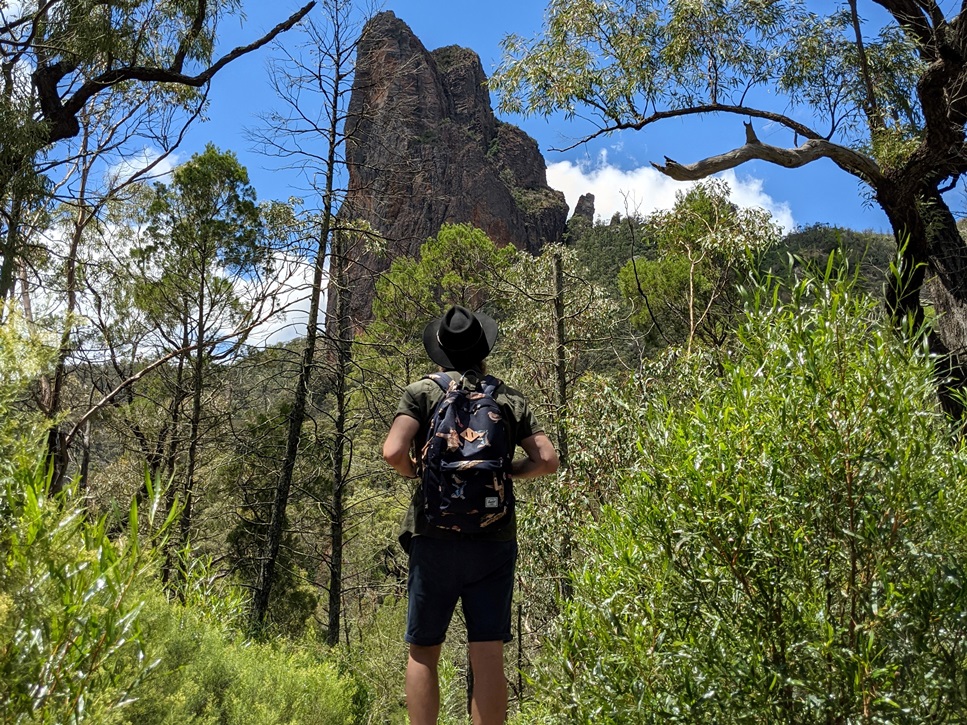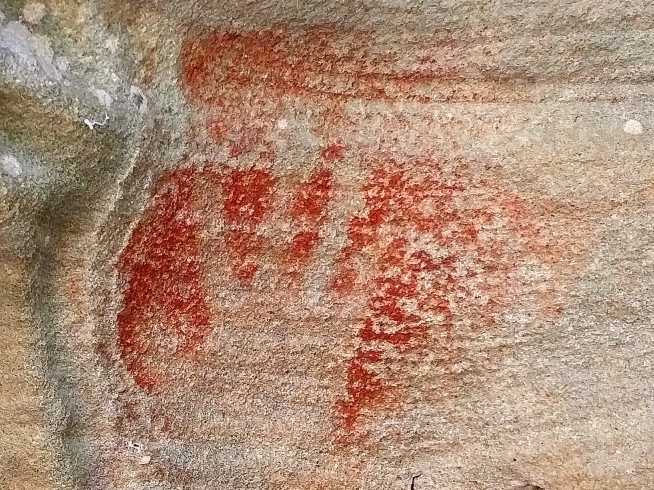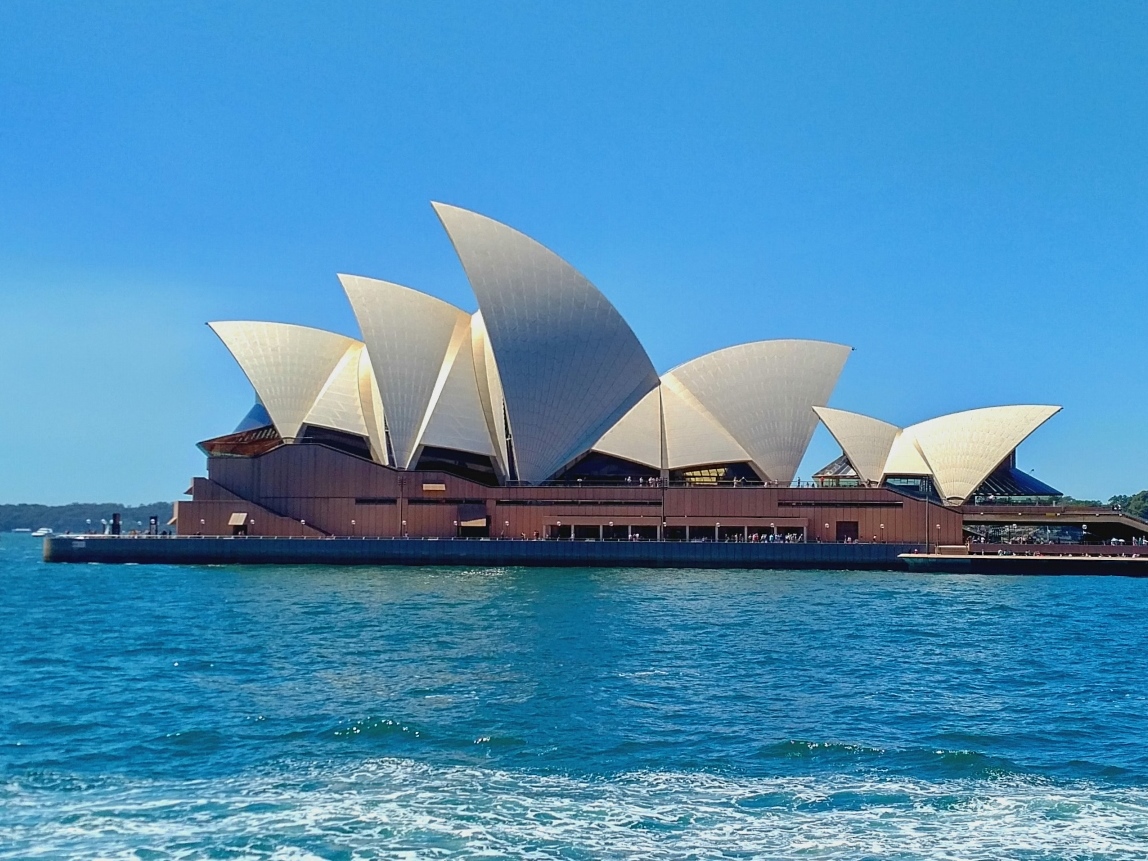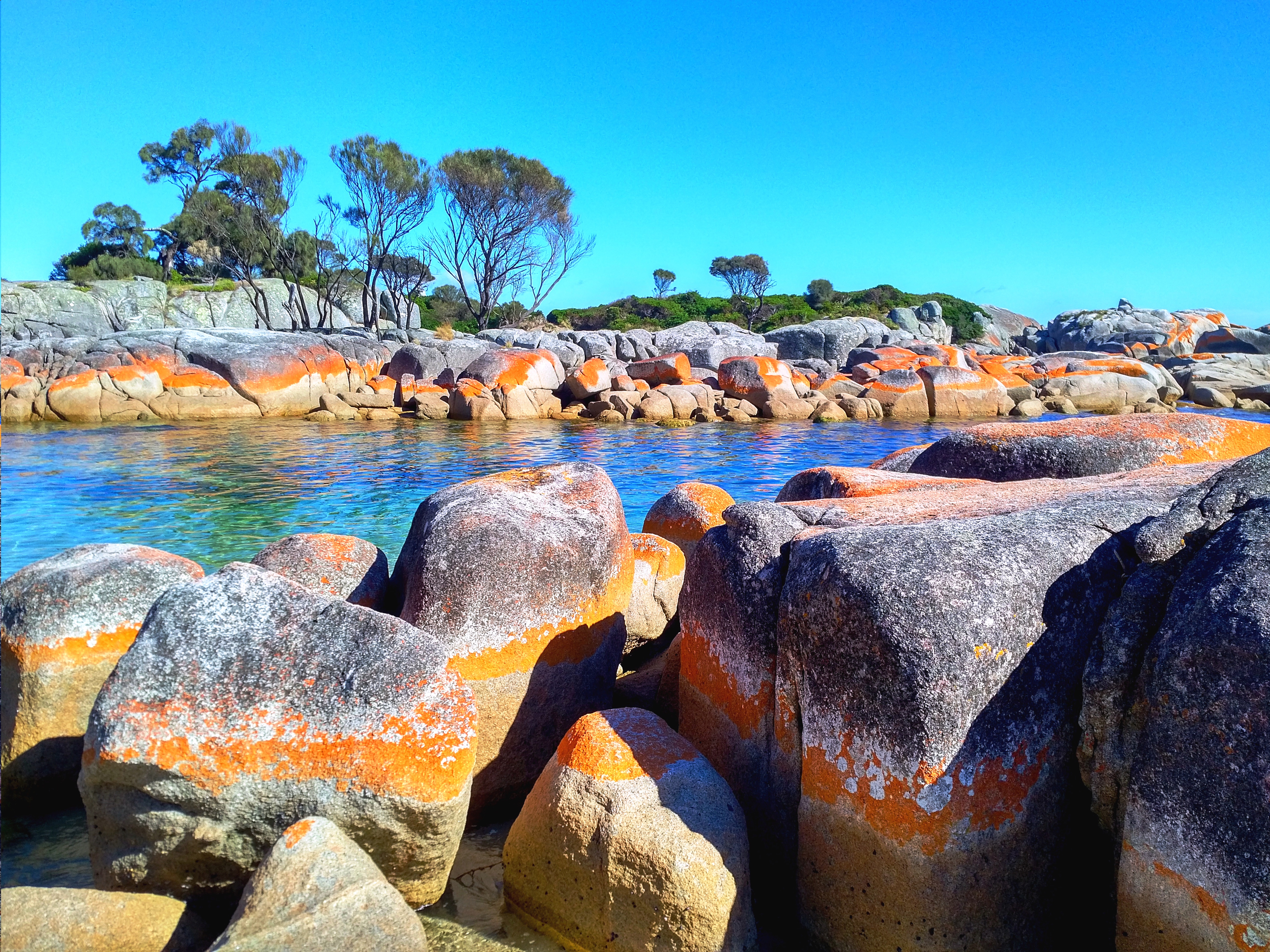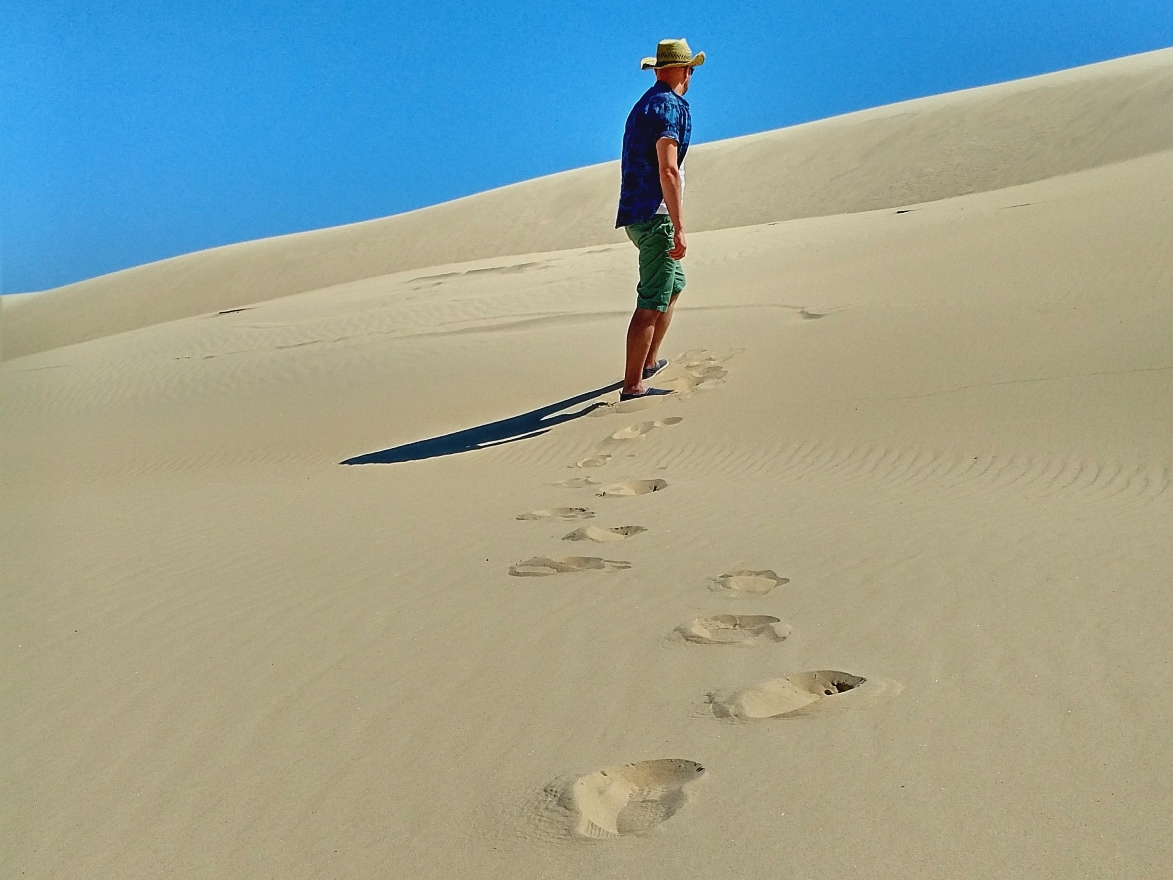
the australia blog
With the prospect of the next few decades stretching out before me like an uninspiring concrete pavement, I felt it was time to re-evaluate my life. It was now or never. And so, in 2016, after a gruelling bureaucratic process, I packed up my whole world and moved from a rain-soaked part of England to a giant sunburnt country in the bottom right-hand corner of the globe. The Australia Blog chronicles defining moments in my new life Down Under.
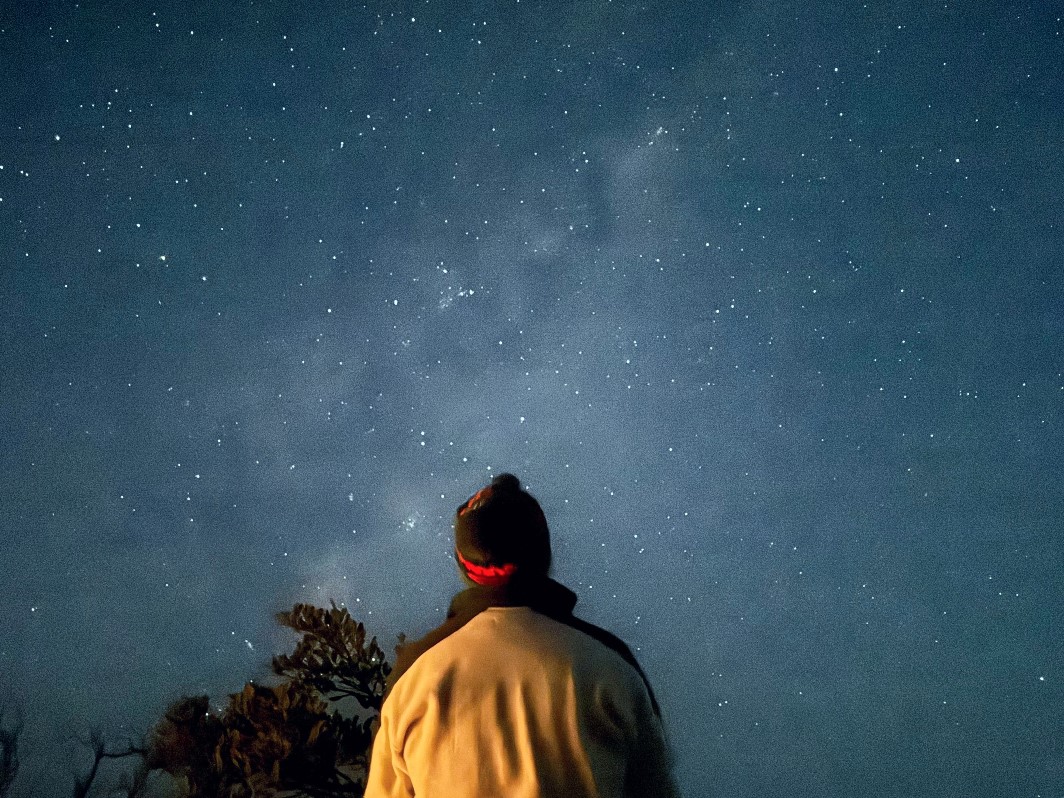
camping under the stars in bouddi national park
Posted 24th June 2025
This was an overnight camp in Bouddi National Park in the middle of the Australian winter. With our tent pitched and home made, we set about enjoying all the national park could offer, including beachscapes, a short hike to Box Head Lookout and gazing up at the stars on a wonderfully clear night. The gas camping stove was the perfect way to heat up some food and hot drinks.
coral sea adventures in queensland's whitsundays islands
Posted 15th June 2025
Tantalising glimpses of the island idyll that awaits you can be espied from onboard the plane as it begins its descent into Hamilton Island airport. Dark blue peaks of uninhabited islands rise like ice-cream dollops from the turquoisey waters of the Coral Sea. Outside of the sanitised resort area, it's quite possible to embrace the island's wilder side. Our first morning was an early 5am start with a sunrise hike up to Passage Peak, a 5 kilometre scramble through the darkness past Cane Toads, lawn-mowing Wallabies, skittering Possums and stinging trees, up to a lookout platform in the race to catch day breaking on the horizon. The sunrise on the day of our hike wasn't the starburst spectacular we'd hoped for, but its muted pastels of pinks and oranges casting an understated glow over dark islands dotted about in the sea was a worthy reward in its own right. With my tee-shirt daubed in large sweat patches from the ascent, we headed back down the peak to Catseye Bay. The sun had now risen in all its glory and, in doing so, illuminated some of the most beautiful paradisal scenery I have ever seen. Flashing golds of sun and sand held dialogue with rippling blue waters, moody isle landscapes on the horizon and vivid green palm trees. Later that day I would embark upon my maiden voyage as co-captain of a catamaran sailing the Coral Sea...

three days in the blue mountains
Posted 10th May 2025
This was a three-day stay in the Blue Mountains at Katoomba as the New South Wales autumn was in full swing. I stayed in my own room comprised of bunk beds looking out onto some scrub and eucalyptus trees and just a five-minute walk to Eagle Hawk Lookout, with its incredible views across the awesome dense forest of blue gum trees. I'd awake early enough to catch the sunrise over this magical spot, hot-footing it in my bleary-eyed state, more likely with a flask of coffee in hand than not, to enjoy day breaking alone - a chance to contemplate the day before the onslaught of duties and responsibilities ahead. On my final morning, the canyon was draped in a spectral low-lying mist (pictured). The undisputable highlight of my three days, two nights at Katoomba was my leading of a three-kilometre mini-hike down to Katoomba Falls and through well-trodden trails. Never before have I lead a hike of twenty one people and, with nothing more than Google Maps to get me through, it was a something of a relief to arrive back at camp all together, in one pievce and on time.

two icons, one night: seeing joanna lumley at the opera house
Posted 24th October 2024
This was a collision of two worlds, a night when my British world and my Australian world came together. A belated birthday present saw me sitting in the Opera House, the undisputed icon of Australia, watching Joanna Lumley, another undisputed icon and British national treature, during her 'Me and My Travels' show tour. I can't quite articulate the confluence of emotions which rise in an expat when such a wonderful and prominent figure from 'back home' arrives in a foreign land - but also your land, but not quite your land. It's akin to the warm feeling you might get when a dear old friend drops by but you know they'll be leaving very soon. I've seen many of Joanna Lumley's travel programmes, some more than once. Of course, this experience wasn't about travel; I didn't learn anything new about her adventures along the Silk Road or Russia. This was about being in the presence of an incredible woman and titan of Britishness; a British icon inside the icon of Australia. It was quite the combination.
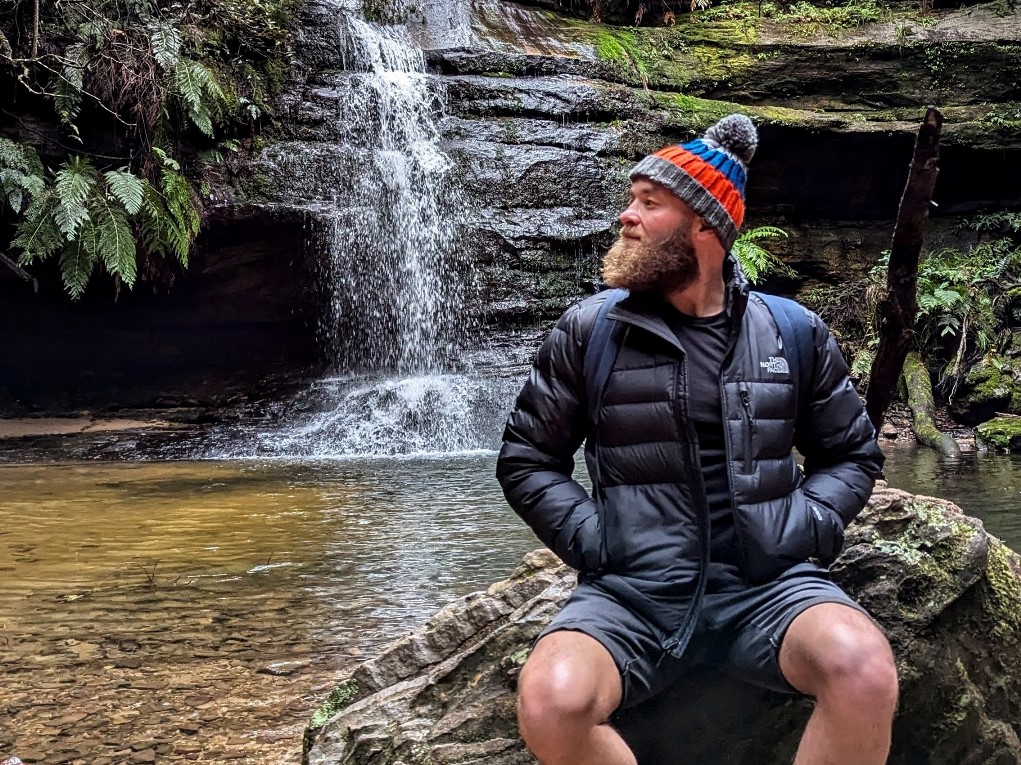
back to the blue mountains: hiking the grand cliff top walk
Posted 10th July 2024
This was a hike along the new 19km, 2-day walk in the Blue Mountains beginning at Wentworth Falls and finishing at Katoomba, with an overnight pause in the mountain town of Leura. All in all this was more like a 30km hike, covering 15km each day, with elevation gains of up to 595m on day one from Wentworth to Leura and 446m on day two from Leura to Katoomba. Low-lying cloud on the morning of day two was particularly evocative, throwing trees into dramatic misty silhouettes. This newly-constructed hiking trail links together a number of existing cliff top walks to create the "Grand" in Grand Cliff Top Walk, a trail which now runs along the entire escarpment uninterrupted. Having said that, it is winter and recent heavy rainfall meant there were a couple of landslides and diversions off the route and back up onto main roads. Still, it was lovely to be out of the city and back in the Blueys.
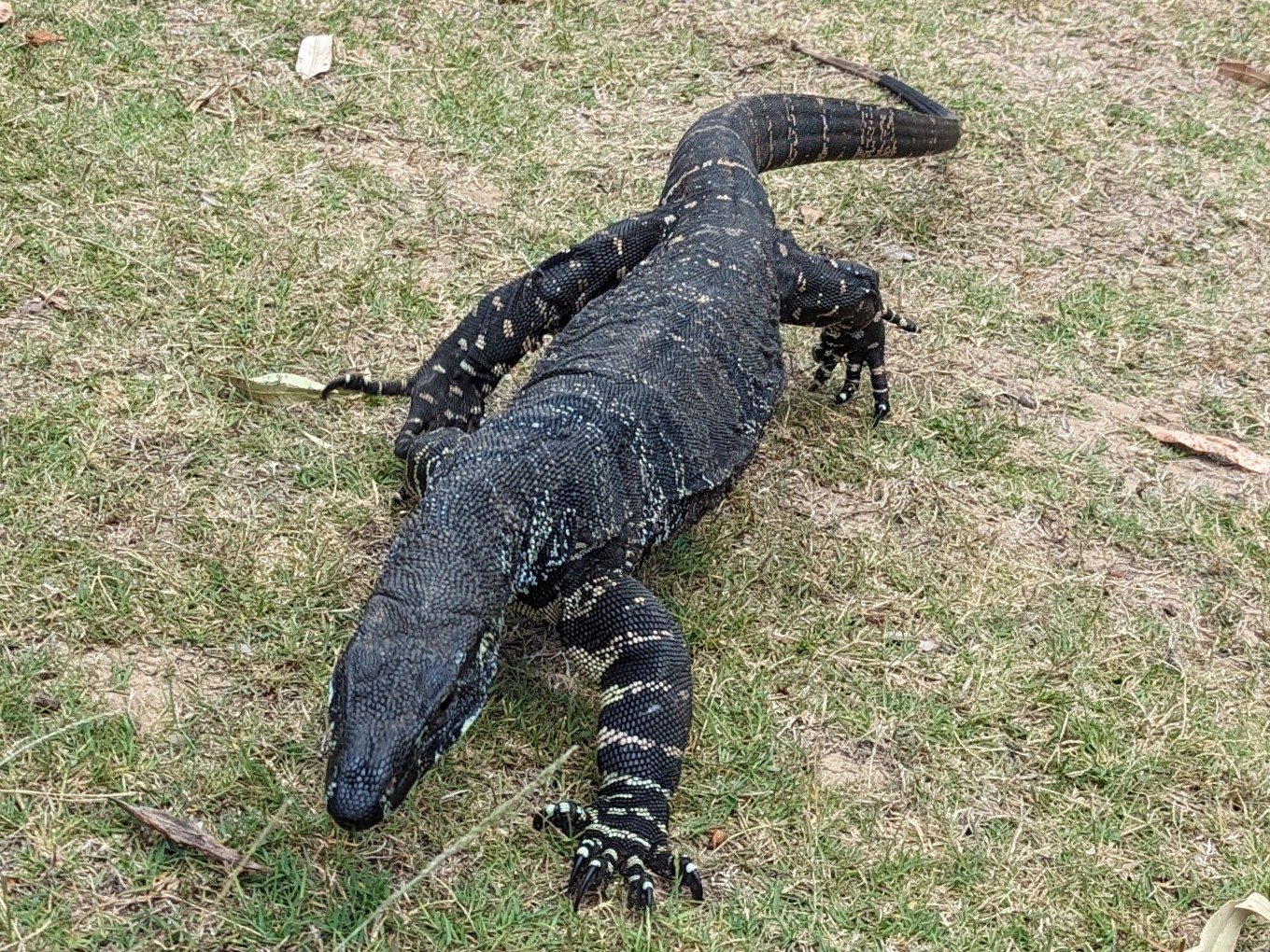
wild ku-ring-gai: goanna encounters of the awesome kind
Posted 18th December 2023
Ku-ring-gai is the national park close-ish to home that is my favourite; I'm almost guaranteed to see something wild there. This was a repeat bushwalk along the Basin Track down to the lagoon, a relatively leisurely saunter of 6.5kms return with steep gradient in parts. Half an hour into the walk a Swamp Wallaby emerged from the brush. Not particularly bothered by our presence, he hopped away in to the thicket only mildly irritated by the intrusion. The Basin Tracks ends down at the emerald-coloured waters of a lagoon. It's a popular overnight camping spot populated by scores of campers with tents. It's a beautiful place. I dared not hope to see any Goannas, my all-time favourite Aussie creature, for fear of disappointment. However, whenever I have come face-to-face with one, it has always been at Ku-ring-gai. Within seconds of arriving at The Basin I spotted a Goanna and, a minute later, several others. The place was teeming with them - their numbers swelled, no doubt, by the promise of food from campers sharing the space. One Goanna took to investigating some camping bags, a couple having left them unattended, soon skulking off with something that he obviously took a liking to. The couple returned minutes later oblivious that a cheeky Goanna had been rifling through their things and had made his getaway with something. One Goanna approached me head-on as I filmed it, the last two metres between me and him becoming a full on charge which had me running and screaming. We rolled out the picnic blanket at a spot under the tress and along lagoon bank, enjoying a coffee from a nearby vending machine. A quick change of clothes under a towel (it's an Aussie skill I have mastered over the last seven years) allowed a quick and obligatory dip in the lagoon's warm waters before making the return journey to the car.
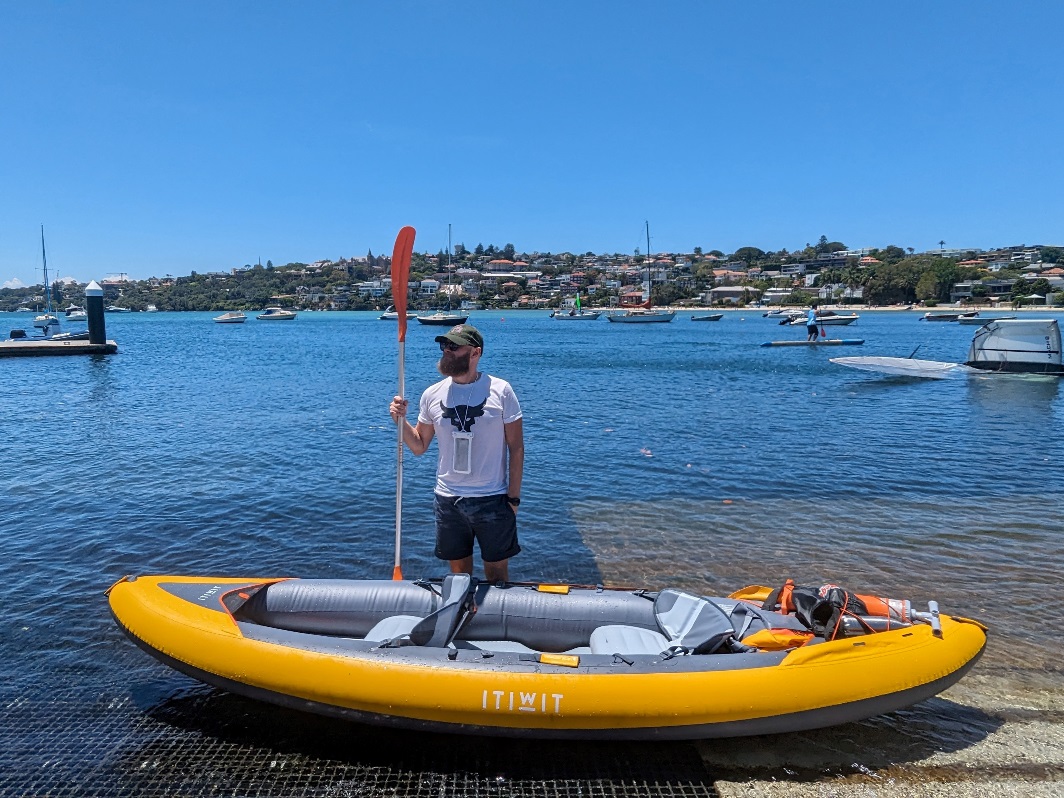
new inflatable kayak adventures: glebe to barangaroo & rose bay
Posted 9th September & 3rd December 2023
Each time we head out on her, we set our sights on furrowing the harbour waters someplace new. Our maiden voyage was a simple paddle around Blackwattle Bay - a chance to get used to the challenges of inflating her, paddling in her and trying to get her back into her carry case. A fortnight later we headed much further afield. Beginning in Blackwattle Bay we kayaked the bumpy waters of Sydney Harbour as far as Barangaroo, stopping in Pyrmont for a coffee. An old cable grip from my former life back in England acted as the perfect 'anchor' for tying her to the rail. Arriving at a coffee shop by kayak felt pretty cool, as did watching scores of moon jellyfish bob alongside en-route. Our third trip was different again, driving to Rose Bay and spending a couple of hours kayaking towards Watson's Bay. The waters were incredibly bumpy, no less so because of passing speed boats and sea planes. Hermit Beach, a tiny cove along the route, was a cute spot to pull our inflatable onto land, rest up and snack.

inflatable kayak adventures: the maiden voyage
Posted 27th August 2023
I've written before about how my move to Australia has catalysed, nay necessitated, a slow but steady investment in outdoorsy gear. It started at the entry level with the purchase of shorts (I didn't own many; little requirement for such sartorial shortness in north west England), prescription sunglasses and caps and hats of all varieties, including the Grandaddy of them all - an iconic Aussie Akubra. It progressed to stripey beach towels and parasols, a pair of decent hike boots, backpack, picnic mat, camping bowls, plates and flasks, swimming trunks, goggles and waterproof ear plugs, tennis racket and balls… You get the picture, right? And now…
Recently I became the proud (and long-awaited) owner of an inflatable kayak. We've rented kayaks a few times now and, like almost everything else in Australia, it's expensive. So, at the very least, it made financial sense to invest in one. Even better, my latest adventure toy was actually a present. Within 24 hours of owning her, she lay inflated on a jetty and was taken on her first voyage. We chose Blackwattle Bay for our first trip, a bay in Sydney’s Inner West we know well and where we’ve kayaked before. The weather wasn’t the best; steely grey skies belied the strong UV rays of the Aussie sun. Nevertheless, the excitement was too much to hold off for another weekend.
I’m looking forward to taking her to other Sydney bays in the coming months. I’m planning a few sunrise paddles, taking a flask of coffee with me to warm away the early morning chills.
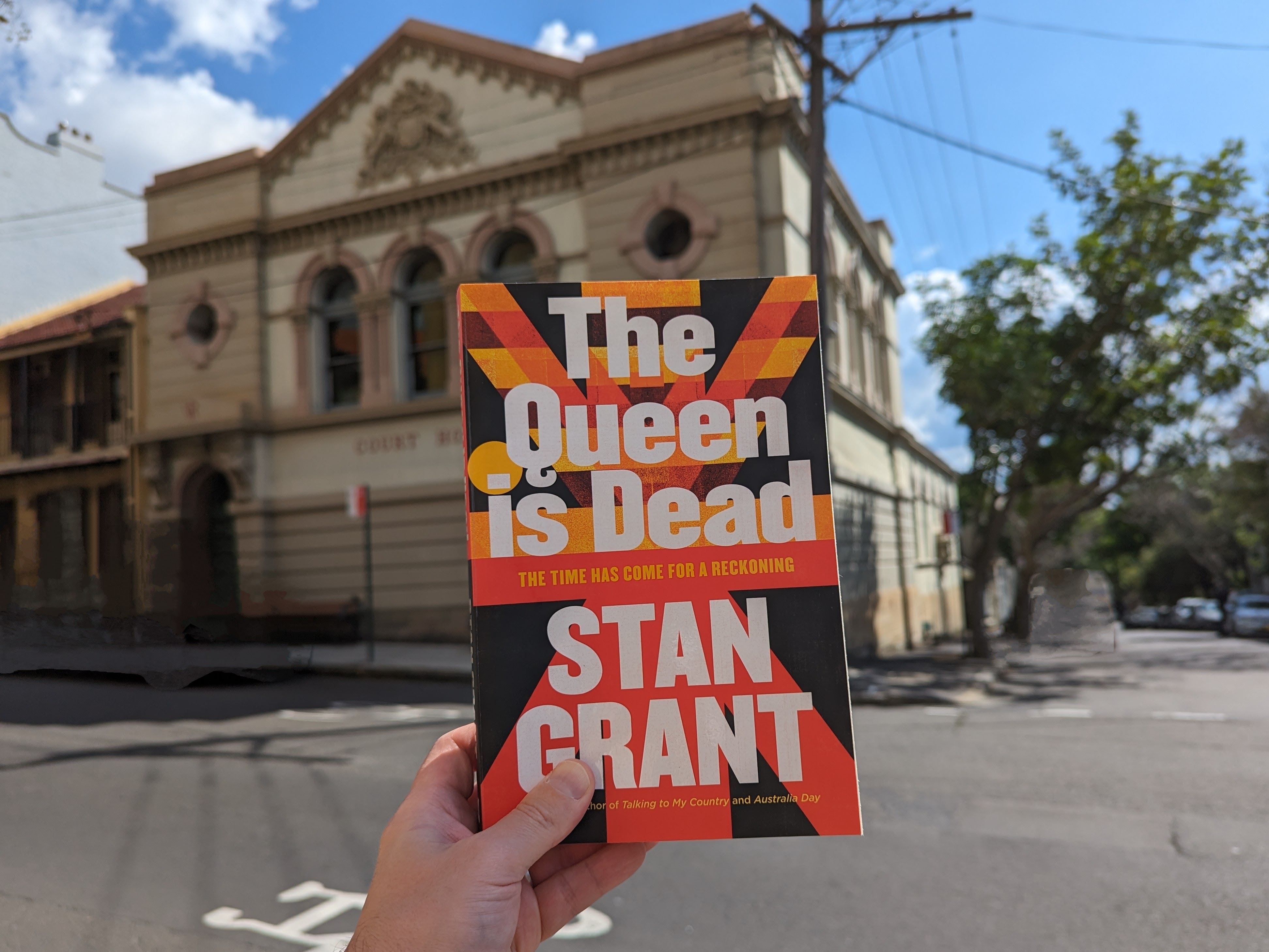
stan grant: meeting my aussie hero
Posted 3rd June 2023
It’s not every day that fortune has you cross paths with one of your heroes - let alone twice. The first time was in a bookshop back in March. I was far too embarrassed to introduce myself and be ‘one of those people’, so I just admired, likely my jaw open wide, from a very short distance (it is a small, intimate bookshop). I later berated myself that I let this chance pass me by and promised myself that, if ever the opportunity were to arise again, I owed it to myself to act.
I have followed Stan Grant, metaphorically speaking, ever since arriving in Australia. I have a special connection to this Indigenous Wiradjuri man; his IQ2 speech on racism in Australia formed the basis of my first ever lesson observation. I got the job and feel I owe, in part, my success to Grant’s rich use of the English language - an English teacher’s dream. His speech made my job easy. Every word is dripping in intensity and passion - it is guttural, heavy, weighty. His speech got me my first job in Oz, helping me to realise my own Australian Dream. Indeed, the resonance of his speech, which was itself about the Australian Dream, is not lost on me - it’s one of those moments of synchronicity and connectedness that continue to add meaning and a sense of direction in my life.
Grant is indisputably one of the most important voices in contemporary Australia. Indeed, his is a voice which endeavours to elevate the level of discourse in this country from its depressingly low, default position. He is everything from an activist to a political commentator, from a TV presenter on Australia’s ABC to a prolific writer.
I have all of his books on my shelf. One in particular stopped me in my tracks. 'Talking to My Country' was so stomach-churning in its depictions of colonial mistreatment of First Nations peoples that I had to put the book down. I stopped reading at Page 13 of all pages. This particular page detailed how British settlers establishing their first homestead deliberately poisoned creeks on the land knowing that First Nations folk drank from them. These land thieves, hailing from the so-called ‘civilised’ world, left Indigenous bodies out to rot in the sun as a warning to others to leave the land. I hope to pick the book up from its sedentary position on the shelf when I’ve finally mustered the courage to continue onto Page 14...
I saw Grant heading directly towards me. I was on my way to my local swimming pool, my earphones in and backpack on. I began to slow my pace and removed my earphones one at a time; a steady, concerted signal to my hero that I may not be walking on by. We spoke for a minute or two, during which I said that I’d seen him previously but was too embarrassed to introduce myself. His eyes were bloodshot for this is a man who lives in a world of weighty socio-political issues: racism, injustice, colonial legacy, bridging the gap, the stolen generation… This is a man carrying the weight of Australia's dark history on his shoulders. We chatted freely for a couple of minutes (it's so difficult to judge time at moments such as these). He took particular interest when I told him I was a teacher and had used his speeches in my classes. I also told him about Page 13. I apologised for the recent racism he had experienced from ‘fellow’ Australians which were the main reason for his standing down from a political discussion programme on ABC TV. He asked my name and where I worked, which was a nice touch I felt, before we parted and went our separate ways. I didn’t dare ask for a photograph with him - this meeting was far too special for that.
I hope you appreciate the image which accompanies this post: the symbolic foregrounding of the Indigenous voice represented by Grant’s latest book set against a blurry old colonial Courthouse.
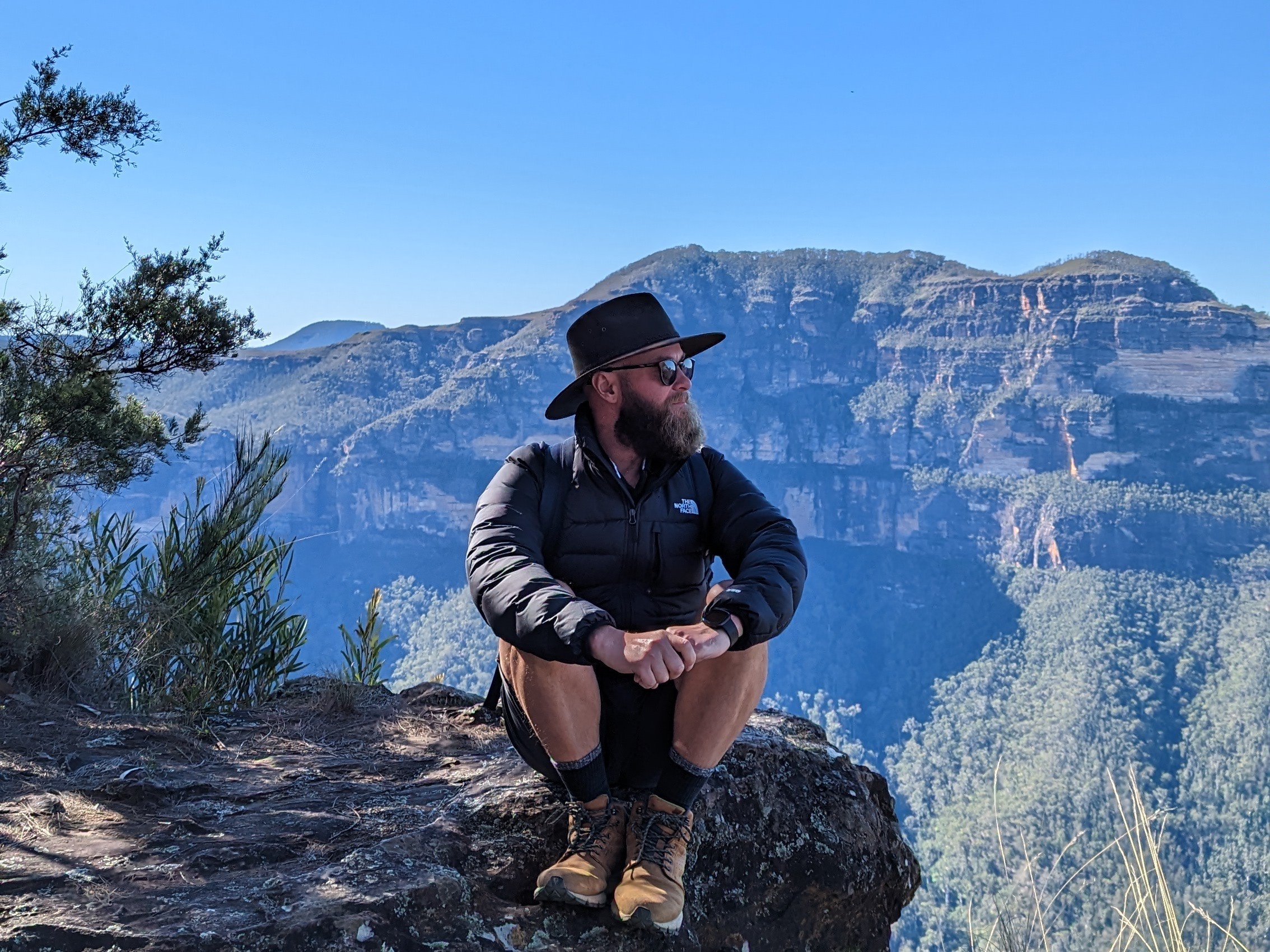
back to the blueys: perrys lookdown to blue gum forest
Posted 28th May 2023
This was a long overdue trip out to the Blue Mountains. It always feels a bit special heading out this way; it's just far west enough to help you feel that Sydney no longer exists, the weather changes to fresh and cool and the landscape morphs from flat to dramatic and rugged. Our list of Blue Mountain bushwalks yet to be experienced is dwindling fast. Over seven years we've ticked off a fair few of the walks able to be completed on a day's visit, excluding those too short enough to be worthwhile. Perrys Lookdown to Blue Gum Forest was billed as a 2.5km, 5km return, hike down a steep cliffside with the words "very steep" and "Grade hard" on the NSW Parks board at the entrance to the hike. In reality, 2.5km was more like 3.8kms when tracked accurately by an app. It's not the first time I've found the distance details on the park boards in Australia to be fileable under 'Myths and Legends'. As it was, we hiked 3.8km down to the forest floor with a knee-crunching elevation drop of 630m. A short picnic in a clearing was a chance to take a break and rest before a pretty arduous ascent of 630m back the way we had come. This was a really good hike; it had the perfect balance of being strenuous enough matched with a cool mountain breeze and awesome mountain views. It wasn't too busy either - always a bonus in my book.

...and the state election makes all three
Posted 1st April 2023
Last Saturday I got to exercise one of my Australian Citizenship rights for the third time since I became a you-can't-get-rid-of-me-now citizen back in 2021: I voted. This was the New South Wales State Election. Having first voted in the Sydney Council Elections, then the Federal Election, this State Election makes all three - a clean sweep. I chose my local town hall, built during the Victorian Colonial era, as the place to cast my vote. This meant that I was a British-Australian voting in an Australian election in a British building. There's a certain satisfying poetry in that. My next opportunity to exercise my voting rights? The upcoming Referendum on amending the Australian Constitution to allow Aboriginal and Torres Strait Islander peoples a Voice in parliament. The wording for the Referendum question has been decided. It will read, "A Proposed Law: to alter the Constitution to recognise the First Peoples of Australia by establishing an Aboriginal and Torres Strait Islander Voice. Do you approve this proposed alteration?" Of course, I'll be voting YES.
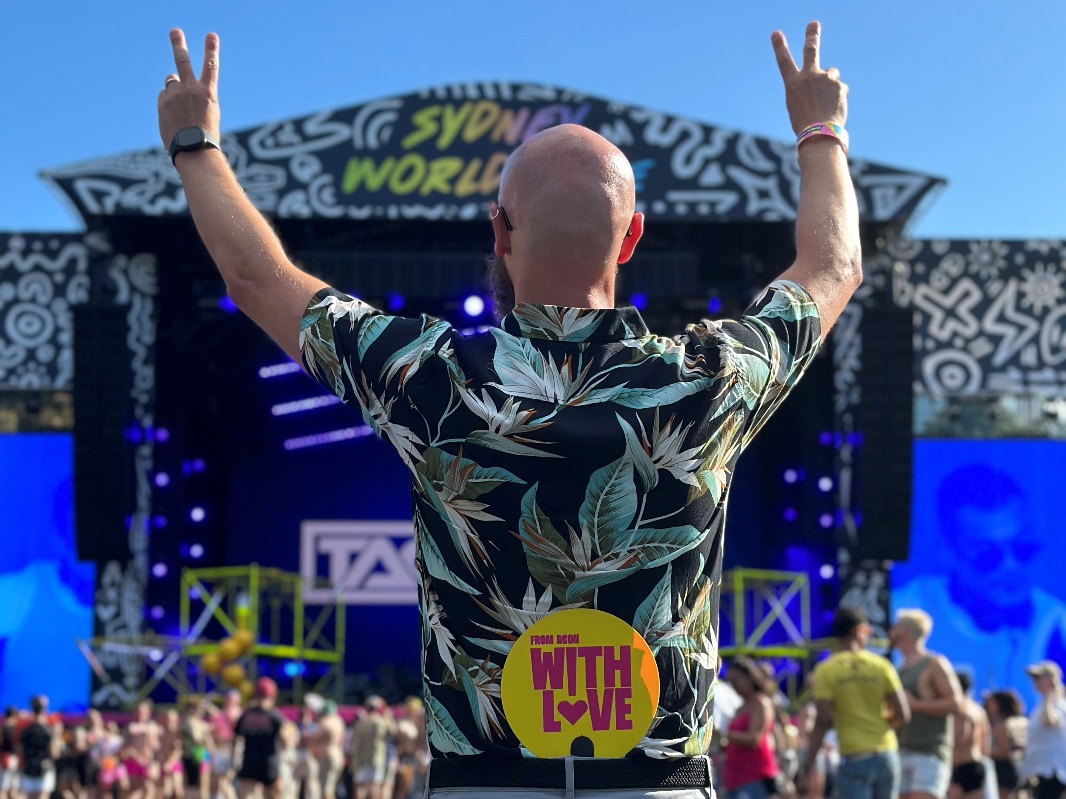
with love: when world pride came to sydney
Posted 5th March 2023
All good things must come to an end. I know, it's a cliche but today, Mardi Gras and WorldPride did precisely that. This was three weeks when the LGBTQIA+ world (and its allies) cast its gaze (or should that be 'gays'?) toward Sydney, Australia - 17 days of technicolour diversity and billed by organisers as a "party with a purpose". The lighting up of the Sydney Opera House in the colours of the Progressive Pride flag was just gorgeous, signalling to me, and the world, a more progressive, forward-looking Australia.
We were woefully under-prepared and had booked nothing in advance. This meant that we paid more for some things and missed out on others. Despite the short-sightedness, this turned out to be a truly awesome time and one that had me reflecting upon how much I had missed being with people like me. The WorldPride Fair Day kicked things off; a multi-coloured rainbow mooch around stalls and performances in Victoria Park, Camperdown. I could have wandered around the park for hours; I'd slipped into a sort of pink haze daze brought on by the smiles and the joy and the knowing acceptance in a thousand glances. It wasn't long before I was dancing in a field despite the afternoon’s intense humidity. I'd have stayed for longer had my face not begun to burn in the harsh UV of a Sydney summer’s day.
The following week was a somewhat aborted attempt to see the floats of the Mardi Gras Parade and the first parade in which an Australian Prime Minister had marched alongside the Rainbow Community. The crowds, and being involved in an unsettling crushing incident on the corner of Taylor Square, had us retreating to a nearby quiet street and an Italian restaurant. Still, it was nice to soak up the atmosphere for a few hours. The next day was a snap decision to go to the Domain Dance Party (pictured above) with the intention of trying to make up for the previous day. Fuelled by nothing more than a few soft drinks, we danced from mid-afternoon until dark. Impending work commitments the following day had me leaving sooner than I would have liked but I didn't mind too much; my heart full of the kind of warmth that only comes from knowing you’ve had the best of times.
And so to yesterday, and a late afternoon visit to Oxtravaganza Street Festival. Heading to the closed-off area with the best music, we got chatting to one of the drag artists who, it turned out, had grown up in a district of London neighbouring mine. I’m constantly struck by just how small world, eh?
As I write this, the rainbow that has made me feel and realise so much this past few weeks is fading fast. I'm sad about that, but I know I'll carry its rainbows wherever I go.
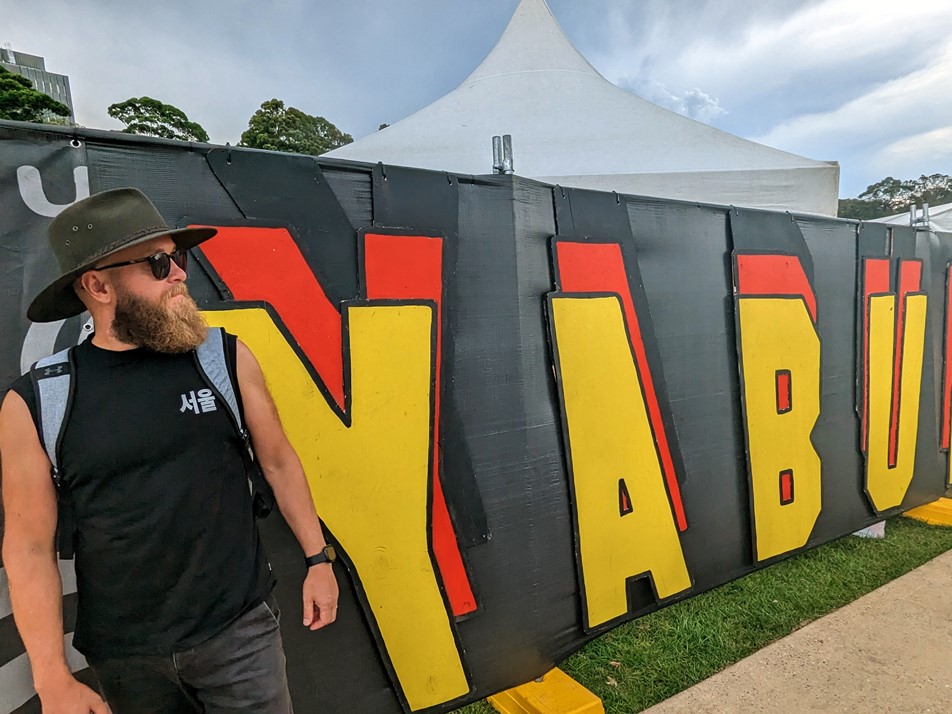
january 26th: yabun festival
Posted 26th January 2023
After a morning of sunning myself on one of Sydney’s gorgeous beaches on this most controversial of Australian days, it was time to hand the afternoon over to something more authentic and meaningful: the Yabun Festival at Victoria Park - a celebration of First Nations culture.
On January 26th each year, I try to show my support for Indigenous peoples of this land by being present with them. At Yabun, the largest one day gathering and recognition of Aboriginal and Torres Strait Islander cultures in Australia, the following moment struck me.
I was sat on the grass watching the performance on stage and generally soaking up the atmosphere.
A small Indigenous girl, no more than a year old or two (I'm not so great at guessing children's ages when they're so young) was sat in front of me. She was doing what every kid does when they're sat on the grass: pick long strands of green - just the thing I did/still do when I'm sitting on the grass. It's something we never seem to grow out of. She was a cute, delightful little sweetheart. Her daddy hoisted her up and gave her a cuddle. I could have cuddled her myself too to be honest. Scooped her up in my arms but, well, she's not my kid.
A thought intruded. This thought was inevitable. The cute moment quickly dissolved. I thought about the battles this little girl has ahead of her, how her opportunities, experiences and life's journey will likely be shaped and determined by the colour of her skin.
And that's not right. It broke my heart.
Australia must do better. For all our sakes.

wollongong: hiking mount kembla
Posted 22nd January 2023
This was a trip down to Wollongong (often affectionately referred to as 'the Gong') to escape the metaphorical and literal confines of Sydney city and its national parks nearby - all of which I have been to at least twice now. Initially planning to undertake the Mount Kembla Ring Track in the Illawarra Escarpment State Conservation Area (to give it its full title), on arrival the signage pointing to Mount Kembla Summit Track sounded far more adventurous and enticing; who doesn’t like a summit with the promise of a view at the end – the ultimate hiker's reward? We were seasoned hikers, after all!
Within minutes things started to go a little awry. That’s the thing about bushwalking in Australia (and, likely, in any other country for that matter): head into a hike with conceit and undue confidence, and the bush will bite you back hard - mostly metaphorically but sometimes literally too. Within minutes of starting the ascent I spotted my ultimate hiking nemesis: a leech was pole-vaulting itself around my boot. I have previous with these guys. Back in Queensland, on my ascent up Mount Solitary in the world’s oldest tropical rainforest, a few of these vampires made their way up my boots, through my hike socks and satiated themselves on my blood for some time before I felt a stinging sensation and decided to pull back my socks, only to be confronted by a bloody mess with three of the black things clamped to my ankles. They are horrible things and, naively, I was not expecting to be confronted by them so soon again – especially in New South Wales. This discovery had me on edge for the rest of the hike. Then my hiking buddy slipped, breaking his phone and grazing both legs and bruising both wrists. All we needed now was a snake to cross our paths. Thankfully the latter made an appearance only in my imagination and not on the ground.
In relation to other hikes this was a mere tiddler: 5.3km with an elevation gain of 190 metres to 534 metres so, as they say here in Australia, it was in no way a “doozie” – but it still bit us hard in spite of our hiking experience.
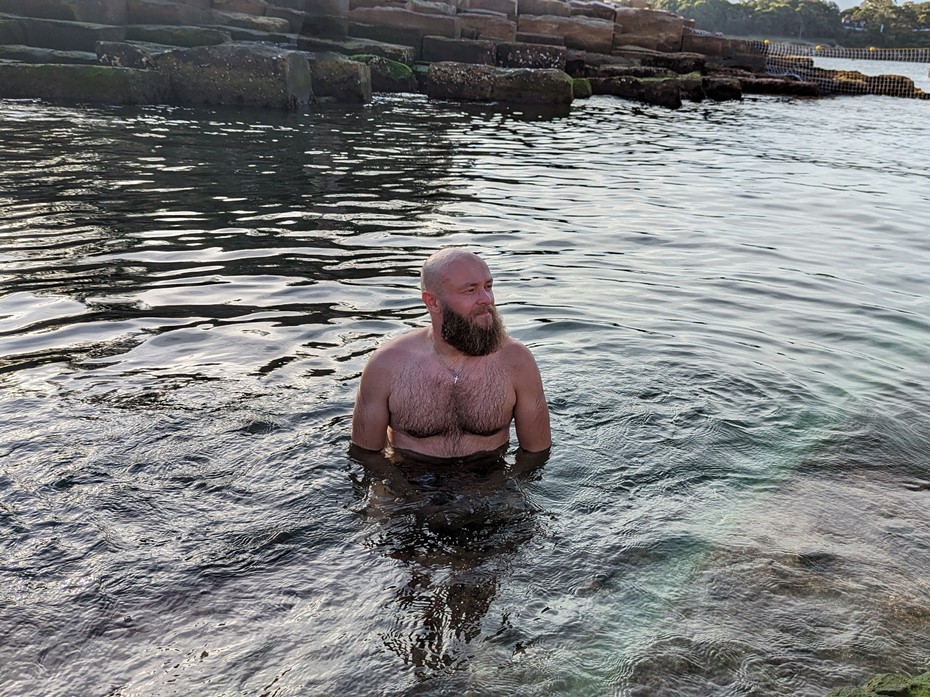
harbour swimming at marrinawi cove
Posted 14th January 2023
This week Sydney's newest outdoor pool, overlooked by the giant steel arches of the Harbour Bridge at Barangaroo, opened to much fanfare. It's the first new public outdoor pool to open in half a century. Marrinawi Cove was a chance to do something with a pretty uneventful and downbeat day.
Catching the 18:11 Glebe to Barangaroo ferry in the nick of time, we were soon furrowing the Harbour's waters just as the sun was turning to an intense and heavy orange. It always feels like a bit of a treat to jump onto a Sydney ferry and plough the waters of the harbour in search of a little adventure.
Marrinawi Cove is a small inlet on Barangaroo Reserve, cordoned off at one end by shark nets. The large rectangular sandstone blocks which make up the reserve's shoreline were pop-marked by the serrated edges of oyster shells and, when combined with the harbour's slippery seaweed and algae, it is fair to say that my clamber down into the water felt like it was on the wrong side of risky. Note to self: next time, bring rock shoes. The water was cold, felt thick and heavy and came with a distinctly eggy odour. The strands of seaweed on the Cove's bottom stroked and tickled the palms of my feet - a little disconcerting as I have an innate distrust of anything on the sea floor that I cannot see (I have unfortunate encounters with sharp coral, sea urchins and jellfish in Fiji, Vanuatu and Philipines to thank for this trepidation). That said, I wouldn't let an opportunity to try something new pass me by.
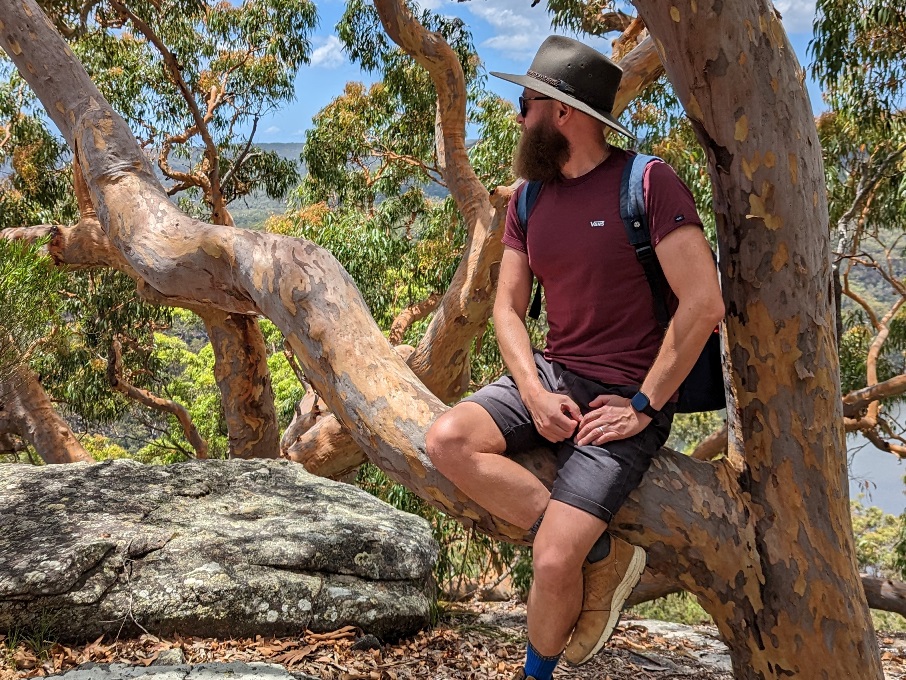
operation restoration: return to marramarra
Posted 9th January 2023
This was an 11 kilometre bushwalk in Marramarra National Park from Coba Ridge to Collingridge Point along a stretch of the evocatively-named Neverfail Fire Trail. This humid hike to the gorgeous view of Berowra Waters (the perfect spot for a picnic on the rocks) was my third visit to Marramarra. It was good to be back in the bush after a hiking hiatus of many months, huffing and puffing among the birds, bushland, broken tracks and all things ancient - a somewhat restorative experience following my visit to the United Kingdom over Christmas - an experience predominantly comprised of rowdy airports, claustrophobic airplanes, urban environments and inclement weather.
As night is sure to follow day, I did not escape an Australian national park without encountering a snake. Having not come across any for years, to the extent where I was beginning to think they were mythical beasts rather than actual beasts, I now seem to cross paths with at least one on every bushwalk I care to go on. This time it was the turn of a large Red-Bellied Black Snake, whose tail took to slitering off into the brush as we approached. As is often the case, the snake saw/sensed us before we did it and calmly made its way off the main track, the bracken and twigs crunching under the weight of its black body. As is invariably the case after a snake sighting, every twig and shadow on the track became a potential serpent in my mind and, as is invariably the case, I was pleased to be back in the snake-free zone of the air-conditioned car. Marramarra was about as far, geographically and in all other senses, as it was possible to get from the Thames Estuary in south east England where I had spent Christmas and New Year. Operation Restoration: complete.

locked into the past
Posted 4th November 2022
I find it really striking that my house, built in the 1860s, pre-dates the formation ("Federation") of Australia. It was only this week that I noticed a small metal disk (pictured) riveted to the old balcony door lock in the master bedroom. The doors and the lock, which comes with an abnormally-sized key like something out of a Victorian gaol, dates back to the construction of the house. Upon closer inspection, it becomes clear that the lock was made by a company based in Wolverhampton, a town in England's West Midlands. My bedroom, in a district of Sydney, Australia's most populous city, feels about as far away from Wolverhampton as it is possible to get. Indeed, the lock may as well have been made by a company based on the Moon - it's about as relevant. This little gold circle of metal is a reminder of how Britain exported itself through colonialism and conquest, stole lands and killed many. Its presence in my bedroom is incongruous and, frankly, completely bizarre. In fact, it feels like it doesn't belong here.
And that's because it doesn't.

buying my first house in australia
Posted 31st August 2022
This post represents the final stage in my emigration to Australia. The owning of a home was one of the biggest sacrifices of emigrating. For the last six and a half years we have been in rental accommodation. Don't get me wrong; we've certainly been lucky, all things considered. However, I've always felt in limbo, stuck somewhere between just passing through and real permanence. I have become increasingly frustrated at the cramped space, the inability to decorate and take ownership of a place in the way that I wanted to, as well as the general irritation with the idiosyncrasies of the house (having to open the kitchen cupboard door in order to open the oven, the monthly bleaching of the bathroom ceiling to kill the spawning mould, to name but two). When the kitchen ceiling collapsed because of heavy rain, our days in Pyrmont were clearly numbered.
A depressed housing market, brought on by the Australian Reserve Bank hiking interest rates because of high inflation, meant that it was simultaneously the best and worst time to buy a house. I have always despised the auction element of the house-buying market in Australia; it’s repulsive and exploitative. Jittery vendors were now keen to avoid the auction format altogether and were opting for the ‘placing an offer’ method instead. Indeed, approximately half of all houses going to auction around this time were failing to find a buyer. Suddenly those selling property in one of the most over-heated markets in the world were now not having it all their own way.
And so, one Saturday morning we headed over to a property in Glebe, a neighbouring district and one I know well. I took a heightened sense of cynicism and my general dislike for Real Estate Agents with me. My heart was not really in the search. I wandered around the property aimlessly looking at the blank white walls and refusing to engage in the agent’s generic spiel. I wasn’t to know it at the time but, less than a fortnight later, I would be signing on the dotted line. Five weeks later we’d be moving in. There was just enough time to partially recover from Covid-19 before the task of moving home was to commence. Discombobulated from illness and psychologically ill-prepared to change homes (the whole thing having happened so quickly), our lives quickly became ones dominated by hiring vans, cleaning cupboards and carrying boxes. The home we had carefully and lovingly constructed over six and a half years was now being dismantled. As soon as we started emptying the place, my heart left and I knew it was the right time to move on.
As we shifted our worldly belongings from one district to the next, repeatedly crossing the waters of Blackwattle Bay in our hire van, I was struck by just how much everything we owned fitted the new house beautifully; there just seemed to be the perfect place for everything. Our furniture slipped in with ease. It was like it was always meant to be there. The spaciousness of our new home meant our belongings could breathe or, in other ways, found new life.
My demonym has now changed. I’m no longer a Pyrmonster but an Inner Westie or Glebe-ite. It brings to a close that which has troubled me ever since I arrived on these sun-drenched shores: not having a place to call home. I am a citizen of Australia and now I have a home. I think that makes Project Emigration Status: Complete.

bushwalking in uloola swamp: a poem
Posted 13th July 2022
It's been quite some time since I was last out getting lost in the Aussie Bush. A run of terrible weather and the general manic nature of daily life combined to make hiking in the Aussie bush something I was only able to think about rather than do. As it was, we managed to find a trail that was (a) not closed due to lanslides and (b) we hadn't completed before. Enter stage left, the 14 kilometre hike to Uloola Falls in the Royal National Park. Heavy rains of late ensured this was, in many parts, less of a hike and more of a paddle. Still, this was a strenuous enough trail to blow away a few cobwebs and beautiful enough to restore the soul from the toxic plasticity of the city. The wonderful Uloola Falls was the perfect spot to crack open the Thermos, roll out the picnic blanket, and enjoy lunch. We were interrupted once only by a lonely hiker who gawped at the Falls, bid us g'day and left as quickly as he'd arrived. I'm not a writer of poetry but, a couple of days later I wrote this poem about Uloola.
...................................................................................
ULOOLA
I came to you burdened by the weight of the city
Carrying my anger in a grimace stretched taut across my face
My back of rigid steel
neck of cracking concrete
mindset of black glass.
The city's inside me.
I need it out.
You've seen people like me before haven't you?
Your swampy magic sucks at my boots leeching vexations at every playful squelch;
Your wispy grasses a sea of gentle welcomes wafting away my city cynicisms with their dry melody;
Your stern boulders shouldering me with their ancient wisdom of knowing: "It's okay", you whisper;
Your fallen trunks, resting, a climbing frame proffering the chance of boyhood adventure.
I clamber and the smile in my soul stretches across my face and across the sky.
Boy again.
winter hiking in the australian capital territory
Posted 12th June 2022
A three-day weekend is an opportunity to travel just that a little bit further afield, an opportunity to escape your usual stomping grounds and, even, stay overnight! It had been over four years since my last visit to the Australian Capital Territory. Bracing ourselves for a freezing hike, all the time factoring in the wind chill, we packed accordingly and followed the age-old adage of the hiker: layers. We also made sure that we brewed a steaming hot coffee, flasking it in the Thermos for deployment later on in the day - probably somewhere appropriately cold and windswept. Our hike destination for the day would be the Corin Hub to Square Rock hike, a pleasant 11 kilometres with an elevation gain of just over 300 metres. I could never have anticipated that, a third of the way in to the walk, we would come across the white stuff. Snow isn't something one readily associates with Australia; images which spring to mind are those of dusty red landscapes, bush fires, tumbleweeds and Outback desert towns. And this speaks to the beauty of Australia: its landscapes and climate are unbelievably varied. The further we climbed, the more snow appeared - and the muddier it got on the trail itself. Daylight became increasingly subdued and the shards of sunlight which had lit up the forest became less intense. We reached Square Rock, climbing the last few metres up a steel ladder to an uninterrupted view out across the Australian bush, some 1400 metres up. We soon took to sheltering in a cave to get out of the path of the mean winds which were howling around the top of the mountain. We had just enough in us to tolerate around ten minutes at the top, serving up the coffee from the flask. The food would have to wait; it was just too cold and the winds too fierce and vicious. Layers, which had been shed on the ascent, were now hurriedly put back on. The descent was fast-paced; daytime colour was slipping into hues of greys and blacks and temperatures were dropping even quicker.
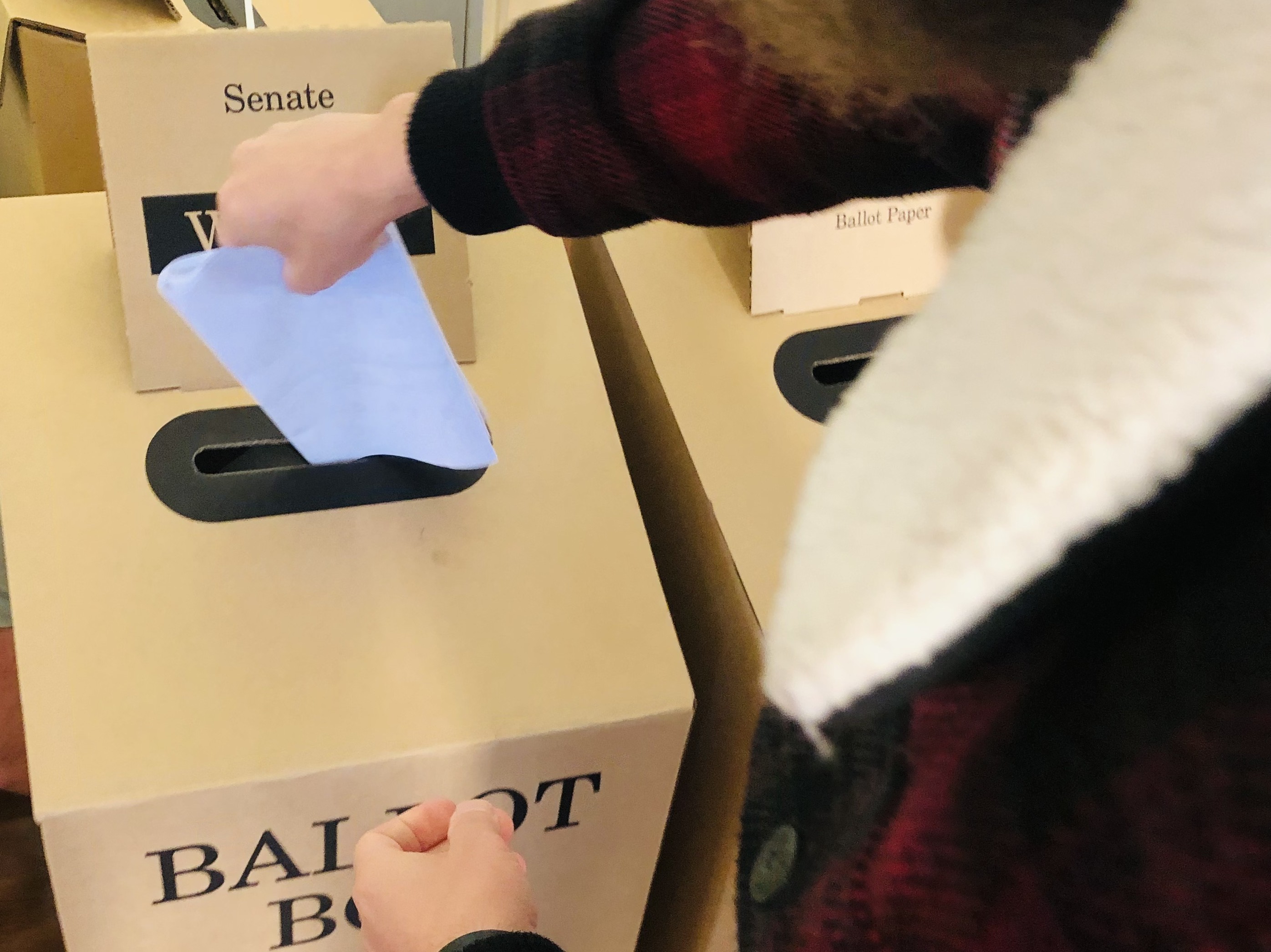
casting my first federal vote as an aussie citizen
Posted 28th May 2022
Saturday 21st of May was a big day in the life of a new citizen of Australia: me. It was my first opportunity to vote in a Federal Election having witnessed, over the last six and a half years, the toxic politics at federal level play out. Now it was my chance to have a say. It was entirely appropriate that I voted in the local community centre of the district where I have lived since coming to Oz. Queues snaked around the block but, all in all, it took just over an hour to vote – and this included the time taken to fathom the unfathomably long voting slip which immediately had me laughing on first sight. Typical Aussies: they always have to make things more bureaucratic than necessary. Of course, the reason for this toilet roll-like voting slip was because Australia has a preferential voting system, rather than the first past the post system I am used to. Still, it was great to play my part and to be lined up with other Australian citizens. It was a big day – and not just because the party I voted for won the election.

wallaby love at ku-ring-gai
Posted 8th May 2022
I never get my hopes up that, on a bushwalk, I will get to see any Aussie wildlife. I've learnt to be patient and to expect nothing. This means that, if a beautiful creature shows itself, the day is immediately elevated from a good one to a memorable one. And this is exactly what happened yesterday on our hike through my favourite national park: Ku-ring-gai. This was a short bushwalk (comparatively speaking), comprising of two routes, one down to The Basin and the other further along to take in two secluded beaches: West Head Beach and Neutral Bay, with a total of 9 kilometres and an elevation gain of around 360 metres. It was down in The Basin where the beautiful Swamp Wallabies showed themselves in all their laid-back, lounging around in the sun, furry ginger glory. Clearly used to being around people (this was a campsite after all) most allowed me to get preetty close before gently hopping away. One was particularly inquisitive (pictured), moving towards me and sniffing my camera before losing interest and hopping away.

sunday morning kayak at blackwattle bay
Posted 1st May 2022
A fortuitous spotting of a sign led to booking two kayaks for an 08:30am - 11:30am slot on this bright and sunny Sunday morning. The 'Harbour Pony' scheme is new and involves filling in an online form, receiving an unlocking code and watching an instruction video of do's and don'ts. There are pods parked in a few places around the city. These slightly odd-looking kayaks are called Harbour Ponies because they're a cross between a kayak and a pedalo coming, as they do, with rudders and pedals. However, it's just as easy to use these as kayaks, which I preferred to do - if for no other reason than to make sure that my kayak from Glebe Foreshore to the border with Annandale gave me a bit of an upper body workout. So, for a resonable $16 an hour, we set off with a backpack containing water (obviously) as well as some freshly-brewed coffee in the trusty Thermos flask. It was a beautiful day to bob in the dark blue waters of Blackwattle Bay and serve up coffee. I love days when you have a new experience. Of course, I have kayaked and canoed many times but not along this stretch of water and so close to home. It was awesome to see Glebe Foreshore, a place I have walked many times, from this new watery vantage point. Happy Sunday!
tropical queensland: snorkelling the great barrier reef
Posted 21 April 2022
After a number of aborted attempts to visit Queensland because of a pandemic-crippled domestic travel industry, in April 2022 I finally got my chance to tick off my last remaining Australian State or Territory. It seemed particularly fitting that, as international travel began to make its first tentative steps towards something akin to normal, I reached the end of my travel quest to visit every state or territory in Australia; a satisfying Aussie bookend to my journey around this vast continent. During my time incarcerated in 'fortress Australia', I succeeded in exploring an impressively-large slice of my home state New South Wales, as well as making it inter-state to both South Australia and Tasmania. And so it was with some elation that I touched down in Townsville, Queensland, to begin our road trip along the east coast to Cairns and Cape Tribulation.
Admittedly, it had been quite some time since I last went snorkelling. I'm no novice having had the pleasure in Vanuatu, Fiji and Oman. However, on jumping into the sea with my snorkel gear attached, I immediately drew the attention of one of the crew who came to rescue me with a life buoy: embarrassing in retrospect but I was glad of his assistance at the time. It seems that the cold of the water (even with my anti-Stinger wetsuit on), plus the need to breathe through my mouth rather than my nose, was a little too much for me to co-ordinate on first entering the water. Still, it wasn't long before I was happily snorkelling over coral filming the fish in their underwater world as I went. A second snorkel in the afternoon at an alternative spot, Upolu Cay Reef, offered an enhanced view of the watery world; water levels had dropped and winds, which had stirred up the sea bed earlier on in the day, had eased. This was where I was able to behold this watery place in all its colourful otherworldly majesty. This most famous of travel experiences was marred only slightly by a leaky snorkel mask which kept letting salt water up my nose and into my eyes. The mild irritation I felt at the failure of my snorkel equipment evaporated in the knowledge that I was enjoying one of the 7 Wonders of the Natural World and one of the most famous experiences in world travel. I arrived back in Cairns at dusk, my body exhausted but my heart filled with a sense of achievement.
Click the photograph above to be taken to the full Travel Chronicle.
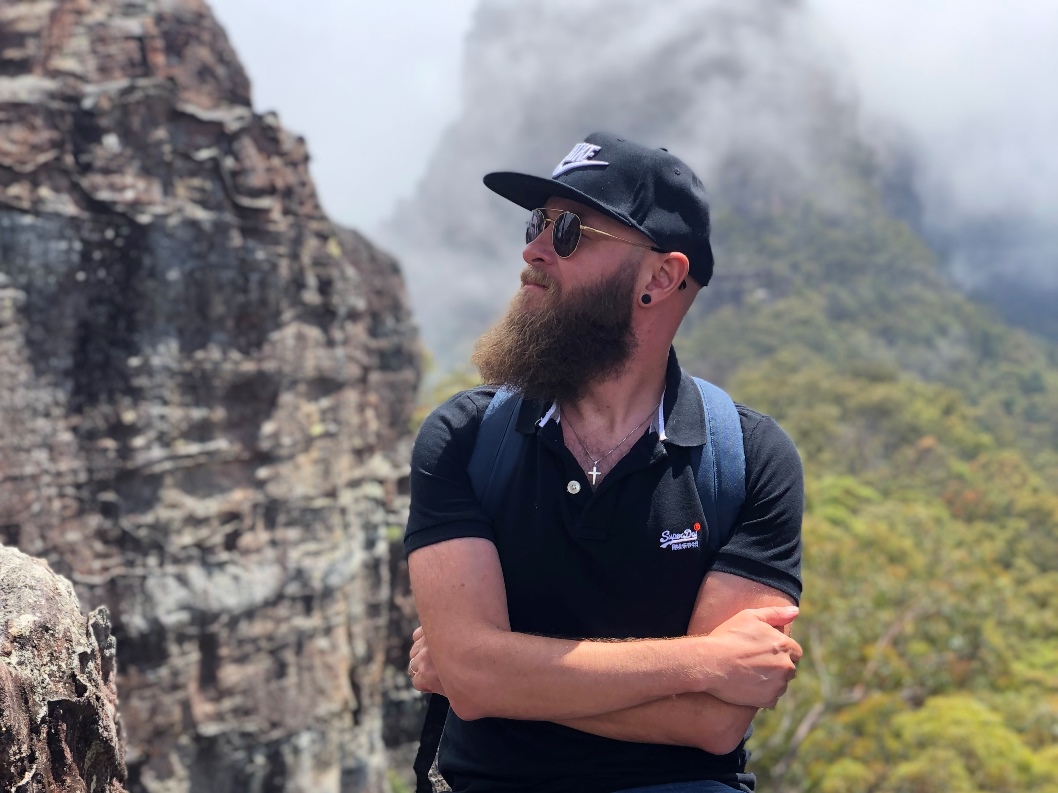
head in the clouds: hiking golden stairs to ruined castle
Posted 5th February 2022
The Blue Mountains region is a little further away from Sydney than many of the other National Parks we end up heading to most weekends. It’s a solid two-hour drive and so going to ‘The Blueys’ isn’t something we do too regularly; before we’ve even trodden a single hiking step, our day is immediately characterised by four hours sat in a car driving to and from the big smoke.
We undertook the 10 kilometre Golden Stairs to Ruined Castle hike. It started with a knee-crunching scramble down the valley side using the ‘staircase’, a mixture of steps cut into the rock, small stretches of metal walkways and wooden steps packed with earth; the gold in this golden stairs is purely metaphorical. The staircase to the valley floor then took us along a large flat walk through an exceptionally muddy fern forest which had my new hiking boots crying for mercy as the mud squelched and sucked at them. This damp stretch was populated by some of the weirdest and, for me anyway, hitherto unseen, species of fungi, some of which, to my novice eye, looked not unlike golf balls, shreds of carrot sticking out of moss-covered earth or delicate paper fans. All were utterly bizarre and all part of the magical charm this fern forest offers when you walk through her. I couldn’t resist having a Tarzan moment on one of the large tree roots which was hanging from the canopy a couple of hundred metres above. Indeed, swinging above the boggy valley floor did little to save my boots from the mud.
The third and final phase of the hike involved a quick scramble up, and squeezing between, boulders to reach the near-top of the Ruined Castle, with completely magical views out towards Castle Cliff and Castle Head. On this day cloud was particularly low-hanging and took to slowly drifting past the dark monolith of Castle Head itself. Sometimes not having a bright blue sky but instead, a moody one with drifting mists makes a mountain more dramatic, more moody, and infinitely more evocative. This was one such case where bad weather augments a vista. It was a breathtaking moment for sure and one which had me questioning how I could possibly have been ignorant to its existence for so long.

hope & change: towards a post-colonial australia?
Posted 26th January 2022
I choose to spend Australia Day far removed from the pomp and ceremony, far removed from the flag-waving and excessive Aussie bunting, far removed from the unsettling military flypasts and helicopters. This is a moral choice I make in support of Australia’s First Nations peoples. How could I possibly celebrate when a section of the population is in pain? Indeed, why, as a human being, would I think it is reasonable to celebrate a day which other human beings find so traumatic and incendiary?
We began the day by hiring a car and heading to Watson’s Bay for a picnic. We sat underneath the veranda of a colonial-era Federation-style building on the hill overlooking the mouth of Sydney Harbour, minding our own business but taking some light pleasure in the regatta of yachts racing out into the mouth of the harbour. It was exceptionally hot and humid and so we soon decided to drop down the coast to cool off at a nearby beach. I took no pleasure in the fighter bomber which, as part of the celebrations, took to zooming overhead, its thundering sound bordering on the terrifying. I couldn’t help but think how inappropriate this was on a day which was one of mourning for approximately 3% of the Australian population.
A coronavirus outbreak featuring yet another letter of the Greek alphabet meant that, unfortunately, I did not attend the Wugalora at Barangaroo this year. Nevertheless, there was enough time left on the hire car to swing by Barangaroo to see the Australia Day sculpture by the Indigenous artist Jacob Nash. This was the guy who, in 2019, was responsible for the incredible “ALWAYS”, the most important word in the refrain, “Always was, always will be, Aboriginal land”. This year, on the same hill overlooking Sydney Harbour, the three dimensional words “HOPE” and “CHANGE” faced each other. The simple mirrored effect of both words was a stroke of genius; Australia Day/Survival Day/Invasion Day is a day for a nation to ‘reflect’, for this is a nation where both colonial and post-colonial narratives co-exist in an unsettling and unresolved frozen conflict but which are set to collide annually on January 26th as sure as night follows day. Nash’s mirrored letters also absorb the landscape of Barangaroo around them, perhaps alluding to the importance of Country for First Nations peoples here in Australia. It was a completely uplifting spectacle. Indeed, the quiet dignity of this artwork sat high up on the hill, in my mind, achieves the moral ‘high ground’; a dignified protest which contrasts so strikingly with the toxic masculinity of the helicopters and the fighter jets further down the harbour.
I ended my Australia Day by switching on the television and to a special live broadcast on ABC TV. Unsurprisingly the name of this program’s title was deliberately devoid of perspective or emotion, simply, but powerfully, entitled “January 26”. The titles quickly faded into the presenter’s introduction and, as she referenced her Indigenous Bundjalung heritage from northern New South Wales, her voice quivered, her voice shook. It was all she could do to stop herself from enirely breaking down live on air, choking back the tears to make it to the first video segment. “I’m very emotional”, she said, symbolically patting her heart. And thus, writ large on the nation’s TV screens, was the unavoidable contemporary reality of Australia: it is crippled by an identity crisis mashed together in a colonial-era crucible of racism and invasion and theft and murder and lynchings and...
Like Nash, Indigenous Australians and many Australians of other heritages, I too HOPE Australia will CHANGE. It needs to. It is time Australia grew up and dealt with its dark colonial past so that it can better secure the future for all Australians - not just the white ones. This is my sixth Australia Day and I can tell that voices are growing for change from more quarters than ever before.
northern tasmania: climbing cradle mountain on christmas day
Posted 30th December 2021
This was my second visit to Australia's heart-shaped island state, having visited here in 2016 to complete the legendary Great Eastern Drive from Hobart in the south to Bay of Fires in the north. In travel I try not to visit the same place twice because, quite simply, there are so many other places I have yet to see. However, I had to make an exception in Tasmania's case. We had unfinished business in Tasmania, an omission which needed correcting. In 2016 we had significantly under-estimated Tasmania through ignorance and a lack of preparation and research. Back then, we departed the epithetic Apple Isle not having seen, let alone climbed, the island's iconic Cradle Mountain. It is an unpleasant, unsettling sensation to leave a place you have travelled to knowing that you have made a serious itinerary error; it's an itch and an annoyance which endures until it is corrected. And so we set off to Van Diemen's Land once again, this time flying into the capital of northern Tasmania, Launceston - the closest airport to the most majestic of Australian mountains. It seemed only fitting that we planned to complete this challenging climb on a poetically-satisfying Christmas Day.
As we followed the shoreline of Dove Lake, I took to repeatedly anxiously looking up at the peak which was shrouded in a constantly shifting mist. Picking up a sweaty pace but in the chill of the fresh mountain air meant I was reduced to constantly putting on and taking off clothing. Within an hour, my spare pair of trousers were returned to the bottom of my backpack. We walked through a magical little wooded area called the Ballroom Forest, an otherworldly woodland draped in green algae, moss and lichen before things took a more vertical turn including scaling the rough cliff edges by gripping onto the chain rails. The higher we climbed, the bluer the skies became. Looking back across where we had come afforded incredible views of Dove Lake and Crater Lake and their surrounding slopes. Much of the hike did little to challenge me; the route was not unlike many of the hikes I have completed in the recent past. It was not until we reached the boulder-strewn slope on the final leg to the summit that things became interesting. Clambering over the (thankfully dry) boulders, some the size of small cars, was not the problem; it was only when I reached a point where I could no longer clamber over them but had to vertically climb up them that I decided to finish my climb there. I had made it higher than most and was within a couple of hundred metres from the summit. But, I figured, I had had an awesome time and didn't fancy being airlifted to a hospital on Christmas Day. A top tip in mountaineering: know thy limits. Indeed, my hiking partner had stopped a couple of hundred metres below me and I had proceeded up until this point on my own. This was achievement enough in my mind. Later on that evening, in the safety of our Devonport hotel, I took to plotting the position I had reached on a photograph of the mountain I had taken that day (marked by a red dot in the photograph above). I was more than impressed with myself that I reached this height. As is always the case, descending the mountain was more painful than ascending, my knees in particular suffering the most. My confident and nimble ascent up the mountain now contrasting strongly with my clumsy descent characterised by frequent complaining, stumbling and falling. Mindful of not wanting to miss the final coach back from Dove Lake, our food stop was brief. A bread roll, humous and can of kombucha was our Christmas Dinner on the mountain before we recommenced the descent. The physical pain I felt was made somewhat more bearable by unsurpassed views of the Cradle Mountain chain now set against clear blue skies; from a distance I managed to capture Little Horn, Wiendorfer's Peak and Barn Bluff in a single photograph.
Click the photograph above to be taken to the full Travel Chronicle.

casting my first vote as an aussie citizen
Posted 1st December 2021
Today I voted in my first election on Australian soil. Admittedly this did not have the glamour, profile or prestige of a national Federal Election, but voting in the elections for the Sydney Mayor and City Councillor, although relatively pedestrian-sounding, was a significant day. There was the option of voting by post but, I felt, that such a day needed to be experienced in person. And so, a trip into central Sydney brought me to a white cardboard booth and two large slips of paper featuring an array of candidates. The system of voting in Australia is a little more complex than I am used to, requiring, as it does, the marking of "1" and "2" next to candidates' names to signal order of preference. I had engaged in the local debates and had a clear idea of who I was going to vote for. As it was, such a mundane task as voting was, for me anyway, a rather important occassion.

great escapes & lucky escapes: back to the bush
Posted 27th November 2021
After months in lockdown, we embraced New South Wales' National Parks like never before. Savouring the fresh air, the smell of the exquisite wildflowers in abundance and the sensation of getting lost in wide open spaces, we hit up as many of the national parks closest to the State capital Sydney in as quick a succession as we could. This was our great escape from the city and it had been months in the making.
Up until the moment restrictions began to ease I had been contained within a suffocating, claustrophobic 5km zone encircling my house. Depending on where you lived this meant, for some, permitted access to forests or coastline but, because I call central Sydney my home, I was trapped in an urban space comprised of concrete, glass and tarmac. A walk to Barangaroo headland was the closest I could hope to get to the great outdoors. While Sydney city may be internationally famous it is, contrary to popular perception, not a very nice place to live. I have written elsewhere on this site about the omnifailures of Australian cities and so do not need to repeat this diatribe here, suffice to say that Sydney’s greatest appeal, as far as I am concerned, lies in its proximity to beaches and bushland. In short, Australia doesn't do cities very well. Indeed, they’re even more soul-sucking and spirit-sapping when you can’t leave them.
The first weekend saw us bushwalk through 24km of national park bushland, with the enticingly-named, but ultimately a misnomer, Waratah Track, a 10km trail through Ku-ring-gai Chase National Park. This was followed on the Sunday by a near-14km hike in the Royal National Park along the Royal Coast Track and Garawarra Ridge Trail. Only six days later we embarked upon a mini hike through the Chester and Little Switzerland trails along the Kings Tableland plateau to the impressive Lincoln’s Rock Lookout (pictured) with sweeping views across Jamison Valley. It was an awesome day which quickly turned up incredible surprises involving, as it did, driving off road, seeing the Wentworth waterfall from above (I've previously seen it from below), enjoying a coffee from the flask overlooking the stunning Lake Burragorang - a vista so incredible I'm shocked it had taken me this long to know it even existed, and spotting my first Waratah. After living in NSW for five and a half years, and considering the amount of Aussie bushland I've hiked through, it was only now that I spotted the mighty Waratah - the floral emblem of New South Wales. We were driving off road and spotted these in the bushland by the roadside. Along this one stretch of quiet road, and only on this road, were scores of them in bunches of twos and threes and fours. This actually made my day. It seems fitting that I saw my first Waratah only after I became a citizen of Australia. I can't help but appreciate that there's a certain poetic quality to the timing of this.
A week later was another mini hike along the Natural Bridge Track and back and then on to Bluff Point Trail in Garigal National Park, a happy little green place just across the Harbour Bridge. Every time I've been here I've had a rewarding time. I awoke that morning completely shattered from a tough working week. A more impressive 15km hike was shelved and, to be honest, I probably should have stayed at home in bed completely. But, after a week spent in small spaces with white walls, strip lights and having to wear a mask all day, I just couldn't face staying indoors. My mind said "rest" but my heart said "go". So I did. This was a short walk, around 5km total, with a coffee enjoyed overlooking Bluff Point. The weather was windswept and there was an unwelcome chill in the air. Nevertheless, I was outside - and that was all that mattered.
Another weekend and another bushwalk. This time I took to hiking out my worries in Marramarra National Park. She was exactly what I needed: a bit of a challenge, beautiful scenery and tranquil wilderness. We followed the 14km Marramarra Ridge and Smuggler's Ridge loop down to Marramarra Creek. The descent was tricky, the ascent back up to the ridge was demanding. I don’t mind admitting that I huffed and puffed all the way. Marramarra Creek was the perfect spot to pull out the blanket, brew some coffee from the flask and take a dip in the Creek’s green waters to cool off, sharing the experience with a school of large fish. It's a wonderful feeling to coexist peacefully with God's creatures; there's a sense of natural balance and equivalence which I find liberating and uplifting.
The following week saw us on an 11km bushwalk along the Bullawarring Trail in Heathcote National Park - my first time in Heathcote. It's a bushland on a human scale but a speedy descent down into the damp valley quickly had us disoriented. We got lost on multiple occasions. There was a perfect little waterfall, beautiful sections of forest with a magical carpet of fern forest and little streams cackling by. Any day with a waterfall in it is an awesome day in my book. Still a little sore, we followed our foray into Heathcote the next day with a 13km bushwalk along the Sphinx Memorial to Bobbin Head track in Ku-ring-gai Chase National Park. It was a hike which changed personality multiple times: several kilometres of sandy fire trail, rocky scrambles, a wooded walk tracking the banks of Cackle Creek across bubbling streams and a steep rocky ascent. It was also home to one of Australia’s deadliest snakes which took to basking in the sunshine on the trail and away from the cold shadows of the brush. This was the closest either of us had come to being bitten by a snake in Australia being, as it was, merely feet from us and its grey-brown slenderness on sandy track rendering it almost entirely camouflaged, looking like any one of the hundreds of twigs, leaves or branches strewn across the path at any one time. This was a close call for sure and a reminder, if any were needed, that Australia is home to some of the deadliest creatures on the planet. Indeed, quite rattled by the experience, I undertook some research after this encounter to find that we had crossed paths with the world’s second deadliest snake and one which accounts for 60% of snakebite deaths in Australia. The bush is beautiful but also lethal; these two binaries coexist and have to be negotiated constantly by the bushwalker. It’s easy to become complacent. It also dawned on me that, had the snake bitten (its head was raised above the ground in preparation), I would not have known what to do and in what order.
Beginning to repeat ourselves we opted to check out new national park territory. This time, Lane Cove National Park just north of Sydney. This was a 13km looped bushwalk along the Riverside Walking Track, taking in part of the Great North Walk. Despite its proximity to the city this was a beautiful place packed full of wildlife. Lane Cove was teeming with Australian Water Dragons. I counted at least twelve along the riverside leg of our bushwalk. Some were so close I almost trod on them. The thing about these completely incredible creatures is that they love to be photographed - standing completely still, thus enabling you to take as many photographs as you please. They're such posers. Lane Cove River meanders through the park and is the main draw for incredible birdlife. Sulphur-crested Cockatoos were positively ubiquitous and I heard birdsong I had never heard before. Lane Cove also seemed to have its own unique miniature bush flowers which I had not seen, I believe, in any other national park.
With nearly 90km of bushwalking undertaken in just over a month of weekends, characterised most notably by birdsong, posing water dragons, deadly snakes, exquisite blooms, bubbling streams, winding creeks teeming with fish perfect for skinny dipping, and a whole lot of huffing and puffing, my hunger for the great Aussie bush had just about been satiated. For now anyway...
At a glance:
- Ku-ring-gai Chase National Park, 9.78km Waratah Track.
- Royal National Park, 14km Royal Coast Track and Garawarra Ridge Trail.
- Blue Mountains National Park, 9km Chester and Little Switzerland Trails.
- Garigal National Park, 5km Natural Bridge Track and Bluff Point Trail.
- Marramarra National Park, 14km Marramarra Ridge and Smuggler's Ridge Loop.
- Heathcote National Park, 11km Bullawarring Trail.
- Ku-ring-gai Chase National Park, 13km Sphinx Memorial to Bobbin Head Track.
- Lane Cove National Park, 13km Riverside Walking Track.
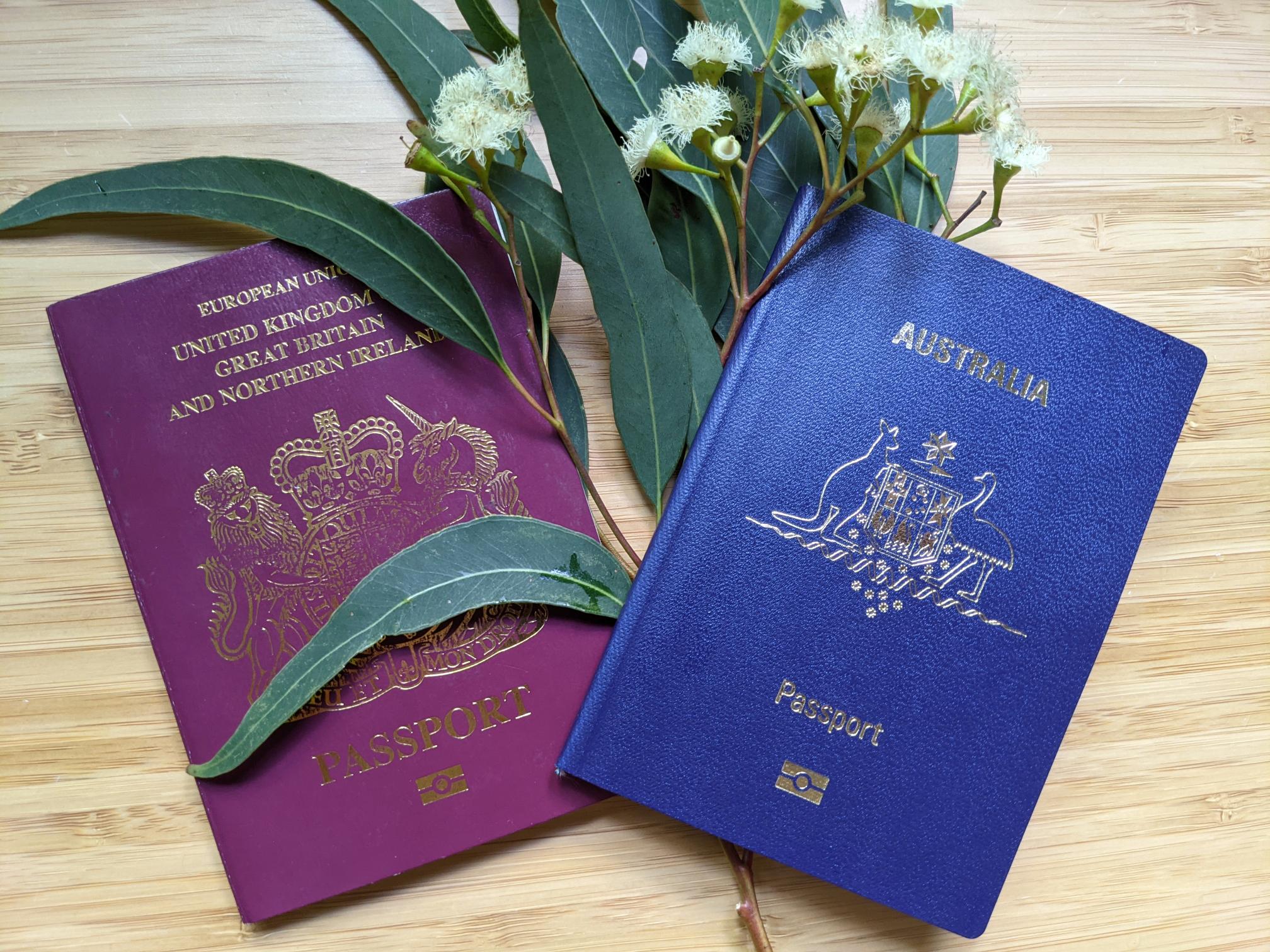
becoming an australian citizen
Posted 28th August 2021
I've been on many journeys through foreign lands. But this was a metaphorical journey which, for the most part, involved travelling no distance at all and yet felt like a high-stakes voyage of discovery. It was a journey through the souks of Australian bureaucracy, a risky adventure in to the pulsating medina of pure Aussieness, a saunter through the labyrinthine backstreets of nationhood and immigration politics. This was a journey to becoming a citizen of a country nearly 17,000 kilometres away from the one in which I was raised.
It's a cathartic moment when something you've been working towards for years finally bears its long-awaited fruit. To fully appreciate the entire journey it helps to crunch a few numbers: it took precisely 2238 days from when I submitted my application for a Permanent Residency visa to get to today. That's 6 years, 1 month and 15 days or 73 months and 15 days. However, in order to be able to apply for the visa I had to run the gauntlet with the federal assessment body AITSL first, sending off all of my documents (and hopes) to Canberra on the 21st February 2015. This was the real starting point and so it's more like 2376 days - or 6 years, six months and 3 days. I've lost track of the financial cost of the PR Visa, the Citizenship by Conferral, the certification of many documents... The journey to Citizenship was certainly not an inexpensive one.
On Tuesday the 25th August 2021 at exactly 15:18 I became a citizen of Australia and therefore a dual British-Australian in an online Citizenship Ceremony held by Sydney Council, hosted by the Lord Mayor of Sydney Clover Moore. Admittedly it was not the grand occasion I was hoping for when I formally Iodged my Citizenship by Conferral application in the Department of Home Affairs portal back on the 25th May 2020; the symbolic start of a transition from being 'merely' a Permanent Resident of Australia to a full Citizen of Australia. Under normal circumstances the ceremony would have involved attendance at the grand Sydney Town Hall where I would meet the Lord Mayor in person, mount the stage to collect my certificate, have a photograph taken to capture the glorious moment and be ceremoniously handed a native Australian plant as a symbolic gesture of welcome. But 2021 in New South Wales has been far from ordinary and, like so many things, gatherings, ceremonial or otherwise, now take place online. Bizarrely, my Australian Citizenship ceremony all took place without leaving the lounge, incongruously making the oath to the Australian people on a second-hand couch we bought for a knock-down price on eBay years ago. Despite the less than salubrious surroundings I made sure that I dressed for the event, donning a shirt and tie as befitting the solemnity and significance of the occasion. Despite the ceremony's distinct lack of pomp I was still grateful that it took place at all, enabling me to reach this final destination.
What's changed? Well, perhaps paradoxically, everything and nothing has changed. My everyday life is precisely the same as it was; I still get up at the same time, drink the same coffee and work for the same employer. Of course, what Citizenship gives you is not really about the material changes. It's the things you can't see and can't quantify which Citizenship bestows; peace of mind, the removal of life in limbo, a sense of permanence and belonging. I will also finally have a say in Australia's political system being, as I am, now eligible to vote. This is great timing as there are a few elections looming on the horizon, including the Federal Election. Citizenship also brings with it some responsibilities. Voting in elections in Australia is mandatory (Aussies love this word) and non-compliance results in a fine. I could also be instructed to sit on a jury or be called up to defend the country in the event of war.
So, what now? I await my Citizenship Certificate to arrive in the post from the Department of Home Affairs. At this point I will be able to enrol to vote and embark upon the final leg of this bureaucratic odyssey: getting an Australian passport. Perhaps then, pandemic permitting of course, I may be able to go on a literal journey - one with real souks, real medinas and real labyrinthine backstreets...
Update: by September 20th 2021 I had received my Australian Citizenship certificate, was placed on the Electoral Roll by the Australian Electoral Commission and received my Australian Passport. All done.

five years on: this ain't no boomerang pom
Posted 16th July 2021
Today is remarkable and so I am going to mark it by remarking on it. It marks the end of my fifth year living in Australia. Tomorrow is the first day of my sixth year... According to a report by BBC News in 2016 (pertinently the year I left England’s shores for Oz), nearly half of the Brits emigrating to Australia return home within five years. That’s around 7,000 chucking in their big Aussie dream and going home each year. In true Australian style, the Aussies have a witty and blunt name for this lot: they’re the oxymoronically-sounding ‘Boomerang Poms’. So, with this in mind, I suppose embarking upon my sixth year here feels like another small achievement in this context. Somehow, despite the downs and the ups (and the downs), we’ve managed to make Australia work for us. I’ve written on this blog several times now about trying to keep an open mind and not expecting everything to be perfect. Indeed, my very first post on this blog back in January 2016 – the day our visas came through - anticipated the challenges ahead and the need to take the rough with the smooth: “There are lots of opportunities and, I have no doubt, lots of hurdles. I'm approaching this pragmatically: not everything is going to be sunshine and koalas.” And it hasn’t been all sunshine – and, if you must know, I haven't seen any koalas in the wild either. I could, at this point, launch into a not insubstantial list of the things which annoy, frustrate and perturb me about life in Australia. But I won’t. I won’t because things are as they are – and everything here, the great, the good, the bad and the ugly, forms part of the experience of living in a foreign land thousands of miles (or is that kilometres?) from home. Good different. Bad different. It's all different and thus valuable to a person who left Blighty to escape ‘more of the same’. Another mantra I’ve tried to live my new Aussie life by comes in the form of this wonderful Aboriginal proverb: "Go with a clear, open and accepting spirit and the country will not treat you badly." This proverb graces the head of this blog for a reason.
And perhaps this mindset makes the difference between those who stay and those who go? For now I'm glad that I'm among the 50% who've stuck around.
Sure, I left a lot of things behind in the UK (I could produce another healthy list) but it’s also true that I’ve gained from these losses; it’s the classic paradox of the emigrant – losing to gain. People have told me all my life that the "grass isn't always greener on the other side", yet I have always found it to be exactly that. Seek and ye shall find. Emigration has catalysed so many changes in my outlook, lifestyle and professional life that I barely recognise the person who left the UK's shores five years ago today. If you want to make a change, do it. You have one life. I am here to attest that the other side is full of lush, green grass.

aussie mountain quest: summit hikes to didthul & budawang
Posted 23rd May 2021
As the pandemic continues to rage around the World I am increasingly to be found outdoors hiking and climbing in Australia’s national parks; it’s the one outlet I have left. Climbing mountains in particular gives me something to aim towards – a goal which feels like an achievement of sorts; I’ve done a workout en-route, taken some beautiful photographs and reached a literal and metaphorical peak by getting to the top. Listed as one of the ten epic mountain hikes in Australia, we headed to The Budawangs, a rugged mountain range with awesome views from the top of Pigeon House Mountain, also known as Didthul Mountain.
Having already hiked up some of Australia’s best, including The Warrumbungles, Mount Kosciuszko in the Snowy Mountains Region and Rawnsley Bluff in South Australia, I suppose it was only a matter of time before we embarked upon Didthul Mountain and Mount Budawang. On the Didthul ascent (pictured above) we were blessed with perfect hiking weather: sunny but cool at 10°. Total hike distance was 8.5km with a maximum elevation of 739m, gaining an elevation of 414m with a difficulty grade 4 out of 5. It took us around three and a half hours – but only because of frequent stops to take photographs. The final push to the top of Didthul was characterised by vertigo-inducing steel stairs which scaled the vertical cliff face. Surprisingly, the verticality didn’t bother me. Incredible views of the Budawangs – some of the best I have seen form the top of a mountain – greeted us as we reached the top. There was nothing left but to find a spot out of the bitterly cold wind and celebrate in the only way we knew how: by cracking open the Thermos for a warming coffee at high altitude. Turkish bread and hummus, a staple of our hiking food spread, completed our picnic at the peak.
The following day we sought out an easier hike and chose Mount Budawang. It seemed fitting to climb this eponymous mountain being, as it is, the name of the National Park itself. Our hike was extended by an extra 4km because of impassable roads which added an additional 2km each way. What I hoped would be a more chilled hike compared to Didthul ended up being twice as challenging; steeper, longer distance, no flat stretches but uphill all the way along a rock-strewn trail. It was colder too. Indeed, for part of the way I regretted not taking my padded hiking jacket. It took us a little over four hours, covering a distance of 15.51km (nearly double the distance covered the day before), with a total elevation of 1157m and an elevation gain of 584m.
Two mountains in two days: 24km with an ascent of 1000m in total. My body ached but my heart was content.
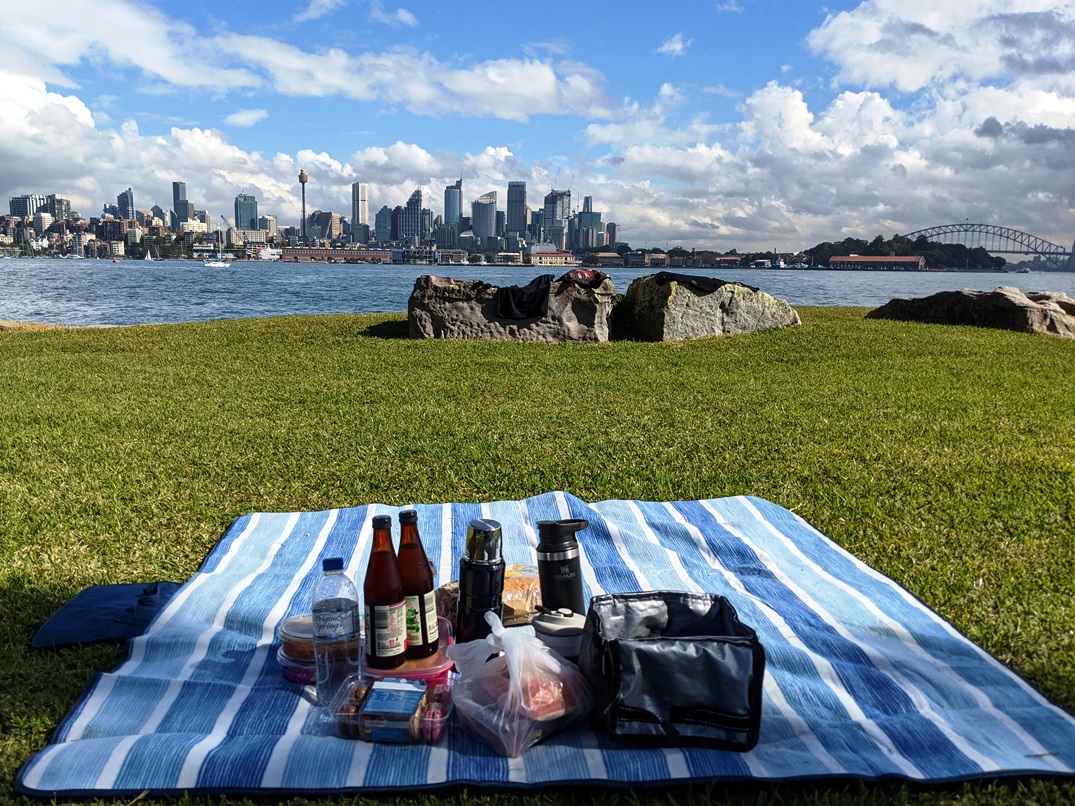
kayaking to clark island for a picnic to remember
Posted 9 May 2021
We set off from Rushcutters Bay on our kayaks, paddling furiously toward Clark Island, some 600m across the iconic waters of Sydney Harbour. We’ve used the little kayak hire company at Rushcutters before - but this kayak trip was different this time round with the kayaking merely a means to an end rather than being the whole point in itself. Our backpacks were stuffed with picnic goodies – everything from bottles of kombucha to brightly-coloured macaroons. The changeable weather in Sydney, made less pleasant by recent backburning smoke, held off long enough so as not to spoil our special day.
We reached the shore of Clark Island, hoiking our kayaks up the steps to terre firma, and changed into fresh clothes which, despite the splashes and one of us falling into the Harbour, had managed to remain dry. There was nothing more to do except unfurl the picnic blanket, lay out the spread we had brought with us – far too much for two people of course, and enjoy the view back over towards Sydney’s skyline and its ‘Coathanger’ Harbour Bridge. For most of the time we had this tiny island entirely to ourselves – save for a cheeky Magpie which thrice tried to steal his foody share of our celebration. With our bellies loaded we clambered back onto our kayaks and paddled back over to Rushcutter’s Bay.
road tripping through country & outback south australia
Posted 13 April 2021
South Australia. The fourth largest Australian state or territory and, as I touched down in Adelaide, my seventh Australian state, with only Queensland now remaining. Initial plans to fly to Brisbane and drive along the east coast to Cairns to experience Australia's iconic Great Barrier Reef were shelved, for the second time in a year, because of another infection scare in the Queensland capital. Amid a pandemic-ravaged world, and so used to counting countries, I have resorted to counting Australian states and territories instead... This was the first time I had left the borders of New South Wales in close to 15 months. In that time I had travelled all over my home state, seeking out incredible sights and outdoor adventures which would otherwise have remained unknown to me: from the iconic hippie paradise of Byron in NSW's Far North, to the otherworldly lunar landscape of Mungo in its south west; from hiking across the top of the awesome Warrumbungles in Central NSW, to straddling two time zones on the State's western border at Broken Hill.
As I have come to discover from my travels around Australia, the true beating heart of Australia will never be found in the state capitals: there is nothing more un-Australian, in my opinion, than the Opera House, the Harbour Bridge or the off-the-shelf glass skyscrapers of cities like Sydney, Brisbane or Melbourne. Australia's ancient beating heart, a slow, murmuring thud from the Dreamtime will only ever be felt in her oft-maligned sleepy country towns, in her vast scorched vistas stretching far into the horizon, in her vividly red ochre and her greying dust. A journey into the Australian Country and Outback is a journey into the truest and purest part of Australia. You can feel Australia's soul in such places. Australia is an extraordinary place indeed.
Click the photograph above to be taken to the full Travel Chronicle.
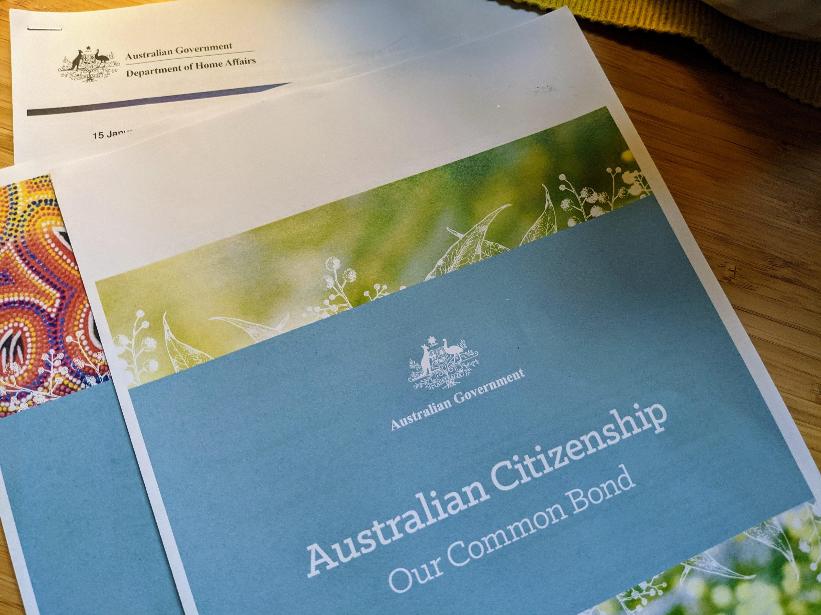
australian citizenship approved: passing my interview & test
Posted 22 February & 10 March 2021
Another hurdle was jumped today in my long road to Australian Citizenship. A month or so ago we received notification from the Department of Home Affairs of our Citizenship Interview and Test. It had taken just under nine months to get to this point having submitted our online application for Citizenship "by conferment" back in May 2020 at the height of the pandemic lockdown.
With a month's notice to prepare, I set about revising the contents of the 'Our Common Bond' booklet, a fifty or so page document covering the four "testable areas" for the multiple choice test. I combined this with various Australian Citizenship test apps and the Department's official podcasts which I took to listening on my daily commute, free time at home and even when hiking up mountains with a bunch of teenagers. In hindsight, I overdid things a little but passing the test was too important to leave to chance (I'm the kind of guy who gets to the airport five hours earlier than necessary - just in case). As it was I completed the test in less than a quarter of the time and got 100% correct.
The test was preceded by an 'Interview' which ended up as little more than a quick series of questions asked by a friendly woman followed by the presenting of some basic documents such as birth certificate and proof of address, all of which I pressed eagerly against the glass. It was a far more laid back affair than I'd expected. My appointment time was 10:30am and I was finished and exiting the building before the clock had even struck 11:00; a two hour Interview and Test slot reduced to less than a quarter. I entered back onto a typically non-descript Sydney street clutching my "Congratulations, you passed" sheet of paper. Another hurdle jumped.
This tense experience is now followed by a lengthy wait period where my application makes its way through the annals of Australian bureaucracy, like something out of Orwell; a place of documents disappearing into memory holes with apparatchiks robotically processing the next person's future completely numb to their plight. All I have to do is wait. I'm hoping to be a Citizen of Australia by the time the year is out...
Update:
I wasn't to know it at the time but it would be a further 16 days until the dreaded "Received" status on my Immi account switched to "Approved"; a significant change in status which translates roughly as "Anything can still happen" to "It's in the bag - no need to worry, chill out". It was without doubt one of the most agonising two weeks of my life. Indeed, there were some days when I'd logged into my account over 40 times. I don't know what made me log into my account on a Saturday morning, mistakenly believing that Citzenship applications wouldn't be processed at the weekend; surely the Department would be closed? The word "Approved" was there in all of its bureacratic glory. I blinked a couple of times to check I hadn't mis-read it. It was an incredible way to start the Mardi Gras weekend. This moment had been six years in the making. All we have to do now is wait (again) for a ceremony to swear the oath and I will formally become a Citizen of Australia. Trust me, it's as exciting as it sounds.

camping adventures along the colo river
Posted 22 February 2021
This was a four day, three night adventure along the Colo River, sleeping under canvas, eating by the camp fire, hiking 12 kilometers across the Colo peaks as well as canoeing upstream along the mighty Colo River for six kilometers at daybreak. This isn't the first time I've been out this way. I was here last year on a similar trip. This time, however, I was staying for the vast majority of the expedition - with a brief foray back into Sydney for the small matter of a Citizenship Interview and Test.
In typical Aussie fashion the weather was unforgiving; humidity, intense downpours and burning hot sunshine - played by Mother Nature on a loop. These mountain ranges had some of the angriest and fastest ants I have ever come across; within moments they would take to swarming on my trainers and up my socks. At one point I took to hitting my feet with a rock to stop them in their ascent up my legs. Their ability to mobilise in a matter of seconds was both impressive and terrifying. The most memorable moment of the four days came when I was the most tired. On the final day we set off in a canoe, paddling upstream and against the tide for six kilometers. It was daybreak and, packing our tents up in the darkness of a 5am wake-up, we soon found ourselves slipping and slidding down the mudy banks of the mighty Colo and sliding into the water. We found ourselves waking up at the same time as the Colo; misty and moody in the early morning drizzle, her evocative gloom slowly gave way to tempered sunshine. I headed up in my canoe to the front of the pack, meaning the water's surface was undisturbed by the paddling of others. The stillness of the water up ahead meant we were blessed with awesome reflections; the tree-lined banks reflected beautifully on both sides. There are worse ways to spend a morning.
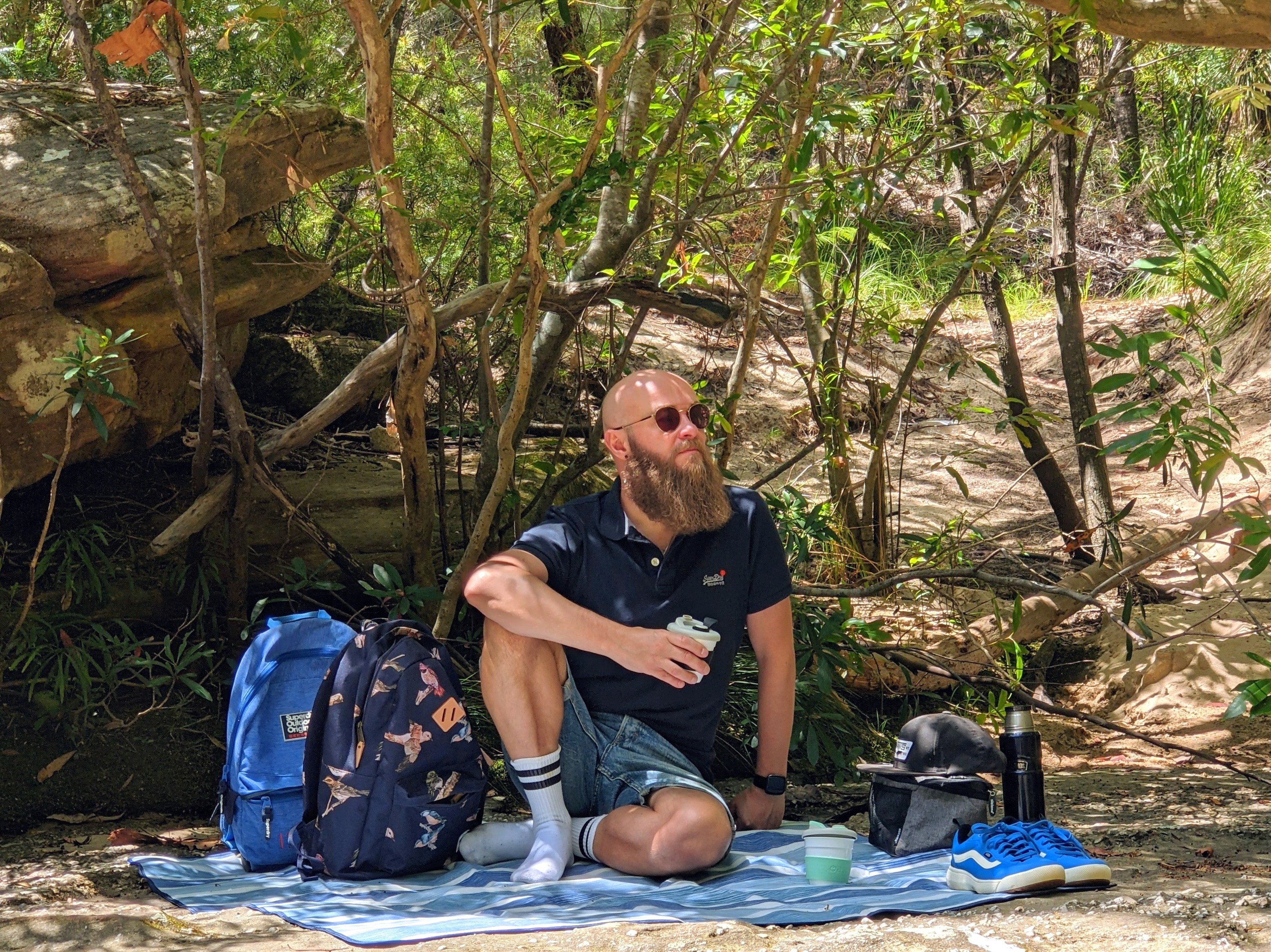
bushwalking the cascades track in the garigal
Posted 17 January 2021
This was intended to be a short bushwalk along the Cascades Bushwalking Track in the Garigal National Park: a manageable five kilometres return just to take in some outdoor vapours and vistas. We quickly made it from the Acron cricket ground deep into the national park and were lead ever deeper along the track by the promise of finding waterfalls and by the Middle Habour Creek's rich and moody water colours: blacks, browns and oranges. The colours were rich and earthy, and seemed to hold the promise of wilder things ahead. Indeed, we'd spotted a wallaby at the very outset as well as a goanna and several cicadas - you often only hear these treescreamers and so it made a change to actually see some of them. As we tracked the creek southwards, the trail would disappear and reappear disconcertingly. It would vanish behind giant boulders, around which we had to quite literally squeeze, and fade away altogether - only to reappear disjointedly somewhere else. By NSW Parks standards this trail was poorly signposted. We weren't meant to be out for very long and had come a little ill-prepared. There was time to find a shady spot along the water's edge to roll out the picnic blanket and enjoy a coffee from the thermos (above) before setting off again.
To save time, and to avoid having to do a 180 degree turn and walk back exactly the same way we had come (never very inspiring), we endeavoured to finish at the Crossing Stones and cut across the creek itself so that we could make it up the hillside and out into suburbia. Unfortunately one of the stepping stones was missing, meaning we had little option but to remove socks and trainers and put our faith in a rock hovering below the water's surface. Seconds later and I was up to my waste in creek water. Luckily I had ensconced my phone from my pocket and placed this in my backpack beforehand - the pocket now under water; turns out the stepping stone under the water was far slipperier than I gave it credit for. The trail did its vanishing act a few more times, a few more lost moments, heart raced a little, phone battery dying... and we emerged from the escarpment on to a suburban road. With a 45 minute walk left along bland streets we opted for a taxi to get us back to Acron.
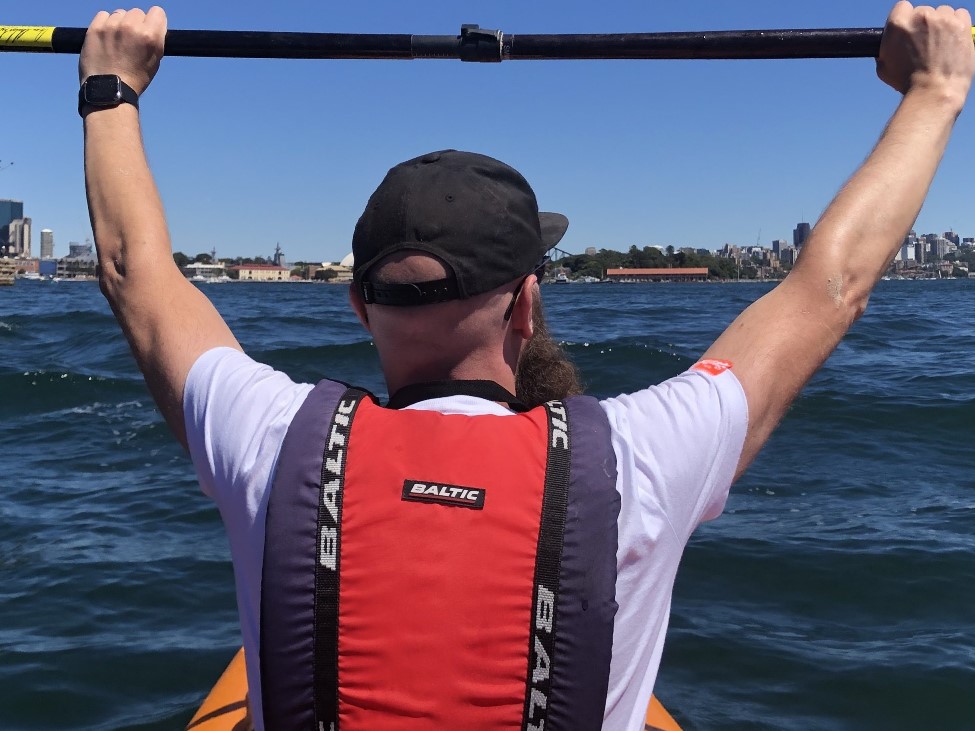
a saturday morning kayak around sydney harbour
Posted 16 January 2021
There are worse ways to spend three hours on a Saturday morning in Sydney City. We set off on our kayaks from Rushcutters Bay, making our way to Darling Point, then Double Bay and out across the choppy waters to Clarke Island - a peaceful little idyll in the middle of one of the world's most famous harbours. We were given minimal instruction and a quick glance at a laminated map before being sent out to run the gauntlet with speed boats and ferries.
The weather was perfect for kayaking; bright and sunny with only light winds. I've only ever arrived at Double Bay by ferry before now, and doing so by kayak was pretty awesome - especially when we were able to pick up a toasted banana bread from a local cafe and enjoy it, along with a coffee from our thermos, on the sands of Double Bay's little beach. Kayaking to Clark Island, part of the Harbour National Park, was the most challenging part; instead of hugging close to the shoreline we had no option but to cut across the water - selecting an opportune moment when the harbour traffic through this stretch of water had died down sufficiently to enable us to make the crossing. The reward was a mooring up at the steps to the island and to be able to a few minutes to appreciate views of the city from a brand new location (I must have seen Sydney from every possible vantage point now). With my butt drenched, my legs burnt by the sun and my shorts stained white by the salt of the harbour's water, we disembarked back at Rushcutters and blended back into the hustle and bustle of a Saturday afternoon; my stained shorts, squelching shoes and damp t-shirt among the clues that we had not been out shopping like everyone else.
mountain adventures in central nsw: the warrumbungles
Posted 12 January 2021
This was my first road trip of 2021. We stayed in a small motel in the neighbouring country town of Coonabarabran which sits on the divide between the Central West and North West Slopes regions of New South Wales - a mere 500km north west of Sydney. Like many country towns it felt quaint but also rather frontier. Getting a square meal here was nigh-on impossible. Some of the worst food I have tasted in a long time was eaten in Coonabarabran. Culinary offering aside, 'Coona' was the perfect spot for quick access to the Warrumbungles National Park. I remember seeing a photograph of its peculiar lumpy, bumpy landscape on a NSW Parks display somewhere and determined that I would visit one day; I'm drawn to those things which markedly differentiate Australia from the land I grew up in; the unusual, the unknown, the out and out weird. I tire quickly of seeing the same things. I'm like a child always attracted to the fresh and the new. In fact, beholding sights I've never seen before will always feel magical and, to this end, I suppose I'm destined to be a traveller for the rest of my life.
I'm mindful of the change Australia has brought about in me. I used to be all about the urban; a true city boy. Now I delight in wide open spaces, landscapes and natural scenery. Perhaps it's a matter of maturity or perhaps just 'the Australia effect' - or perhaps both. Whichever, climbing mountains in the (very) bright Aussie sunshine surrounded by incredible creatures and volcanic vistas stretching as far as the eye can see is an awesome way to spend time.
The Breadknife and Grand High Tops hike was harder than I'd anticipated taking, as it did, 6 hours in 26° heat and covering a 15.5km distance. Some of the ascents were steep, with well-paved trails giving way to boulder-strewn assault courses. My hike up to the top of Australia's highest mountain, Mount Kos, only a couple of weeks previous, now seemed like a gentle warm-up in comparison. Despite both being given a difficulty level of "4", the Warrumbungles hike was undoubtedly tougher and came close to being my toughest yet. The views of the Warrumbungles mountain range at various points were dramatic, rugged and 'awesome' - in the traditional sense of the word capturing, as it does, the emotions of respect, fear and wonderment evoked in the beholder. Indeed, the Indigenous name of this landscape, the 'Warrumbungles', which roughly translates as "crooked mountain", appraises something of this place's uncanny, almost lunar, semblance. I frequently find that seeking out the translations of Indigenous place names can be particularly revealing and meaningful, like someone else has already encapsulated the essence of a place and understood its spirit thousands of years before me. There's a wisdom in Aboriginal names which I both admire and learn from. We were joined on our hike by a plethora of critters and creatures, most notably an incredible Goanna which, despite my pained photography, seemed unperturbed (even unimpressed) by my presence and stuck to languidly sunning itself on a boulder overlooking the valley. This was his spot and he wasn't going to move for anyone - let alone a Pom. The descent down the mountain should have been easier but, with added aches and soreness which weren't there to begin with, was slower-paced than I would have liked it to have been. We were also beginning to run out of water (note to self: I drink like a fish when active - pack more water). Passing bubbling creeks and picking our way through clearings as well as thicker areas of brush on the valley floor, I couldn't help but notice that, apart from a small group of campers, we were the only ones undertaking the full 15.5km loop to Pincham. We had this trail all to ourselves. Back in Coonabarabran, we stuffed our faces with food from a local Chinese restaurant - the only restaurant open in town. We had packed healthier options and could have knocked this up in the motel room using the toaster and microwave but, unfortunately, a pumpkin soup with bread just didn't seem sufficient after the day's exertions.
The following day we put the hire car to good use, driving out of Central NSW to something called 'North-Central New South Wales'. I don't think I'll ever tire of seeing how such vast slabs of land on this giant sunburnt continent are carved up by referencing multiple compass points at the same time (in this instance 'North', 'Central' and 'South'): man's small-minded efforts to rationalise, label and compartmentalise such incredibly vast and wild spaces are never more pronounced than in Australia. We headed off-road into Pilliga Forests - a semi-arid forest said to be the largest uninterrupted expanse in the State. Our 4WD slid over the red sandy roads (the kind of red which re-kindled memories of my time in the Outback), bumping and jumping at every Dip and Crest before making it into the clearing of the Pilliga Lookout Tower, an uncompromising metal edifice whose appearance was on-par with a wartime watchtower, for an uninterrupted 360 degree view out across the forest's flatness. We headed back into Central NSW, and in to Mount Kaputar National Park. A kilometer's walk from the car park led us to the hexagonal marvel of the Sawn Rocks, affectionately called the Organ Pipes. I took to scrambling up large boulders at the foot of the cliff to get closer but, admittedly, the best view could be had back at the platform opposite from where I had started. We motored on up the steep winding roads of Mount Kaputar itself, a drive not for the faint-hearted; its hair-pin bends and narrow roads felt perilous - especially when meeting cars coming back down the mountain. A lay-by about half way up proffered the option of turning round and making it back down to safety but, I'm glad to say, we persevered and made it to Kaputar's summit, a not insubstantial 1510m above sea level. The vista, bathed in the richness of the afternoon sunshine, was uplifting, as was the presence of a truly beautiful Eastern Grey Kangaroo with a joey poking out from her pouch. I will never tire of seeing these majestic creatures. Set against a backdrop of mountain blooms and the horizon made this particular sighting as near-perfect as it is possible to get. A day spotting a kangaroo is always a good day.
And so, bidding farewell to its beguiling goannas and beautiful kangaroos, its 'crooked' volcanic landscapes and arduous mountain hikes, I set off for the State capital thankful and satisfied that my childish itch to see and do new things had been purged. For now at least. I also left Central NSW with a renewed appreciation and respect for my home state: its sheer abundance, its mind-boggling diversity, its ancient wisdom - and its terrifying size. Just when I thought I'd seen everything New South Wales had to offer, she surprises and delights yet again; evidently there's still plenty of New left in New South Wales. And I am thankful for that.
Click the photograph above to be taken to the full Travel Chronicle.

mount kos: hiking to the top of australia's highest mountain
Posted 29 December 2020
This has been on my Aussie bucket list for a couple of years now and, with the Queensland border closure scuppering a planned road trip from Brisbane to Cairns, the opportunity to climb Australia's highest mountain finally presented itself. I was initially hoping to make it to the summit of ‘Mount Koz’ on New Year’s Day; this seemed like the most poetically satisyfing option. However, where hiking at (relatively) high altitude is concerned, practicality had to take precedence and so we took to sifting through ten days of weather reports so that we were summit-bound on the best weather day. There's nothing worse than getting to the top of a mountain and being unable to see a thing.
This being such a poor year for travelling anywhere, we also decided to max out on accommodation costs by booking a chalet for two nights at Crackenback, near Jindabyne. It was an investment which was to pay off in unforeseen ways. Not only did the booking allow us to avoid the very worst experiences guaranteed by staying in yet another run-down Aussie motel but it also meant that at dawn and dusk we would find ourselves sharing the grounds with a mob of kangaroos. I must say that sipping freshly brewed coffee outside in the morning whilst watching a mother and her joey enjoying the landscape as much as I, was, in itself, worth the exorbitant price tag.
Looking out to the mountainsides from the chalet I quickly got a sense of the changeability of the weather in this part of New South Wales; quick downpours, blackening clouds followed by bright blue skies. We stuffed our backpacks accordingly not knowing what to expect en-route to the top of Australia’s tallest mountain; windproof macs and layers and gloves. Much of it was surplus to requirements in the end; hiking ever upwards at a fast pace inevitably meant we were shedding layers rather than adding them. Still, better safe than sorry.
We set off from the chalet at around eight in the morning to be sure we’d get to Thredbo with enough time to find a parking spot and be there for when the chairlift opened. As I stepped out of the car I could feel a distinct fresh Alpine nip in the air which had me thankful we’d been cautious in our preparations. With formalities complete we were soon on the chairlift and being cranked upwards to the start of our 13km hike. There were plenty of others undertaking the same endeavour but, on such a vast mountain, we soon fanned out, resulting in a tranquil morning spent in the bright sunshine passing exquisite Alpine flowers and hearing the faint bubblings of the famed Snowy River of ‘The Man from…’ renown. There was time to admire Lake Cootapatamba - Australia's highest lake – as well as use the facilities of Australia’s highest public convenience.
This is the highest and longest hike I have ever undertaken when compared to my previous efforts on Wales' Mount Snowdon (1085m) and Lesotho's Drakensberg-Maloti mountain range (2080m). I have also survived an altitude sickness-inducing overnight stay in a yurt on a mountaintop in Kyrgyzstan at 3012 metres but this didn’t involve any hike to the top. And so, reaching the summit of Mount Koz, two thousand plus metres above Australia, felt like a real achievement. For a second or two I must’ve been the highest person in the country. Unsurprisingly my descent was a little less fast-paced and less dignified, my manly struts up the mountain replaced by hobbling and tripping down it. I didn’t care; in my tiredness there was a sense of earned satisfaction that I had hiked to the top of Australia’s highest mountain.
getting up close with a cheeky cockatoo
Posted 22 November 2020
Watson's Bay is so pretty it is well worth the two ferry journeys it takes to get here sitting, as it does, far out at the mouth of Sydney Harbour. We try to head here at least once a year and inevitably end up walking the 2km return trip up to the red and white-striped Hornby Lighthouse. Before setting off on the little trek past Camp Cove Beach (one of the dinkiest and cutest little beaches in Sydney) and up the hill, we stopped off in the Library Cafe, which overlooks the bay, for coffee and pancakes with fruit. Making the whole trip worthwhile was the appearance of two hungry Sulphur-crested cockatoos at our table which, thanks to the handing over of some nuts by the cafe owner, we took to feeding by hand. It was a joy to get up so close to these beautiful and cheeky Aussie birds - birds which I have so often only been able to behold from the ground looking up.
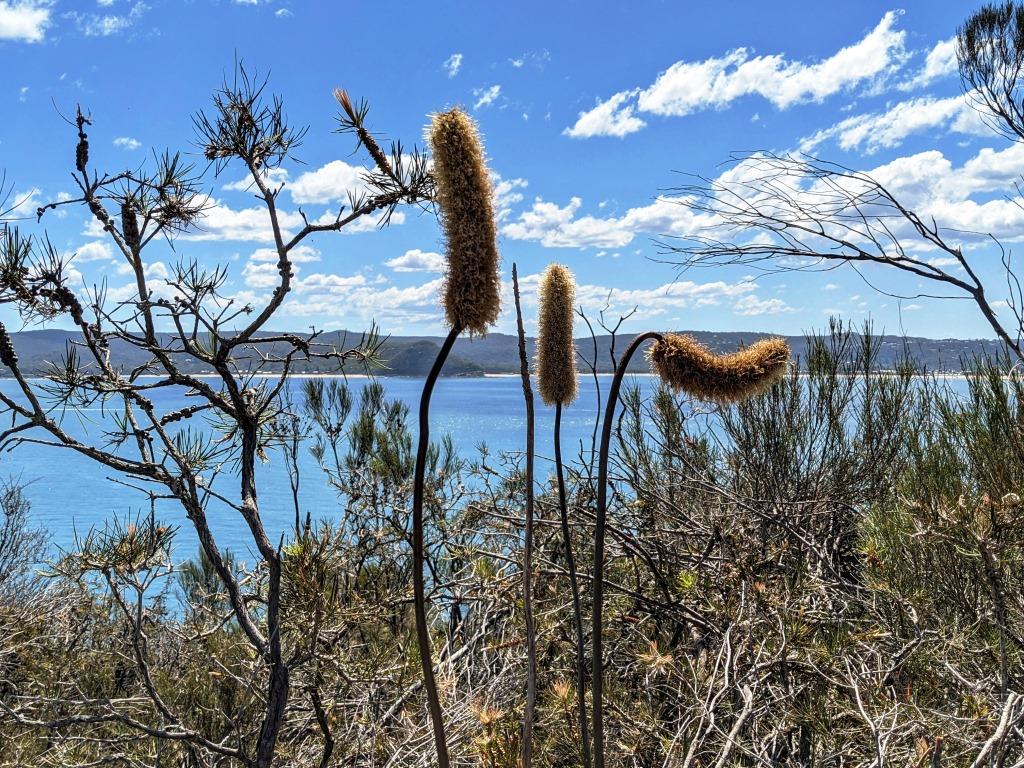
to woy woy & back: bushwalking in bouddi
Posted 14 November 2020
As I prepare to enter my fifth Summer here, the resumption of getting out and about to beaches and bushland (sometimes both on the same day) beckons. We took a trip northwards to Woy Woy, a town with a cute harbour and some hungry pelicans sitting on the roof of the local fish and chips shop. Our bushwalk from Hawke Head to Box Head Lookout via Tallow Beach in the Bouddi National Park was a modest enough effort at around 5km return. It was only 26° but felt a lot hotter tramping through the bushland which skirted the coastline in parts bringing an ocassional cool breeze off the water. A nice feature of a bushwalk which kisses the coastline is that your sweating profusely through the brush has the opportunity to be rewarded with a cooling dip in the ocean at some point along the journey. Which is exactly what we did. After last Summer's devastating bush fires which blanketed much of the Sydney region in smoke, I feel particularly grateful for this year's blue skies and fresh air. Summer is here; it's been two years in the making...
new south wales far north: a 2000km road trip to byron bay
Posted 10 October 2020
With ongoing World events affecting international travel, I quietly resigned myself to the fact that another holiday would be spent travelling around New South Wales in a car. In July, on our road trip out to Broken Hill, we travelled so far to the State's west that we literally went back in time. Having travelled to the State's far west, and having already been far south, the only direction left was northward. And so, from paradisal beaches with pinky sunsets and silhouetted surfers, to giant stinging trees infested with bats; from magical waterfalls amid moody landscapes, to a counter-culture hashish-hippy village in the middle of nowhere, New South Wales once again proved to be as varied and vast as it is incredible.
Click the image above to travel to the full Travel Chronicle.
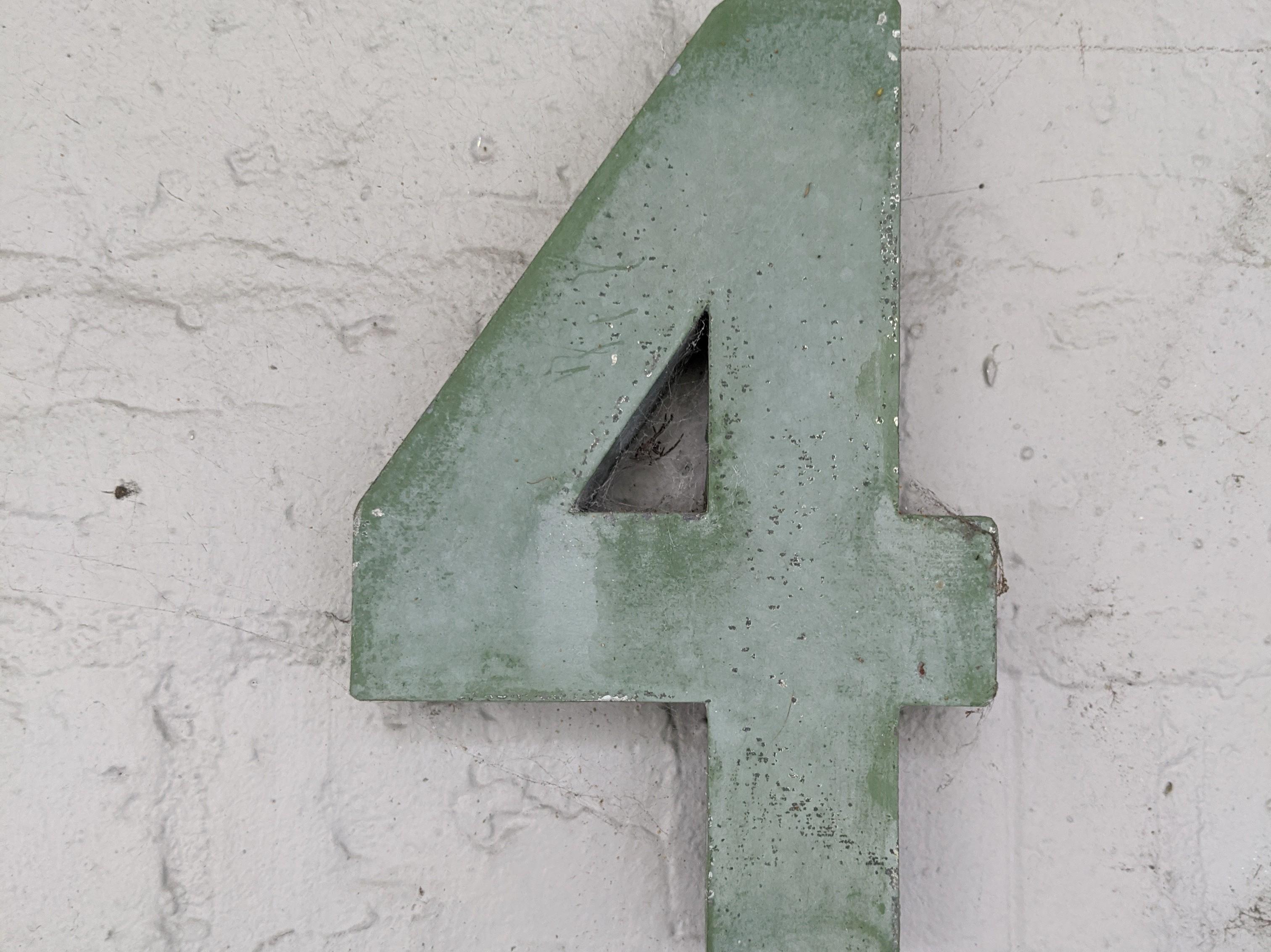
my new life down under: four years on
Posted 17 July 2020
Each year that passes living in Australia feels like an achievement and so there'll always be a place for it on my Australia Blog to mark it and reflect. Today I've been living in Australia for four years and embark upon my fifth.
Even though I share the edited highlights, my 'Aussie show reel' if you will, it goes without saying that it has also had some very tough moments. As I anticipated when emigrating, Australia was unlikely to be all sunshine and koalas. And I was right. But it has been an experience that has reinvigorated my day to day life; it's all too easy to become stuck in a rut in your forties and to stay where you are, no matter how crap it is, simply because it's safe and familiar and easy. I believe growth comes from change rather than sticking with what you know. It's the reason why I've always pushed myself, choosing to place myself in stressful and challenging situations when there were far easier options available. I've often used geographical changes as a way of challenging myself: each university was progressively further from home: 110km, then 315km, then 450km. A move to Australia, some 17000km, was the ultimate geographical move.
I couldn't help but notice that, fittingly, the door number to my house above, which took on new significance on this day, has a very Aussie spider living in the aperture of '4' - can you see him?
broken hill & back: road tripping the nsw outbacK
Posted 12 July 2020
We hit the vast open road to sample a substantial slice of Country and Outback New South Wales. From Wild West-style Gold Rush towns to surreal lunar-like landscapes, this was a road trip to end all road trips.
All in all we spent seven days road tripping from east to west, stopping overnight in motels - often for just a single night - before re-loading the car with our bags and provisions and hitting the road again. Some days involved just a few hours in the car, others up to seven. Some days, remembering that the journey is the destination, we would take time out to pull over at tiny towns for a pit stop. Places like Cobar, Gulargambone, Walgett and Pooncarie offered respite with a hot cup of coffee and often a slice of toasted banana bread lathered liberally with butter. With at least 1500km covered on the State's roads (most tarmac, some lake beds, some unsealed dirt tracks) we experienced a significant slice of Country and Outback New South Wales - more than most travellers ever get to see of this giant sunburnt country and, some would assert, more than most Aussies themselves. The trip gave me a new-found understanding of Australia's complexity and problems, a greater appreciation of how terrifyingly vast this land is, and a realisation that you don't always need to fly long haul to some country on another continent to behold incredible landscapes. Sometimes the incredible is on your metaphorical doorstep.
Click the image above to travel to the full Travel Chronicle.
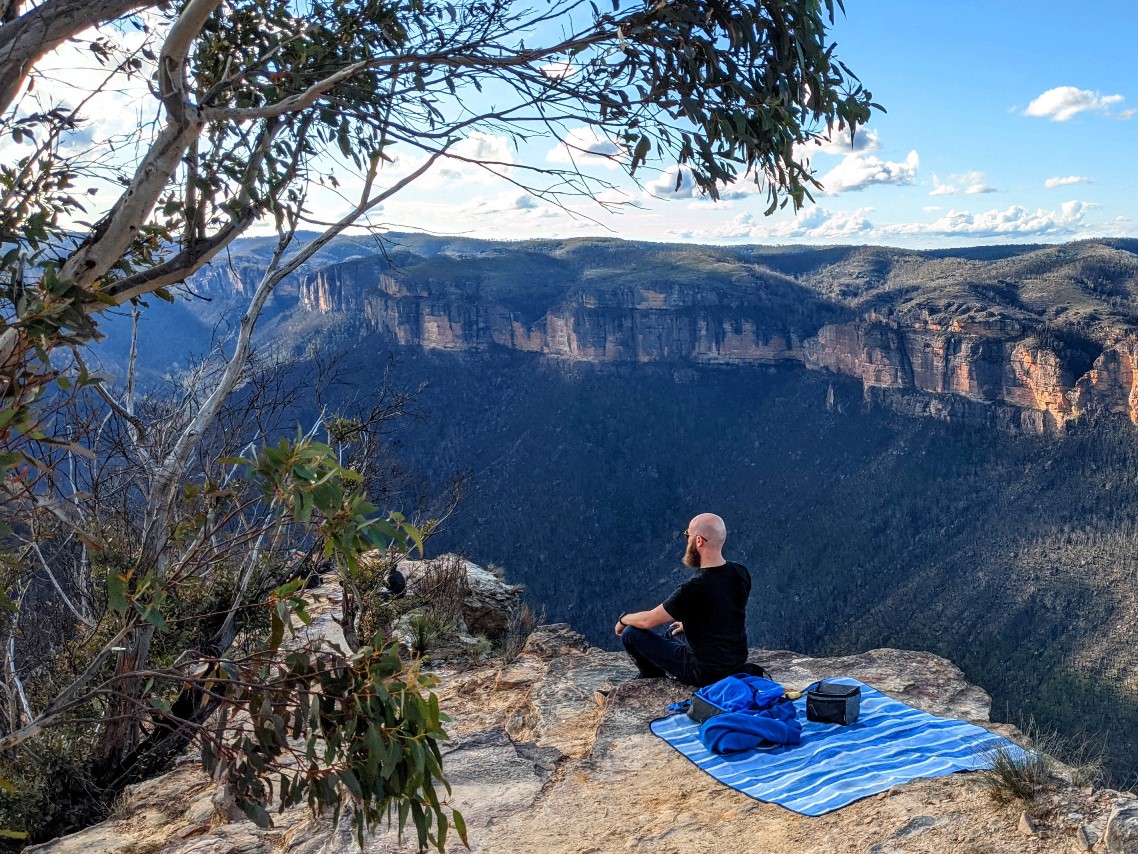
picnic at hanging rock: blackheath to burramoko ridge
Posted 20 June 2020
We headed out to find Burramoko Ridge, more commonly referred to as Hanging Rock, in the Blackheath area of the Blue Mountains region. We were already running a little late but had to make the most of the Saturday as it was the only day forecast to be blessed with sunshine (there's nothing worse than heading on a bushwalk only to arrive at a vista of wilderness for it to be shrouded in cloud). Sat at home furiously searching through online lists of walking trails and bushwalks close to the big smoke, courtesy of Time Out Sydney, it became slightly dispiriting to get to the end of every list only to realise that we'd done them all and, those we hadn't, would take us most of the day to drive to - if not more. So, we opted for the ever-reliable Blue Mountains region 100km west of Sydney. I say reliable because, whenever we've been there, we have always left feeling content with how we've spent our precious outdoorsy hours. I have a natural inclination to disfavour going to places I've already been to - it's the 'Littlest Hobo' in me; I just want to "keep movin' on". Still, with only the day to play with it was here or nowhere. And at least we would be going somewhere. And we hadn't been to Hanging Rock either, I mused. And the name sounds interesting enough, I mused further. There had also been a recent Australian televison drama called 'Picnic at Hanging Rock' (we'd tried to watch it but, like most of the televsion out here, it was below par and we didn't get past the first hour) and so here was an opportunity to have an actual picnic at Hanging Rock. There seemed to be a certain satisfaction in being able to say we'd picnicked at Hanging Rock - even if we hadn't liked the programme itself. It had a certain evocative, even ominous, ring to it.
The 5.5km bushwalk from the Baltzer Lookout car park took us through a sandy, medium difficulty fire trail made more notable by its blackened trees and vegetation from the recent bushfires, by its assortment of my favourite indigenous plant the Grass Tree, and its open heathland offering moody views of the bluey Blue Mountains in the distance (it's nice to see that the Blue Mountains continue to live up to their name after my first visit to Blackheath back in 2015). Baltzer Lookout was a picture postcard spot to unfurl the picnic blanket, pop open the Thermos flask, pour a steamy coffee and eat an obligatory Carman's Bar (it's an Aussie brand of biscuit I've become accustomed to). We were only intending to stop at the Baltzer Lookout, with its incredible aspect across the Grose Valley, but ended up being magnetically drawn to scrambling further down the escarpment to Hanging Rock herself. The sight of it was truly vertigo-inducing; a large shard of sandstone, it has broken away from the cliff edge - a large slit of open space making the step from cliff to tilting rock a dizzying and dangerous prospect. The sense of danger was accentuated by an absence of protective fencing, leaving bushwalkers exposed and prone to tumbling off the cliff hundreds of metres into the valley below. I didn't fancy my chances; I don't have the stomach for this kind of thing. Instead I satisfied myself with taking incredible photographs of the rock set against the blue mist of the interlocking mountain range behind. I didn't really expect to see anything like this when we'd set out five hours earlier. But that's Australia for you: incredible scenery and unreal sights are almost ten a penny out here. I am lucky indeed.
The only issue with a loop track is that you have to do a 360 degree turn and walk back the way you came. I hate that. I suppose it's the 'Littlest Hobo' coming out in me again. Still, the sun was beginning to set low against the horizon casting a very different aspect on the way we had come, so much so that three quarters along the return trail we became convinced we'd taken a wrong turn. That fencing. We didn't see this on the way here. I definitely didn't see that sign. Our phone batteries were running low, the Blue Mountains is notoriously cold at night (somethimes below freezing) and most daytrippers had vanished. It was one of those moments in which you savour your own naivety and foolishness. But, with few frantic checks online and a passing cyclist questioned, we were confidently strolling onward: it was the same track we had walked along but which was so unfamiliar - another reminder not to be too hot-headed out in the Bush because it can bite you back. Hard. With the micropanic over, we were soon safely ensconced in the car and hurtling towards the State capital satisfyingly tired. The Blue Mountains. She did it again.

bushwalking the wattamolla to eagle rock track
Posted 07 June 2020
After months of being couped up in small white rooms with only the odd trip to a Woolworth's supermarket to break the monotony, the great Aussie outdoors never looked so, well, great. As restrictions began to ease across the state of New South Wales, which meant that being away from your immediate locale was no longer a fineable offence, we searched for an easy day trip away from the claustrophobia of the city - a city which, over the last few months, has increasingly represented a dystopian future of deserted streets and shuttered businesses populated by unsettling solitary souls wearing masks. Go somehwhere. Anywhere will do. Just got to get out; nature, views of wide open spaces, air. B-r-e-a-t-h-e.
We opted for a trip out to the Royal National Park with a walk from Wattamolla to the aptly-named Eagle Rock. The easy saunter through the bush was mostly covered by metal walkways snaking at sharp angles through the brush and bracken. The 7 kilometre route was busier than you may normally expect but this was the first weekend where restrictions had been eased and it was a perfect winter's day. The track was a mixture of sooty, blackened trees - a reminder of Australia's bushfire nightmare of the summer - and lush, young, lime-green vegetation springing up from the bush floor. The track took us via the incredible Currancurrong Waterfalls; two seperate jets of water pouring over the cliff edge and into the Pacific Ocean, jets made all the more impressive by recent rainfall. The dark, phallic stamens of scores of Grass Trees erupted two or three metres up, puncturing the sky and in doing so created a Jurassic, otherworldly vista which thankfully felt like a million miles away from the city. Eagle Rock, so-called because in profile it resembles the head of an eagle, struck a dramatic shape against the rich blues of the winter sky and, as you can see above, was an awesome photograph opportunity which brought the day to a fitting close.

australia's black summer
Posted 19 February 2020
The summer of 2019/20 has been particularly bad - and certainly unlike previous ones I've had here. Sure, it's been hot as expected. I was actually looking forward to that. But the blue skies have been replaced by grey ones. And the sun no longer a golden yellow but an angry red. This was the summer of the bushfires which turned Sydney into a choking, smoking nightmare - a city increasingly populated by city dwellers wearing protective face masks like something out of a Sci-Fi film. The sun glowed red and angry in judgement some days, on others appearing like an unholy smear or gaping wound in the sky. Some days the air quality was so bad that Australian cities, principally Melbourne, Canberra and Sydney, ranked the worst in the world ahead of major cities in the developing world notorious for their toxic air. On one particular day the air was full of smoke from the Gosper's Mountain fire and those in the Blue Mountains as well as sand from a dust storm - all heated to an horrific 41 degrees. The air was like soup and the digital display on my indoor air quality monitor jumped into flashing red figures I have never seen before. The air was toxic - inside and out. People died. Houses were destroyed. Billions of incredible creatures burned alive. With only a few weeks left it's fair to say that the Summer season feels like a bit of a write-off. I feel cheated but at least I only lost a few days at the beach or a few moments sipping an iced coffee outside my favourite cafes. Some people lost a lot more.
northern territory: australia's iconic outback
Posted 07 December 2019
After three and a half years of living in this giant sunburnt land I finally made it out to what could reasonably be called the 'real Australia'. It's an Australia a world away from the generic glass towers and relative luxury of the coastal state capitals where most Australians live. It's a part of Australia with an aesthetic so powerful and unique that it's iconography resonates around the world. Don't kid yourself into thinking you've 'done' Australia until you've experienced Uluru; it is only then that you can claim to have seen the real Australia - for Uluru is Australia and Australia is Uluru.
Click the above image to be taken to the full Travel Chronicle for this trip.

beginning the long road to citizenship...
Posted 24 May 2020
Yesterday I finalised my application for Australian Citizenship and clicked “submit” to something which has been whirring in the back of my mind for some years now. It’s a largely uninspiring bureaucratic process but one which undoubtedly deserves a place on my Australia Blog, if only for reasons of posterity.
Having developed something akin to PTSD following our obtaining of Permanent Residency Visas back in January 2016, I must say that I have been dreading clambering back into the bureaucratic boxing ring with the now named Department of Home Affairs. I know from experience how the Department’s demands can blindside and dash hopes. I know how sluggish, even glacial, the process is. I know how frustrating it can be. And so I approached this latest, and hopefully final, stage in my Australian journey with trepidation and a fair dose of anxiety… I logged back into my old “Immi account” which had pretty much laid dormant for the last four years aside from the odd login driven by a morbid curiosity to reacquaint myself with an old foe – much like a victim compelled to visit the place where they were attacked. This time, however, at least I was armed with some experience and some understanding of how this all worked, I mused.
Even following the absorption of the ‘Department of Immigration and Border Protection’ into the ‘Department of Home Affairs’, the same ash grey form greeted me on screen, into which my particulars were duly entered. This was an application for citizenship ‘by Conferral’ – the route someone takes when they already have a visa, have lived and worked in Australia for a sustained period and have made “a contribution”. Many of the details were to be expected: visa grant numbers, date of first entry into Australia, details of parents, documentary evidence uploaded and dates of any trips abroad outside of Australia - no mean feat for someone who has hitherto visited 91 countries. Details checked and checked again (on second checking glaring errors were noticed and corrected) I clicked “submit” knowing it was a significant moment in the story of my Australian adventure and, no less, my life generally. The last four years have been leading to this moment; it is not permitted to apply any earlier than four years into your visa, during which you must have been in Australia for at least nine months of each year (they’ll be no activating your visa and then jetting off back home for six months of the year, for instance). Having activated my visa in March 2016 but then returned to the UK for three months to do really small things like sell the house, ship all worldly belongings and organise pet migration, the date when I could apply had to be carefully calculated on a spreadsheet. That date was May 20th.
The current processing times displaying on the Department’s website are thoroughly depressing but are as expected: 75% of applications are processed within 14 months, 90% within 23 months. The pandemic may also increase these wait times. At least this is plenty of time to prepare for the Citizenship Test I will be required to undertake: 20 questions of which I will need to answer at least 15 correctly. I’ve already tried my hand at the Department’s practice test online and passed. It seems that watching the ABC News Channel as frequently as I do has yielded unexpected benefits. The rest of the questions were common sense – especially for someone like me who heralds from a country based on the concepts of freedom of speech and democracy. People from other countries may struggle more than I.
What will citizenship mean to me? Most importantly it will mean that I can relax and settle. Living in limbo with a “Permanent Visa” which, actually, isn’t very permanent is all rather unsettling. At the end of the fifth year, my ‘permanent’ visa will sort of ‘expire’. This is no problem whatsoever if, for instance, I never wish or need to leave Australia’s borders; I can stay here as long as I like and so, in a way, it is permanent. However, if after five years, I wish to jet off to Fiji for a few days, additional bureaucracy and cost will be necessary to get back into Australia. Citizenship brings peace of mind and a sense of permanence not offered by the misnomered Permanent Resident visa. Wish us luck!

waitara camping: snake encounters along the colo river
Posted 20 February 2020
I didn't expect to be using my new sleeping bag, purchased a few months ago for my Duke of Edinburgh camping trip at the end of 2019, quite so soon, but a change of jobs meant that I was soon packing my bags for another stay under canvas.
This was a two day, one night camp out in Waitara, two hours’ drive north of Sydney. Down in the valley along the Colo River, there would be no mobile phone coverage. For. Two. Days. This time it was with twenty twelve-year-olds who had swapped cosy bedrooms for functional tents, and city lights for twinkling stars. I'm a long way from Bear Grylls but I felt a little less apprehensive as I'd done this before. I knew what worked and what I'd need. Half the stress about these kinds of things, I’ve learnt, comes from the preparation and anticipation rather than the actual execution.
Parts of Waitara had been impacted by bushfires and then the worst floods seen in NSW for three decades. The camp had only just partially recovered meaning our first day was pretty muddy and grim. On arrival the heavens' intentions were heralded by a giant clap of thunder which shook base camp. I quickly wished I'd brought an umbrella - but at least I had my waterproof jacket. The torrential rain phased out the already weak internet and so, apart from a lonely landline, which, incidentally, hadn't been working the day before, I felt marooned in the middle of nowhere - ridiculous considering we were still well within the Sydney Basin.
I was assigned a special tent which came complete with raised decking, table and chair and foam mattress. It wasn't exactly glamping, but it was comfortable enough and certainly a couple of tiers up from Duke of Ed in 2019. The stars sparkled beyond anything I think I've ever seen before. The only thing I could compare it with was looking up at the ceiling of a fancy lift, like those you see in hotels with lights which kitsch-wise seek to recreate famous constellations. I slept soundly; a night of good sleep interrupted only by the very strange sounds made by an Aussie creature of unknown description and danger level which, it appeared, had taken a liking to the decking upon which my tent was perched. I rocked in the bed and the noise ceased. The auditory landscape of this, my only night at camp also came complete with the sound of two possums fighting at the perimeter of the camp somewhere in the darkness of the trees. Later, the Kookaburras, with their loud maniacal laughs brought, what is to me now, a familiar dawn chorus just as my alarm sounded at 6am - a strategic move on my part to ensure I could use the corrugated tin toilet in peace without the kids milling around. There was just time to use my cafetiere to brew a coffee on the stove and mix up some milk and cereal before heading out to day two, a largely uneventful affair which became dramatically much more so on my return to camp later that afternoon...
The camp had been empty for most of the day and, with the heat having reached around 35 degrees, the lawn became the perfect sunbathing spot for a brown-coloured snake, which had chosen to catch the rays no less than a meter away from the raised decking of my tent. Being the responsible adult for 20 children, and needing to maintain credibility, gravitas and authority I committed to handling it like a consummate professional. I screamed the entire camp down. The serpent was about half a metre long and was brown. Simon (aka 'Simmo') our guide told me it was either a Whip (harmless), Tiger (painful) or Brown snake (deadly). I had been wondering only recently when I would finally get to see a snake; people talk about them quite regularly here and, I figured, it was only a matter of time before I did. I’m rather glad that the snake was just as scared as me slithering quickly, as it did, into the bushes as I approached.

duke of edinburgh: hiking 25km of the great north walk
Posted 30 October 2019
This was the longest and hardest hiking trip I have ever been involved in, hiking, as I did, a touch over 25km across two days with ten teenagers, one overnight stay in a damp tent and one guide from 'Boomerang Adventures' as part of the Duke of Edinburgh Bronze expedition. Just sauntering through the wilds of my favourite national park, Ku-ring-gai, chatting away and taking in the general awesome wilderness was a pretty reaffirming way to spend 48 hours. The 25km was comprised of nearly 1km in the ascent up steep, rocky mountainsides and nearly 1km in the descent - both of which played havoc with my knees and hips. I used muscles I never knew I had and which had been well and truly awoken from their century-old slumber. It was rather wonderful to wake up on my second morning, quietly unzipping my tent flap so as not to wake our guide, to enjoy the rich blue of daybreak and the morning chorus of Kookaburras and a very clever Lyrebird which, my guide was to later inform me, had taken to mimicking the siren of a fire engine. In my Pommy naivety I thought perhaps another bushfire had broken out.
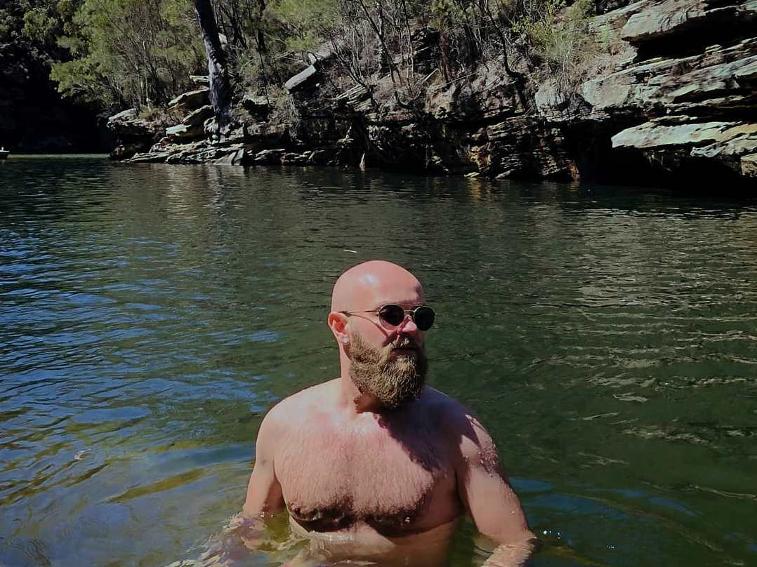
going native: creek swimming in the royal national park
Posted 20 October 2019
This was a bushwalk through a part of the Royal National Park, commencing from Winnifred Falls and heading along a fire trail down to South West Arm Pool. We stopped off for half an hour to admire Winifred's understated but pretty falls, pitching up our picnic blanket on a giant boulder overlooking the pool. We were surveyed by a sceptical and cautious Australian Magpie which took to hopping from tree to tree as if to visually mark out its territory for our benefit and understanding. There was just time to enjoy a cup of coffee from the Thermos before feeling our way through the brush down to South West Arm Pool where I had what can only be described as my Aussiest moment yet: I went swimming in a creek with the little fishies to cool off after bushwalking and sporting my new pair of budgie smugglers (an Aussie brand, too, of course).

road tripping: the nsw central west
Posted 08 October 2019
This was the farthest inland we’d ever travelled in the State of New South Wales. Australia is largely a coastal country and it’s this part of Australia which gets most of the glory. And so, with a long weekend thanks to the Queen’s birthday, we decided to head 250km inland from Sydney to what is commonly referred to in the local tongue as “country New South Wales” – the bit of land that resides in-between coastal Australia and the red desert of the legendary Outback. I’d heard so much about “the country”; its vineyards and orchards, its crippling drought, dodgy infrastructure and its wholesome simplicity. The descriptor “the country” is used almost pejoratively as well as an excuser - as if the fact that it’s “the country” justifies a multitude of sins.
The reality is that a trip out to “the country” is the point at which the infrastructure and creature comforts you’ve come to expect as standard in the State capital rapidly fall away. However, the adjective “country” may act as a euphemism for something akin to ‘roughing it’ but it is used romantically too because it’s a chance to get away from all that is wrong in the big cities. And this is the reason many head out here. The country is a part of Australia characterised by quaint and endearing family businesses, endless winding roads, mostly empty, cutting through landscapes which could be anywhere in southern England, wildlife signage warning of wombats or kangaroos ahead as well as the joy of any Aussie roadtripper: the “lookout” arrows pointing to the promise of incredible vistas (but only if you have the time to pull over and walk up a steep track in thirty degree heat). It’s also a part of Australia “doing it tough” and so, I’d argue, it’s incumbent upon those living in the luxury of the city to visit every so often to spread the Aussie Dollar around - just don’t use too much water whilst you’re there!
The distance we needed to travel from Sydney meant that an overnight stay somewhere was unavoidable. A sad fact about Australia is that outside of the main State capitals accommodation consists largely of campsites and low-grade and, it has to be said, slightly creepy, motels. It was the latter we found ourselves in – an unappetising ‘Ibis Style’ whose name was clearly a misnomer sporting, as it did, the complete lack of any. It had everything I have come to expect from an Aussie motel from our previous road trips; crap breakfast, paper thin walls and a distinctly no frills experience. These motels are like this because, put quite simply, their main clientele are unfussy truck drivers travelling “interstate” or hikers and families using it merely as a place to crash before setting off at the crack of dawn the following day. There’s also a part of the Aussie national character which, I think, secretly loves this ‘back to basics’ experience.
We chose the country town of Orange to spend the night and, using the hire car to its maximum, travelled thousands of kilometres all over New South Wales’ Central and Central West regions, with stops at Jenolan, Oberon, Kanangra-Boyd and Bathurst. In Orange we drove to the top of Mount Canobolas and walked the 2km return hike to Young Man Canobolas through worryingly dry bushland, a short descent and ascent mountain trek which had me, embarrassingly, puffing for air. Birdsong from the odd Kookaburra and Crimson Rosella parrot punctuated acted as the soundtrack to our thoughts. At 1400m above sea level, our bushwalk was accompanied by a refreshingly cool breeze. A steep ascent along the trail to Pinnacle Lookout afforded us 360° views of Orange the following day; a largely flat landscape which, I assume, is responsible for this region’s “Tablelands” name. Kanangra-Boyd National Park, in the Central Tablelands region, offered us awesome views of interlocking mountains, a wilderness covered in Eucalyptus trees as far as the eye could see. A stop off in Oberon for a coffee and toasted banana bread fuelled us for some more exploring at Jenolan. A walk along Blue Lake Jenolan – so called because the minerals in the water have turned it turquoise – brought me face to face with an Australian Water Dragon, an incredible creature which took to basking on a rock along the water’s edge. He was perfectly content to lap up the attention he was garnering from those passing by. Satisfied with an incredible wildlife encounter – without doubt the best part of visiting the country – we set off back up the mountain, navigating both steepness and hairpin bends. As if bestowing one last gift upon us, our trip into the country was rounded off in the best possible way by the spotting of two beautiful Wallabies carrying joeys in their pouches. We quickly joined a small throng of mostly Indian tourists by the roadside and just enjoyed the sight of yet another incredible wild creature encounter.
And with the sighting of Wallabies, our trip into “country New South Wales” came to its conclusion. The clock was ticking and the bright lights and artificiality of the city beckoned. Exploring the Central and Central West of the State was a glimpse into what I’d probably say was a more authentic Australia, geographically but also metaphorically far removed from city life in Sydney which, comparatively at least, isn’t very Australian at all.

bushwalking into spring at america bay
Posted 02 September 2019
It was the dying days of the Sydney Winter and the ideal weather to go for a walk in the bush: the skies were a rich blue but the air only a balmy twenty degrees – not too hot, then, to be traipsing along dusty paths through bushland made up of scribbly gum, eucalyptus trees and some of the most exquisite little flowers springing into bloom. This was a short bushwalk from the incredible West Head on the edge of Ku-ring-gai National Park, with its sumptuous view out to Lion Island and Barrenjoey Lighthouse, and downwards to the scenic America Bay. It was the first road test of our new ‘day bag’, put together with thought and care to contain everything we could possibly need for a day trip: cool water bottles (x2), pot of nuts for a snack, basic first aid kit, cool lunch box, thermos flask, charger cables – you get the idea. The bag is packed and ready for whenever we want to escape the big city for a few hours. The Bay’s views across Cowan Water, with a little waterfall gushing behind us, was the perfect spot to pause for a snack before heading back up the escarpment to West Head. A week or so later the first day of Spring, theoretically September 1st, was declared but, as our short trip through the bust to America Bay testified, Spring was already well on its way. I’m quite looking forward to a Summer of bushwalking and beaches. How Australia has changed me.

morning has broken: a bondi daybreak
Posted 20 August 2019
Even though I've lived in Australia for over (quite unbelievably) three years now, and even though I’ve ambled over Bondi’s white sands several times – most notably on Christmas Day and for Sculpture by the Sea, I realised last week that I haven't seen the sun rise over what is undoubtedly one of the most famous beaches in the world. I checked with a work colleague who assured me that I’d have no problems in beholding an awesome rise on Bondi (it’s always worth checking with locals - they know stuff a million internet searches could never yield). And so my alarm was set for 05:30 on Saturday morning – not an appetising thought considering I am up at this time each weekday for work and by Friday relish the prospect of an extra hour on a Saturday. Still, I do like seizing the day in this way; I hate sleeping in and watching the day, and its possibilities, pass me by. So 05:30 it was to be and, with a bit of a jolt, we were out of bed, albeit a little bleary eyed and unquestionably a bit grumpy. There was just time for a shower and an online booking of the hire car parked just in the next street before we needed to be hurtling our way to this most famous bit of Aussie coastline.
By just gone six we had braved the decidedly nippy temperatures of a Sydney Winter morning and were heading south east toward the Pacific Coast. We were soon on the familiar sands of Bondi (in an ancient Aboriginal tongue Bondi means ‘water breaking over rocks’). Knowing that Sydneysiders are early risers it wasn’t surprising to see elderly runners, a couple of relatively serious photographers and, of course, scores of surfers who I could see in the distance bobbing around in the waves like little black beetles. Within minutes (we had timed it about right) the amber glow began to rise over the headland towards the north and soon took to lighting up the ocean in striking pastel colours. The beach began to fill with more people who were all there to witness the spectacle of daybreak on Bondi beach. This included several people who stood deadly still with their eyes closed, arms outstretched to the ground and facing the waves – a pose not dissimilar to Gormley’s Iron Men at Crosby Beach. It was a bizarre and unsettling sight but, having lived in Sydney for three years I am certainly used to those. Sydney does kooky and strange very well indeed.
After about half an hour of an intense and dramatic sunrise the clouds suddenly swooped in and darkened the scene; it was at this point that I captured the photograph above of a surfer just heading into the water. It’s a miracle this photograph came out as good as it did because, just at that moment, a large foamy wave broke the shore and gobbled my trainers (or is that ‘sneakers’?) whole –much to the entertainment of a young couple who’d wisely made themselves at home just further up the beach. I staggered backwards comedy-wise but it was too late; my feet were drenched in icy cold Pacific water. It was time to go. A warm breakfast at our favourite café back in Pyrmont beckoned.
I looked at my watch. I’d had a great experience and it was not even 8am.

the day the cockatoos dropped by
Posted 06 July 2019
It's such a treat when the Sulphur-crested Cockatoos visit the gum tree above my house. Despite often seeing this loud, feisty creature, in a large ‘crackle’ reasonably frequently elsewhere as I go about my day to day life in the city – often en-route out to Bondi and back – they rarely visit where I live, which is why it’s noteworthy when they do. Coming from a country where the most wildlife I can expect to see on a day to day basis would probably begin and end with ‘pigeon’, I take great delight when I get to see such a beautiful creatures in my own literal backyard.
Everyone knows when the cockatoos are in town thanks to the loud cawing sound they make (fact: Australia has the loudest birds in the world). This often gives me time to grab my digital camera from the sideboard drawer; its zoom function allowing me to see close-up what’s going on in the tree above my house. In the photograph above one of them is picking the bark off the tree, the branches of which dangle over our tin roof, looking for the ants which live underneath. On several occasions during this visit, the cackle dislodged rotten gum tree branches, which came crashing to the ground. Standing underneath the gum tree as they pick at the branches you either risk (a) a large branch hitting you in the face or (b) being covered in ants as they too fall to the ground. A visit by the Sulphur-crested Cockatoo, then, is not without its dangers.
The other birds which normally call this gum tree home, namely the Rainbow Lorikeets and the Noisy Miner Birds, were not, judging by their behaviour, as pleased about the Cockatoos dropping in as I am...
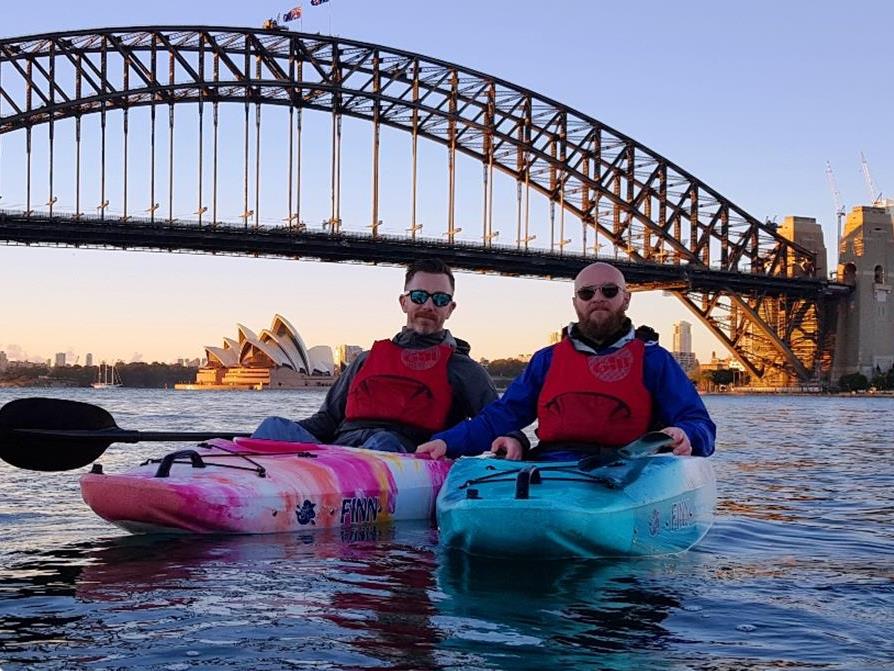
sydney bucket list: dawn kayak from lavender bay to blues point
Posted 15 June 2019
After a tough week at work where I’d struggled to get a decent sleep for days, pretty much the last thing I felt like doing was to be up at the crack of dawn in the Sydney mid-winter. Still, what would probably have been a wash-out of a Saturday spent recovering on the sofa turned into one worthy of a post on my blog. Sometimes the most rewarding things demand that little bit of extra effort. So, with our clothes carefully chosen the night before, a 05:30am alarm set and an Uber booked, we headed down to Lavender Bay at a time in the day when Sydney is all dark and silent and when the winter sun is only just stirring. I must admit, after having got over the early start to my normal sleepy Saturday, I do attest to the spiritual benefits of seizing the day in this way – even if it is a jolt to a tired teacher’s body.
We arrived at Lavender foreshore, cleared up a booking error (which meant that our ‘kayak and coffee’ experience was, in reality, now just a kayak experience), donned on our lifejackets and were soon sliding off into the glassy waters of Lavender Bay, passing bobbing boats, dinky jetties and mooring posts. My hands were soon cold as inevitable drips and splashes ran down the paddle bar, onto my hands and all over my legs. Sydney’s ferries were not yet running and so we were able to kayak to Blue’s Point, past the iconic Luna Park fairground and, in doing so, paddle under one of the most famous bridges in the world. Four years ago I climbed over the top of it and now I was kayaking under it.
With every stroke of my paddle the city sky brightened, bursting into its familiar golden glow which bounced off of the business district’s corporate glass. Heading back against the tide and firmly into the bright sunshine, we docked at Lavender Bay – distinctly cold and damp but elated that we’d done something pretty cool with our Saturday and it was only 9am…

back to the bush: return to ku-ring-gai
Posted 24 March 2019
Ku-ring-gai never fails to disappoint. After countless weekends spent on the beach, a trip into bushland was well overdue - especially as heading out for bushwalks at weekends was such a defining feature of my 2018. I've always thought of Sydney's Northern Beaches as extra wild, predominantly because of my first visit to Ku-ring-gai where I happened upon a Goanna fighting with a Brush Turkey. With only a small part of this incredible national park - the national park where the famous 'Skippy the Bush Kangaroo' series was filmed - explored, we returned to Ku-ring-gai for a little bit of Aussie adventure.
Aside from a couple of wrong turns, we bushwalked along the Birrawanna and Gibberagong tracks. Trying to convince myself that I'm some kind of rugged manly type, sporting my beard and walking bare-chested through the bush (it was rather hot), I was soon reduced to a screaming banshee as a giant Goanna dashed out of the grass and shot up the trunk of the nearest tree. I have no doubt that my shrieks of fear could be heard back in Sydney CBD. My first thought was that this flash of a reptile was a deadly Aussie snake about to sink its fangs into my calf and so, perhaps, my girly screams were warranted. Still, it was a reminder, if any were needed, that it's wise to keep your eyes peeled when walking in the bush; more often than not, the bush inhabitants see you before you see them. Walk with caution.
It was invigorating to be back out in bushland; the melodic bird song (Australia has the loudest birds in the world), the strong smell of eucalyptus (pine-like) and the wild vegetation comprising of fern-covered forest floors, knobbly and bobbly-shaped tree trunks twisted and contorted like painful limbs and spikey Banksia cones.

the summer of beaches
Posted 01 March 2019
Now that the summer in New South Wales is officially over, it feels like the right time to reflect on what has gone as I head into my third winter in the Southern Hemisphere. 2019 was the year when I finally embraced the beach lifestyle. What's the big deal? Everyone loves beaches, right? Well, not really. With so much to see and do in tightly-packed travel itineraries, I always felt that time at the beach was time wasted. But living here opens up a new world of possibilities not afforded to the cash and time-strapped visitor.
So, with a cool box (in Aussie vernacular an 'esky' - presumably an abbreviation of eskimo), a pair of Aussiebum budgie smugglers (all the rage Down Under) and some fabulously colourful beach towels bought specifically for the purpose (no need to snatch the drag ones from the bathroom any more), we set out to explore a tiny fraction of the many hundreds of beaches around Sydney: Terrigal Beach, Little Bay Beach, Little Congwong Beach, Rose Bay Beach, Double Bay Beach and Mona Vale Beach. The fact is that, with so many to choose from, there's a beach for every taste: busy beaches heaving with bodies, secluded and tranquil beaches, family beaches, gay beaches and even a few nudist beaches.
Sometimes taking a book to read, having a swim in the ocean (I lost my expensive sunglasses at Terrigal thanks to some violent waves) and catching an all-over body tan isn't a bad way to spend a day which is pretty much too hot to achieve much else. Like many a stupid Pom before me I did, on occassion, forget the Aussie maxim of 'slip, slap, slop' and ended up rather burnt. A favourite beach of ours was Little Congwong, a peaceful little beach on the fringe of the Botany Bay National Park, an adults-only beach without children screaming, without unidentifiable inflatable objects bouncing along the shore in the breeze and without sand being kicked in your face.
2019 was the year I embraced my inner-Aussie and in doing so left a little bit of the Englishman in me behind. I'm now, quite unbelievably, willing on the 30+ degree days so that I can don the budgie smugglers, ice up the esky and roll out the rainbow beach towel. And I never thought I'd ever say that. Bring on summer 2020...
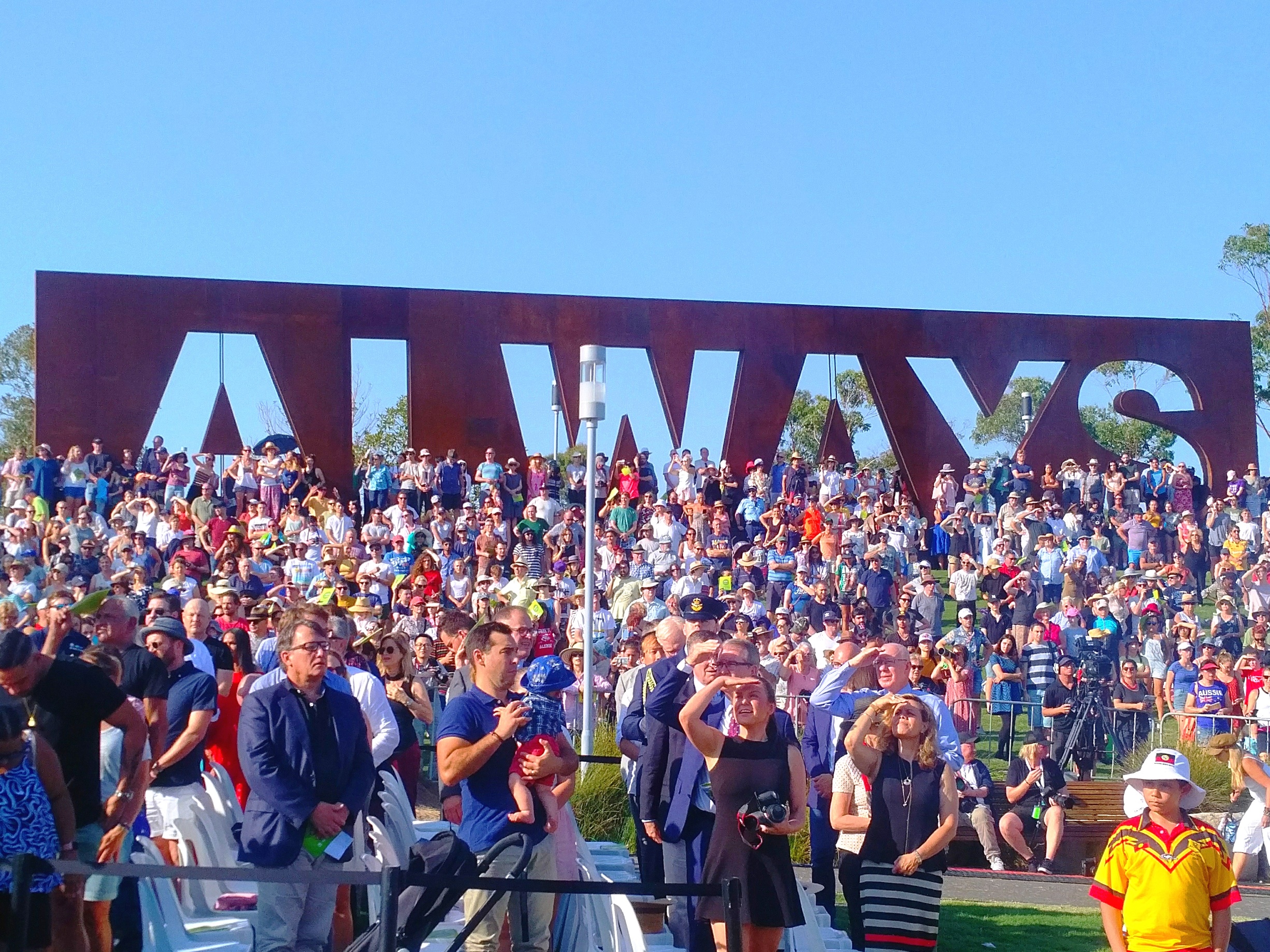
australia day: the wugulora at barangaroo
Posted 28 January 2019
Australia Day remains controversial. Depending on who you speak to, it is Australia Day, Survival Day or Invasion Day. Perennial calls to “change the date” seem to be growing ever louder with each year that passes. Australia Day is the point at which celebration and commiseration, politics and identity, and Australia’s dark history, as well as its achievements, intersect. No matter who you are or where you come from, it is a debate which is all encompassing and difficult to avoid. I attended Australia Day events last year; I remember the clouds being heavy and the air thick with humidity. We stood on the foreshore at Milson’s Point looking towards the Opera House watching the ferrython, being blasted by the gun salute and terrified by the apocalyptic sounds of the fly past of military aircraft. The Australian flag was rendered into every conceivable shape and object: scarves, flags, T-shirts, thongs. There seemed to be only one rule: if you can, stick a flag on it.
Last year we’d missed the opening ceremony at Barangaroo being, as we are, still a little out of sync with events taking place in the city. However, on the morning of the 26th January 2019, Australia Day, I woke up and switched on the television as normal (the ABC, not commercial - of course). Replacing the anticipated breakfast programme was the WugulOra Opening Ceremony which was broadcasting live from Barangaroo a mere two kilometres away. With breakfast bolted and shower water splashed we were soon in a taxi hurtling towards the headland of Barangaroo Reserve.
Barangaroo is a place of significance for Indigenous Australians being a frequent spot for hunting and fishing prior to colonisation. Indigenous use of this site dates back around 6,000 years and was named after an Indigenous woman who mediated between colonisers and the colonised but who, importantly, did not support her husband, Bennelong, working with the colonial government. The naming of this place is therefore highly symbolic. After much controversy and political outcry, a six hectare slice of the Barangaroo area was redeveloped as a reserve with its pre-colonial shoreline shape restored (having been cut and chopped to make way for wharves and other commercial port functions) using giant sandstone blocks from the area and a plethora of plant species native to Australia.
I must confess to an in-built bias here which is contrary to what some may expect: as a Briton I am not really interested in the British things this country has to offer if, for no other reason, than they are already familiar. I didn’t come all this way to be in a version of Great Britain with a warmer climate. Indeed, because I am British I am conversely drawn to those things which set this land apart and make it different from the one I’ve emigrated from (conversations like, “Oh you’ll like that place, it’s just like an old English pub – right down your street” and “that town is very English – you’ll love it there” are currently resurfacing in my mind whilst writing this). I positively shy away from Australia’s very British-looking buildings and delight, instead, in its Federation-style of architecture and slightly creepy terraced housing with its iron lacework. Put simply: I delight more in Australia’s differences and less in its similarities.
Thus, it felt only fitting that I was to spend my Australia Day morning on Barangaroo. This year carried additional significance thanks to the impressive ALWAYS sculpture by Jacob Nash, the single word rendered in rust an allusion to the phrase which has been gathering momentum for some time now: “Always was, always will be Aboriginal land”. Now, I'm not the biggest fan of sculptures; so many feel contrived, are devoid of meaning or exist for their own sake, appearing to be little more than pointless spatial embellishments or ‘clutterous’ urban candy floss. But ALWAYS’ position on Barangaroo headland overlooking Sydney Harbour and out towards the steel of the Harbour Bridge was uncompromising and dramatic, as if one metal installation was facing off another. In front of this giant sculpture sat the Premier of New South Wales and the soon-to-be Governor General, the Queen’s representative in Australia, both watching the WugulOra ceremony and, all the while, cameras brought the spectacle to an Australian television audience. Yours truly appeared wandering through the crowd as a mere few pixels for a few fleeting seconds just as the programme credits rolled with the suitable soundtrack of a didgeridoo playing. Within minutes of the ceremony ending, Barangaroo emptied leaving ALWAYS more photogenic than before – especially against a half of bright blue sky and half of deep green grass. Whilst one side is rusty, the other is coated in mirror – a symbolic invitation for some to reflect on Australia’s history.
Beautiful singing emanated from further up the hill to which we wandered – in heat now topping 34 degrees. The beautiful Marliya choir, a group of young Indigenous singers from Cairns in Queensland, rounded off a very special morning on Barangaroo with incredible singing and dancing.
Experiencing the WugulOra ceremony at Barangaroo on Australia Day is a chance to connect with an Australia nearly lost, a chance to get somewhere close to the spirit and soul of this giant sunburnt land. There is something about the visceral sounds and sights of Indigenous Australia which whisk you beyond the country’s present to something far deeper and more ancient. And, watching the WugulOra, a performance by people belonging to the world’s longest surviving culture, from its prominent position on the harbour? The Sydney Harbour Bridge. Built in 1923.
AT home with the quokkas in western australia
Posted 13 January 2019
Australia is all about its magical animals. I've written on this blog about them before and, I suppose, it was only a matter of time before I did so again. A journey back to the United Kingdom offered the prospect of taking the route via Perth on one of the world's longest flights for the return leg - and the chance to get up close with one of the country's cutest creatures: the Quokka. Rottnest Island is one of WA's most popular tourist draws because of them. Quokkas, the cute little marsupials which hover somewhere between giant rat and Wallaby, are the State's answer to the Kangaroo, Koala and Tasmanian Devil. Apart from one area in WA's far north, Rottnest is the only other place where you are likely to see these cute and placid little creatures. To see the full Travel Chronicle of this trip, click the image above.
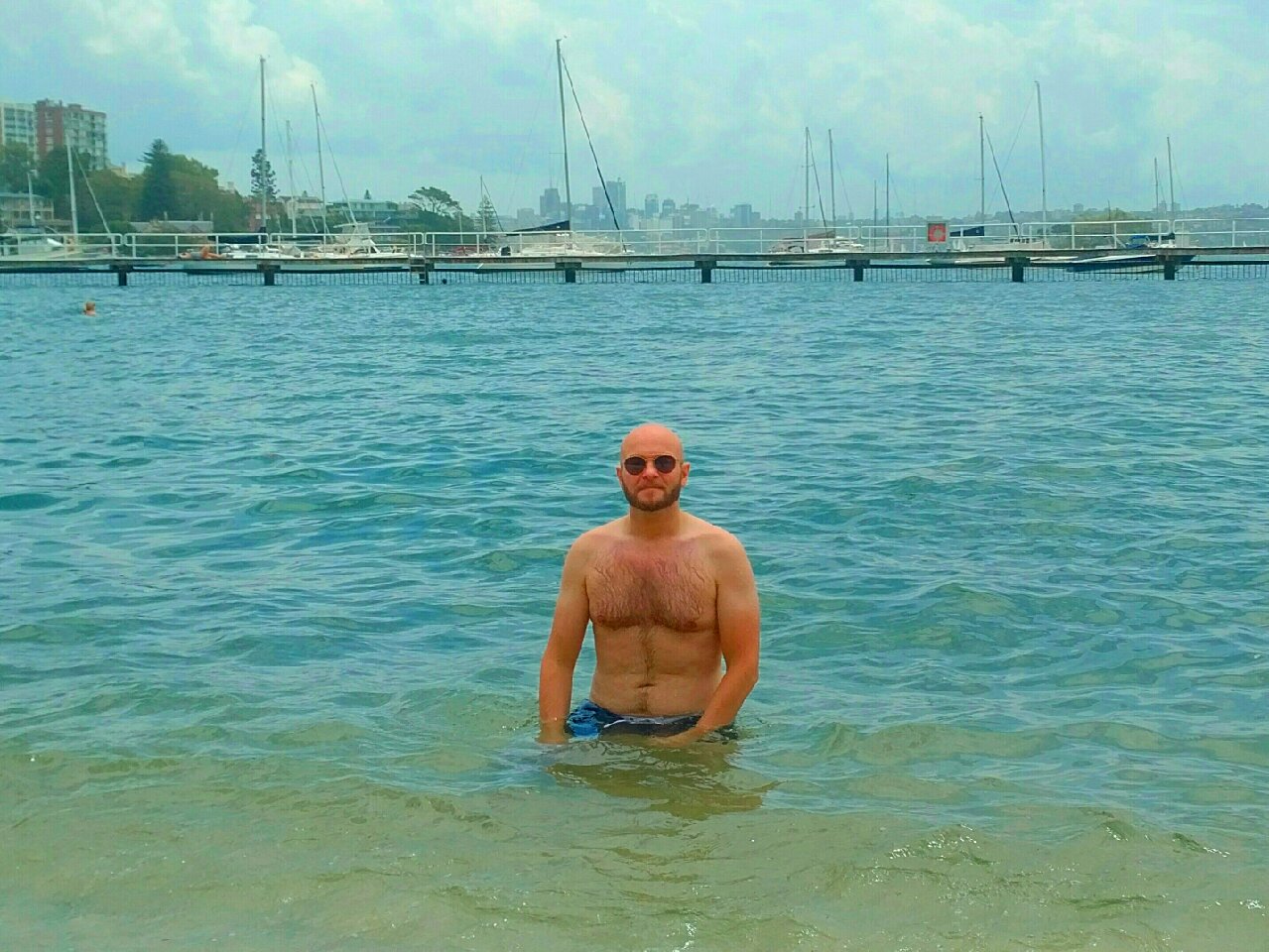
sydney ferry adventures: rose bay to double bay
Posted 16 December 2018
Sydney is a harbour city with a network of ferries connecting up its harbourside districts and beaches. It's always worth hopping on one to see where it takes you if you've got nothing better planned. Rose Bay is a bit of a favourite spot of mine: it's beautiful and, perhaps more importantly, not overloaded with day trippers. We arrived at the little Rose Bay wharf and, with a little walk eastward along the coast, we had a swim in the Murray Rose Pool - a nice little spot for a dip with sweeping views across the water to Darling Point and Sydney Harbour Bridge. An added bonus was that it had a shark-proof enclosure around it in the form of a metal fence - so nice to be able to go for a swim at an Aussie beach without fear of losing a limb. A couple of lengths in the harbour waters with little fishies swimming all around was followed by a walk of a few kilometres further along the coast to the upscale Double Bay for lunch. With a typically Aussie afternoon storm brewing the in the skies above us, our little jaunt around two of Sydney's pretty harbourside suburbs came to an end - making it home just in time to avoid the deluge.
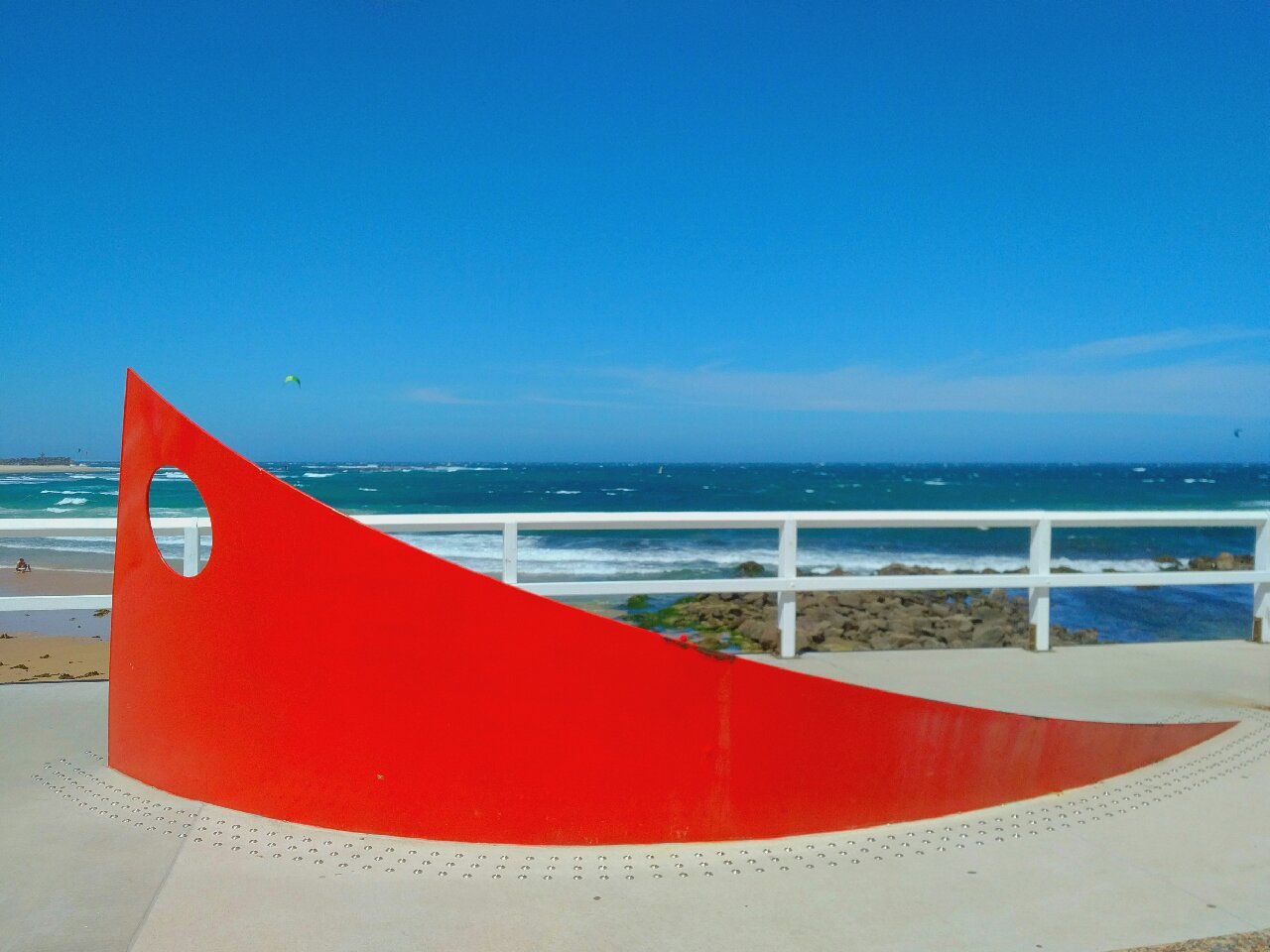
nsw central coast: a mini road trip to newcastle
Posted 9 December 2018
This was a mini road trip 160km northward to New South Wales' Central Coast region to visit a city with a familiar name: Newcastle. This wasn't Newcastle-upon-Tyne but Newcastle-upon-Pacific. Colonisers showed an incredible lack of most things, including imagination. The Australian version of Newcastle also has a 'Wallsend' and 'Jesmond' nearby, two districts of the English Newcastle. This mass imposition of a whole bunch of place names from a particular region of Britain onto foreign soil 11,000 miles away is all rather depressing and even more absurd. Not only are these names completely disconnected from the land which they claim to give expresion to, they bear no relation to the original place either. Still, a wander around its eerily quiet city centre, generally modern and with a distinct whiff of generic functionality about it, as well as a swim in the famed Ocean Baths, rounded off this pleasant little road trip outside of Sydney. Having lived in the English city of Newcastle for a short time, a trip here felt strangely necessary; I couldn't help but sense there was a degree of synchronicity about my visit here.
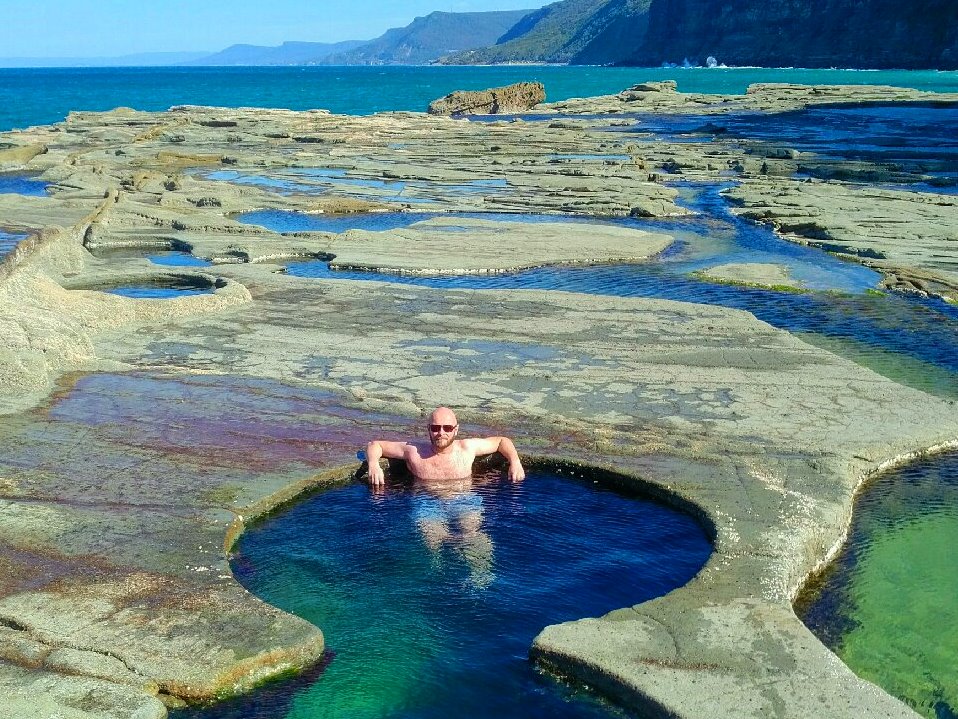
sydney bucket list: the figure eight pools
Posted 11 August 2018
The Figure Eight Pools in Sydney’s Royal National Park are not exactly easy (or pleasant) to get to. Following an hour’s drive and a $12 fee to enter the national park, a veritable nightmare of an assault course awaits you. The fact is, it’s a little bit dangerous to go there and the NSW authorities do as much as they can to dissuade instagrammers and tourists from going. Firstly the pools are in a location which put them, and anyone enjoying them, at the mercy of the vicious Tasman Sea which can quickly consume the dangerous rock platform within seconds. It’s all about timing, too, because some days the tide makes this most dangerous of places unreachable. Time it wrong and you could easily get stranded and require rescuing. I’m slowly realising that in Australia very little seems to be predictable and safe. Access to the pools comes courtesy of a sharp descent through the bush which, at certain points, feels positively vertical. The well-trodden path is all but broken away, leaving only giant tree roots and forest debris as your only means of getting purchase on the ground. After around thirty minutes of slipping and tripping we emerged onto the open at the ominously named Burning Palms Beach for a further twenty minute walk under the merciless rays of a Sydney sun. It’s at this stage that you feel that you must be getting close. Nope. Following this we had to scramble over a positively lunar landscape of giant boulders – many at least twice the size of myself, before having to ease our way around a dangerous cliff edge, holding onto the sheer rock jutting out. Only then did we arrive at very flat, but very slippery, ground – made all the more interesting by the incredible tessellation patterns and small rock pools containing bright red crabs and multi-coloured starfish.
A small group of people had gathered around the pool. The tide was not due in for some hours and the site of this small natural wonder was beginning to buzz with visitors both foreign and native. A couple of local Aussie ‘bogans’ (slang for rednecks) were taking it easy smoking marijuana nearby. It was a quick dash around the side of a boulder for a Wonder Woman-style change of clothing; from shorts to swimming trunks. I tentatively made my way over to the most famous of the pools – the one with two circles which have met in the middle, forming a figure eight. It goes without saying that the water was absolutely arctic and, with a little encouragement of “Go on mate, it’s awesome” from a local watching me edge gingerly toward and then back away, I jumped straight into the dark green yolk of the thing. Heaven only knows what creatures were swimming around in there. If the inhabitants of the small rock pools I had seen on my way over there were anything to go by, I probably should have been more careful. Still, after getting my breath back from the cold, sharp shock of the water, I relaxed enough to pose for the ‘money shot’ photograph every one like me comes here for.
With a banana consumed and a warm towel to dry off the cold, salty ocean, we begun the obligatory journey back over the tessellated pavement, along the beach, up through the brush and back to the hire car. It took two years, but we'd finally ticked off a Sydney must-do.
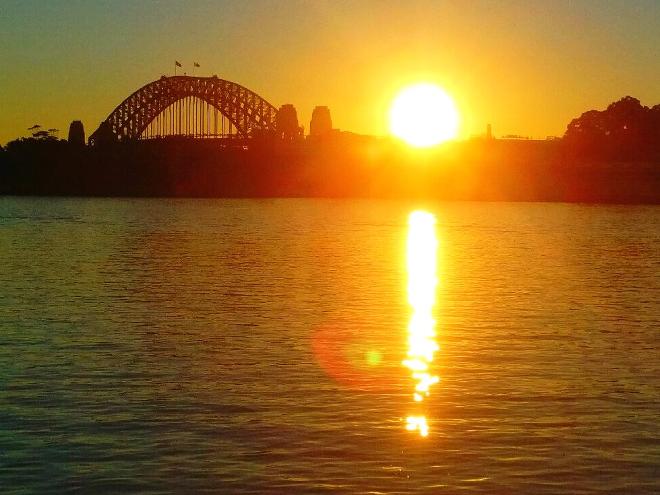
two years on: morning reflections at jones bay
Posted 16 July 2018
There are certainly worse ways to start the day. A quick saunter down to Pirrama Park at Jones Bay in the early morning to watch the spectacular sunrise over the Sydney Harbour Bridge is a tranquil, almost spiritual, experience; Rainbow Lorikeets greet you with a squawk from the hedgerows, small boats make their way along the harbour busying about some task or other, and joggers speed by. I made this trip down to the bay many mornings in a row, just delighting in the simple, peaceful beauty of it all and the astounding fact that I can be guaranteed a spectacular sunrise almost every morning that I bother to jump out of bed, shove on my tracky dacks and plug in my radio and head down in time for the 'rise. I feel lucky to live here. This was an idyllic way to spend a few consecutive mornings reflecting on what has gone and what might be to come as I made it to the second anniversary of my living here and headed, unbelievably, into year number three.
canberra: a road trip to australia's bush capital
Posted 21 May 2018
Located in the north of the Australian Capital Territory, a tiny slab of land by Australian standards and the smallest state or territory by far, the ACT is fully enclaved inside the state of New South Wales. It is also the only Australian state or territory without its own slice of coastline. It is fully land-locked and so one thing's for sure: they'll be no surfing in the ACT. The fact is that Canberra is a very curious capital city known for its war memorials, politicians and seemingly infinite number of roundabouts and certainly not for its nightlife and counter culture.
Ultimately, Canberra is a place comprised of disparate and contradictory ingredients, with even its nick-name of the 'Bush Capital' seeming to allude to its antithetical, even paradoxical, personality. The Australian capital hovers somewhere between faded Sci-Fi city and the Hanging Gardens of Babylon. A wander around it stirred memories of past places so divergent in nature that I struggled to categorise Canberra succinctly. The fact is Canberra actively defies categorisation - and perhaps this is its biggest landmark. As Griffin himself was to assert, Canberra "is a city that is not like any other in the world". I think he was right.
We headed back into the nearest town for lunch. The town of Morisset is west of Lake Macquarie and very much a local place for local people. Spoilt for culinary choice as Sydneysiders, we were forced to put our snobbery aside to satiate our hunger in one of the few eateries open: a fried fish burger and chips it was to be. With more fat downed in one meal than arguably I'd had all week, we set off on the journey south to Sydney. Without any planning, our departure from Morriset coincided perfectly with the 15:30 feeding of the Pelicans at a place called The Entrance. Scores of pelicans make their way to 'Pelican Plaza' from their sandy island on Tuggerah Lake for a daily treat of fish. The giant birds, with their pink beaks, electric blue feet and flapping wings, descended on the plaza creating an awesomely wild spectacle and rounding off a wonderful day getting up close to Aussie wildlife. Yesterday's wild encounters came on the back of two others recently: the first when a Sulphur-crested Cockatoo took to perching on my shoulder in Glebe followed only a week later by a large Possum which ran across the road in front of me in Bondi. All in all it's fair to say I've been rather blessed recently. All I'm waiting for now is for a Koala to wave me off to work tomorrow morning...
Click the image above to travel to the full Travel Chronicle.
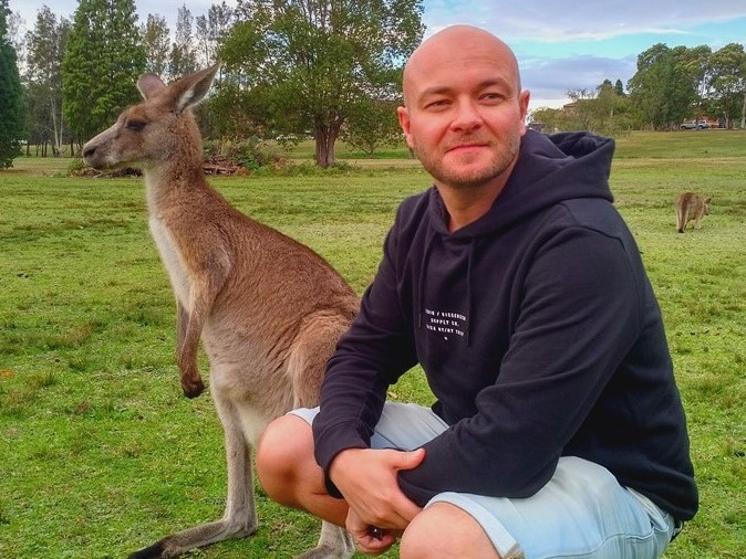
kangaroos & kookaburras, pelicans & possums
Posted 12 May 2018
If God gave children an opportunity to create their very own animal I have no doubt they would design the Kangaroo. Despite having lived in Australia for nearly two years now, I never get to see these magical hopping creatures. There's a distinct lack of 'roos in central Sydney. So, if the mountain won't come to Muhammad, then Muhammad must go to the mountain...
This mountain came in the shape of a mini road trip northward to New South Wales' Central Coast and the 'roo-renowned Lake Macquarie. It's never wise to get your hopes up when wildlife is involved but approaching the lake after a two-hour slug up the freeway it became clear we were in luck. A mob of around fifty kangaroos grazed and hopped in the forest clearing: giant bucks, does and little joeys poking out of pouches. We were there for just under an hour, walking around different pockets of these iconic creatures. Some lazed in the brush, others bounded up to us for a sniff hopeful for a carrot (despite signs instructing the contrary, many visitors feed the 'roos). The magic ended abruptly when an idiot in his ute pulled up with a giant dog chained up in the vehicle's tray. A burst of barking saw nearly every kangaroo bound, stampede-wise, into the safety of the forest - one nearly colliding with me as it fled. Within a few seconds nearly all were gone apart from the hardiest of bucks. Walking back to our hire car, and muttering our frustrations under our breath, another Australian icon appeared on a branch above us: the Kookaburra. Safely ensconced high up, it was completely unperturbed by our presence (and the barking canine), allowing me to capture some beautiful photographs of what is perhaps Australia's most famous bird.
We headed back into the nearest town for lunch. The town of Morisset is west of Lake Macquarie and very much a local place for local people. Spoilt for culinary choice as Sydneysiders, we were forced to put our snobbery aside to satiate our hunger in one of the few eateries open: a fried fish burger and chips it was to be. With more fat downed in one meal than arguably I'd had all week, we set off on the journey south to Sydney. Without any planning, our departure from Morriset coincided perfectly with the 15:30 feeding of the Pelicans at a place called The Entrance. Scores of pelicans make their way to 'Pelican Plaza' from their sandy island on Tuggerah Lake for a daily treat of fish. The giant birds, with their pink beaks, electric blue feet and flapping wings, descended on the plaza creating an awesomely wild spectacle and rounding off a wonderful day getting up close to Aussie wildlife. Yesterday's wild encounters came on the back of two others recently: the first when a Sulphur-crested Cockatoo took to perching on my shoulder in Glebe followed only a week later by a large Possum which ran across the road in front of me in Bondi. All in all it's fair to say I've been rather blessed recently. All I'm waiting for now is for a Koala to wave me off to work tomorrow morning...

high-fiving penny wong at sydney mardi gras
Posted 03 March 2018
I wasn't able to go to the famous Sydney Mardi Gras in 2017; I'd been struck down with a cold and, besides, it was also tipping down with rain. “I'll go next year”, I thought - after all, if you live in Sydney, experiencing the Mardi Gras - even once - is a must do. So, I joined 500,000 other revellers in lining the streets of the Sydney suburb of Darlinghurst - the hub of gay and lesbian life in the state capital to experience the Mardi Gras at an historic moment in Australian history. It has been a long road to acceptance for the gay community in Australia. As recent as the mid-1990s, gay men were being thrown to their deaths from the cliffs at Bondi and Tamarama beaches by groups of men out for night-time blood sport. Some of these deaths remain unsolved.
And so, in this context, Mardi Gras 2018 was rather special; momentous, even. It was the first Mardi Gras since gay marriage was legalised in Australia in November 2017 and it was also the festival's 40th year, the first having taken place back in 1978 when a handful of protesters were bundled into the back of paddy wagons, beaten by NSW State Police in the cells of Darlinghurst Police Station and later publicly shamed in the Sydney Morning Herald newspaper. These trailblazers have since become known as ‘The 78ers’.
We arrived early, around five o'clock, but thousands were already there having come well prepared with collapsible chairs, picnic baskets, water bottles (with vodka or gin in) and obligatory rainbow paraphernalia. These were clearly professional and experienced Mardi Gras goers, unlike us. Budding entrepreneurs, mostly Chinese, sold cheap plastic chairs for $10 or scavenged milk crates for $5. Others strutted up and down flogging rainbow flags of varying sizes and of varying quality.
Arriving so early, through sheer poor planning rather than by design, meant that we managed to get ourselves a great spot along the temporary fencing running along the famed Oxford Street and thus a perfect view of the parade. All we had to do was wait. For over two hours. Helicopters powered overhead, crowds gradually swelled and the daylight dropped. Giant fruit bats, with their unmistakable wings, began to circle overhead. The 'Dykes on Bikes', 'the 78ers' and the 'First Nation' groups officially opened the parade, only to be followed by a crazy assortment of wonderful, multi-coloured characters. Two of my favourites were the pink Dalek sporting a feather bowa and a jar of Vegemite renamed 'Sodomite'. Cheers, high fives and “Happy Mardi Gras!” could be heard in-between the blasts of pop tracks from the floats as they passed by. Indeed, a member of the Equal Marriage procession, I managed to high-five Senator Penny Wong. Her name won’t mean much to a non-Australian. However, if you live in Australia you can’t help but know her as the Labor senator for South Australia and current Leader of the Opposition in the Senate (I watch a lot of news and knew instantly who she was). Her tearful reaction when the 61.6% Yes equal marriage result was announced quickly became a defining, iconic moment of Australia's journey to marriage equality.
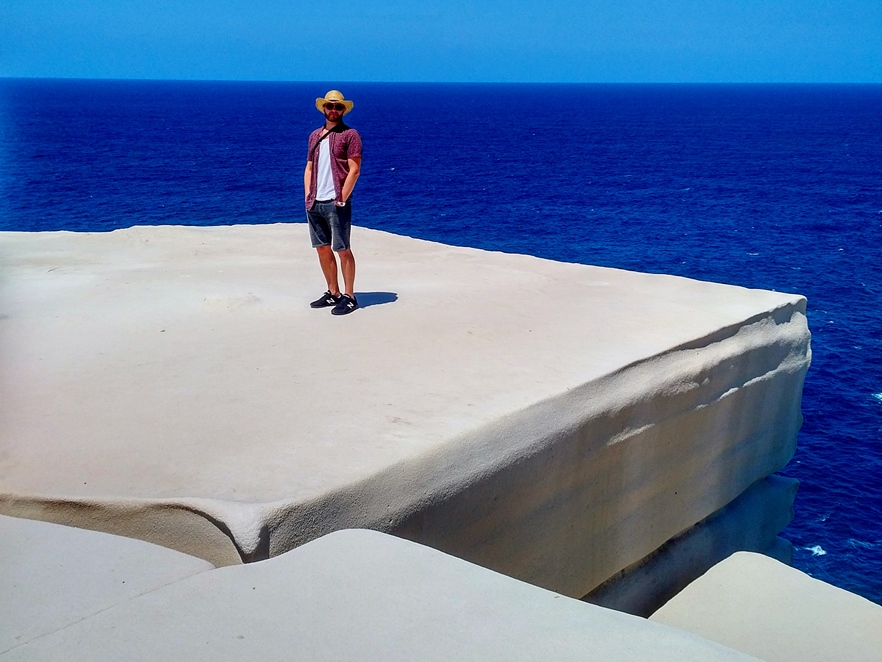
sydney bucket list: wedding cake rock
Posted 17 February 2018
Wedding Cake Rock in Sydney’s Royal National Park is an unusual rock formation along the challenging Coast Track walk. The formation gets its name because it is the geographical equivalent of a slab of cake wrapped in white icing, its sharp right angles and bleached appearance contrasts dramatically with the rest of the yellowy sandstone cliff. It’s about as photogenic as a cliff can possibly get but, alas, its collapse into the pounding ocean below is highly anticipated. This doesn’t stop people, including me, from clambering over the safety fence installed by park authorities, to stand on this chunk of white rock marzipan with an incredible backdrop of the Tasman Sea. The journey from Bundeena and along the track was a beautiful one, lined, as it is, with stunning lookout points, vivid colours and natural rock patterns.
bushwalking the ku-ring-gai: the aboriginal heritage walk
Posted 16 December 2017
Hiring a car for the day we headed northward across Sydney’s Harbour Bridge and out to the Northern Beaches to bushwalk through another New South Wales National Park, this time Ku-ring-gai. Whenever I see the yellow NSW NP logo, featuring a bird splaying its feathers and a stylised boomerang into which the letters ‘NSW’ are set (left), my excitement begins to build. It’s a symbol that I’ve come to associate with wild, unspoilt Australia - and Ku-ring-gai was really wild. Indeed, on approach to the national park, iconic yellow wildlife road signs told us to watch out for ‘Endangered Bandicoots’.
Within moments of pulling up in the Ku-ring-ai picnic area a Brush Turkey danced across the grass; seconds later a Goanna, a large prehistoric-looking monitor lizard with a uniquely forked tongue, ambled past, its head moving left to right and its tongue flitting in and out. The noise of crickets and who-knows-what-else was deafening and unrelenting, a cacophonic soundtrack which accompanied the Brush Turkey’s subsequent attack on the Goanna which then spiralled up the nearest tree to safety. To gather our bearings and apply some sunscreen (factor 50 of course) we plopped our bag down on one of the picnic tables only to notice that it was dotted with giant crickets which had no doubt fallen from the trees above and landed on the table – dying on impact. Temperatures hovered around 30° and, with sunscreen applied and several bottles of water packed into our trusty bushwalking bag, we set off on the 6km Resolute Loop Track.
A short detour allowed us to join the ‘Red Hands Track’ so-called because of the Aboriginal rock art known as ‘Red Hands’, an imprint of two hands made using red ochre clay and thought to be around two thousand years old. We were walking through the land of the Guringai people. Rejoining the Resolute route we headed south, east, north then west passing the wonderfully secluded Resolute Beach (perfect for a dip to wash away the heat and sweat – take a towel, some thongs and budgie smugglers with you) and the stunning vista of Barrenjoey Headland at West Head Lookout. Indeed, my photograph of the red hand cast in ochre now features on the official New South Wales Parks and Wildlife Service website (click image above to be taken to their page).
I have bushwalked through quite a few national parks, in both New South Wales and Tasmania, and in New Zealand, but the Resolute Loop was one of the hardest, comprising of more steep climbs and steep descents, as well as problematic paths, than I have come to expect. The name of this route, ‘Resolute’, was, perhaps, in hindsight, a hint of the challenges it poses. Disconcertingly, Ku-ring-gai national park is renowned for being the place where bushwalkers are most likely to get bitten by both poisonous snakes and deadly spiders. On several occasions I spotted large spiders suspended in webs above our heads. However, the most deadly of Australian spiders is to be found not above, but below. Heading inland from the coast for the final two kilometres of the route, I began to notice perfectly round holes in the ground, about the size of a $2 coin, the aperture of which was covered with a white web like a funnel. I knew exactly what this was: we were walking over the nest of the deadly Funnel Web, Australia’s most poisonous spider.
I said Ku-ring-gai was wild, didn’t I?
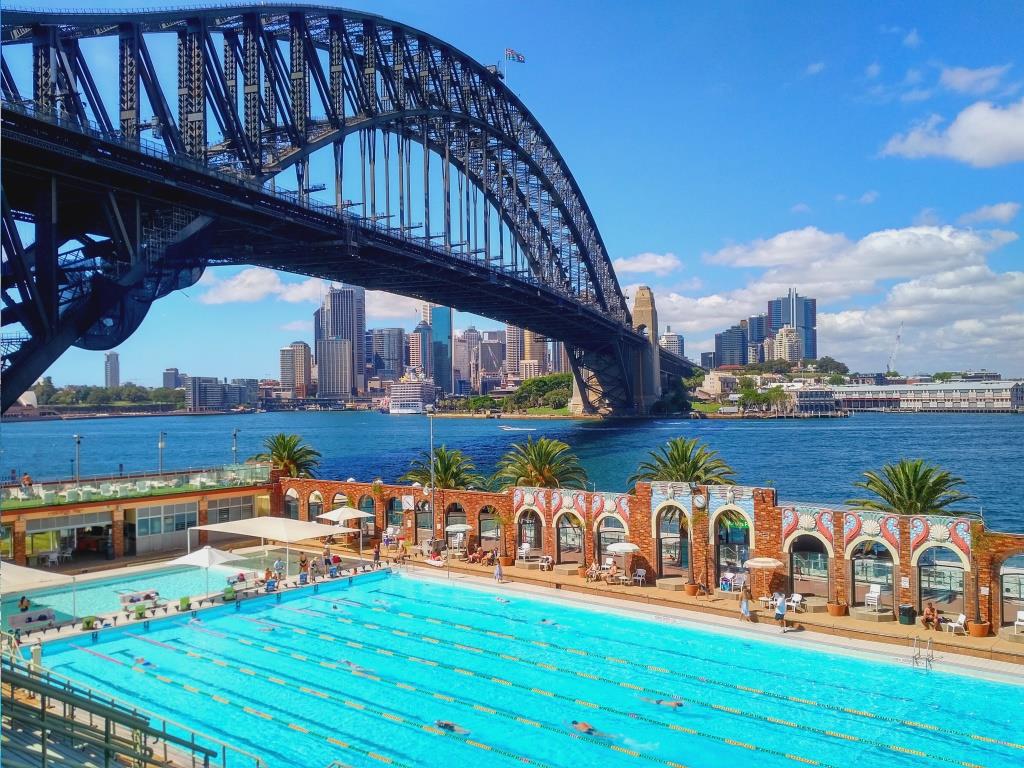
sydney ferry adventures: milson's point swim with a view
Posted 09 December 2017
Milson's Point is a few ferry stops from Pyrmont Bay. Luna Park, the harbourside fairground, is the reason the majority of passengers disembark here. It is, however, also the ferry terminal for the North Sydney Swimming Pool, an Olympic-sized Art Deco-inspired outdoor pool offering an incredible vista out across Sydney Harbour towards the towers of the Central Business District. The iconic Harbour Bridge, viewed from the top of the pool's seating area, stretches out across the water at a particularly satisfying angle (left). The pool's turquoise waters, the blue sky and the deep navy of the harbour offers what is, quite possibly, one of the best views to accompany your Saturday morning swim. Surprisingly the pool was full of salty water - something I immediately came to realise once diving in and gulping a load. Also surprising was the fact that, despite the beautiful weather, the sumptuous view and its central location, the pool was rather quiet. Perhaps most Sydneysiders were already on their way to the beach?

sydney ferry adventures: watson's bay
Posted 03 December 2017
Another Sunday and another chance to see an as yet unexplored stop on the Sydney Ferries network. With Sunday travel capped at an astonishingly low $2.60 on State transit (approximately £1.10 for unlimited all-day travel), which includes the iconic ferries, we boarded at our local wharf Pyrmont Bay and headed for Watson's Bay - Sydney's most easterly point.
Located at the end of the South Head peninsula and bordering the national park, Watson's Bay had a distinctly tropical air to it: lush palms swaying gently in the breeze, vivid summer colours, beaches gently humming with families and the noticeable presence of brightly coloured Hibiscus flowers. Despite teeming with day trippers like us, Watson's Bay felt laid back and unhurried. I started having flashbacks to my time on Kadavu Island in Fiji - especially when I spotted the Hibiscus.
A gentle Sunday saunter along its small but beautiful beaches on the promenade and up to the South Head Lighthouse took us past a nudists' beach (Sydney has several of these), a stunning vista of Sydney City in the distance and, quite incredibly, a large pelican which was completely unruffled by the people brushing so close to it. Seeing this pelican made my week: this wonderful prehistoric-looking creature was standing only feet away from me giving me time to compose a great photograph of it (left). Unlike the famous Mykonos pelican in Greece, this one hadn't had its wings clipped and was able to fly wherever and whenever it pleased. This made the moment all the more special.
Watson's must be one of the prettiest places in the Sydney area; I can say this with a degree of certainty now having had a fairly respectable go at exploring the must-see places of the Sydney Basin. I will be surprised if any other stop on the ferry network will better this little tropical village. We shall see when the Sydney ferry adventures continue...

bondi to coogee: the 6km coastal walk
Posted 26 November 2017
Australia is, in essence, a coastal country; its major cities cling to the edges of this giant sunburnt continent as if trying to escape the blistering heat of the 'red centre'. Sydney is, likewise, a coastal city and on any day with sunshine and blue skies, Sydneysiders flock to many of the little beaches which face east out into the deep blue of the Pacific Ocean. Beginning at the rather famous Bondi we snaked around the many 'fingers' of the coastline passing small coves and bays, many packed with sunbathers, surfers, spear fishermen, divers and friends having barbecues. This six kilometre hug of Sydney's Eastern Suburbs took us through the Tamarama, Bronte, Clovelly and Coogee beaches - each one in turn offering their own unique take on paradise: Bondi - international and iconic; Tamarama - pretentious but intimate; Clovelly - gritty and local; Coogee - a local beach for local families. Take two Poms, add six kilometres of beautiful coastline, mix in three leisurely hours, blend in a tuna wrap with a flat white and cook at a balmy 27 degrees for a perfect Sunday afternoon out of the city experiencing quintessential Aussie coastal life.

colonial reflections at botany bay
Posted 29 October 2017
A rather unremarkable and small stretch of coastline, punctuated by a rather unremarkable stone monolith in an unremarkable part of Sydney's suburbia, lies a place where something momentous and remarkable happened. The ordinariness of Kurnell at Botany Bay belies its historical significance in Australia's chequered and brutal story: this is the place where Captain Cook's ship The Endeavour first landed on Australian soil in 1770. Across the road from here sits the 'Endeavour Cafe', to which we paid a brief visit for a slice of quintessentially Australian banana bread and coffee. Am I the only one to think the name of this cafe is, at best, ill-judged?
A triumphant roadside board at the end of 'Captain Cook Drive' insensitively declares, "Welcome to Kurnell: the Birthplace of Modern Australia". Even on a sunny Saturday afternoon this place felt subdued and quiet; the odd Kookaburra sang and waves half-heartedly lapped the coast. A couple of families splashed about in the water, two men on jet skis competitively raced each other out to a very 'modern' skyline comprised of the industry and tankers of Port Botany, and a lone kayaker lazily floated by the rocky outcrop where an entire continent was stolen from Indigenous nations by the British crown; the natives first deceived, then slaughtered and later marginalised in their own country, with their beloved land used as a dumping ground for its thieves, murderers and "ne'er do wells".
Two glass panels on a small wooden jetty, set into frames of steel, look back at this uninspiring, generic Cook monument. The first panel features a striking photograph of a defiantly resolute Indigenous man with dreadlocks and face paint (left). The other offers a depiction of the moment Cook first made contact with indigenous people of the Gweagal nation. Both panels offer a glimpse of what this giant sun burnt country could have been had it just been left alone. As a traveller who appreciates authenticity and difference in the places I visit, I walked away feeling nothing but a sense of sadness and loss and with one lingering question: what if?
In silver lettering set into the footpath along this stretch of historic coastline are the words "Warra warra wai". Go away.

australia's taxing times
Posted 26 October 2017
Before you get excited, the title of this post doesn't refer to all those aspects about living in Australia I find challenging. This post is really about tax. Sorry to disappoint.
Where I come from, a tax return is something only the self employed person has to worry about. Down Under in Australia a tax return is everyone's concern. Just like voting, it is mandatory. It's something which I've been avoiding but, with the October deadline only a fortnight away, it was time to face yet another bureaucratic hurdle. Having had my fair share of run-ins with both Federal and State government departments, the thought of getting to grips with the Australian Tax Office system elicited nothing but groans and a mild sense of terror.
Unusually the weather was cloudy with intermittent drizzle - an opportunity, then, to nail this ATO thing and get it out of the way. Computers loaded up, receipts gathered, tense, pensive expressions on display...
Having previously set up a myGov account, and linked it to my ATO and Medicare accounts back in March 2016 when we were ensconced in an airBnB apartment in Sydney's less-than-desirable King's Cross area, the basic groundwork had already been laid. Logging into myGov and clicking on the ATO linked account took me straight through to a pre-filled form: one which, of course, already had my earnings for the year inputted by 'the system' as well as the interest I had earned on my Australian savings accounts during the tax year (which annoyingly differs from the UK tax year - I'll get to why this matters later). A difference from the UK system is that you receive all interest earned in Gross throughout the year, only paying tax on it once the tax return is made at the end of the financial year (EOFY for short).
Unbeknown to me, all of my UK accounts had switched to paying Gross rather than Net interest as I am no longer resident in the UK and therefore no longer pay tax there. This resulted in me adding up the interest accrued on half a dozen accounts - and doing so, month by month, within the parameters of the Aussie tax year and not the UK one. Bizarrely Australia will be taxing me on my UK money! The amount of interest in GBP had to then be converted into AUD using the ATO's online converter before having to be entered manually into the form by yours truly. After completing a whole bunch of tick box questions I finally arrived at the expenses section.
Collecting receipts throughout the year is a bit of a thing in Australia as you're entitled to claim back tax on most things connected with work. Not having collected receipts as religiously as the locals, I found myself consulting things purchased on eBay - a record of which was usefully recorded. At least I would get something back from my purchases online. This is the most satisfying part about the Aussie tax return; I was able to claim the tax back on things connected with work: desk fans, printer cartridges, the screen riser, the proportion of electricity used when working from home once per week (on a Sunday) and even wear and tear on the desk we bought last year.
Being made to submit a tax return, the first in my life, has had unintended consequences. What I thought was a bit of a burden has ended up making me feel like I'm in control of my finances. The Australian Tax Office even has an app which I now unlock with voice recognition and which allows me to photo receipts on the go in order to claim the tax back at the end of the tax year! I like the control (and responsibility) this system gives me. An added bonus was the unexpected discovery that I'd only worked for half of the tax year and was, therefore, due a significant tax reimbursement which, I might add, appeared in my bank account only four days later.
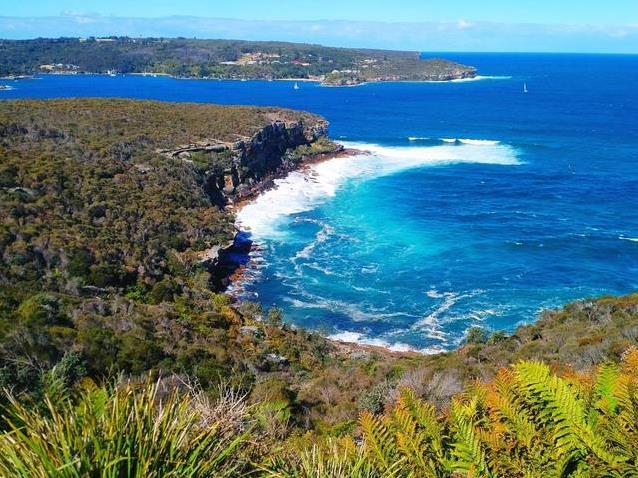
manly to spit bridge: the 10km walk
Posted 09 September 2017
Access to Manly, the starting point for our 10km bushwalk to Spit Bridge, came courtesy of what was, without doubt, the scariest ferry journey from Circular Quays I have ever experienced. Announcements over the Sydney Ferrys' tannoy declared that there was "abnormally large swell" and advised passengers to "secure their belongings". The ferry dipped and bobbed up and down, left and right as it rode the tumultuous waters. Unbeknown to me the ferry to Manly is known for this rather dreadful experience. Had I known, I'd have taken a taxi. Safely on terra firma, with stomach in tact, we commenced the ten kilometre trek along Sydney's stunning Northern Beaches coastline.
Coves, bays, beaches, jagged coastlines, bushland and views out into the Pacific Ocean (left - hover)are all part of the fusion of Aussie life along this four hour route. Curious, and frankly weird-looking, flora adorn the bushland areas of the walk whilst at Grotto Point some of the last remaining Aboriginal carvings in the area, thousands of years old, can be seen faintly etched, as they are, into the Sydney Basin sandstone. Seeing a Brush Turkey and an Eastern Water Dragon absolutely made my day even if, after 25,000 steps, I was utterly exhausted.

nsw south coast: kiama township
Posted 26 August 2017
Living in New South Wales presents a bit of a problem; its sheer scale (over three times the size of the UK) means that examining a map for your next day trip can be deceptive. Going anyway for the weekend outside of the state is virtually impossible and would likely require domestic air travel. This being the case we're always on the lookout for new places to see at the week's end. This lead us to the pretty township of Kiama on New South Wales' south coast. The name "Kiama" is derived from the Aboriginal word "kiarama", which means "place where the sea makes a noise", undoubtedly a reference to the Kiama Blowhole which erupts whenever the incoming waves crash against the coast.
Kiama is blessed with some striking colonial-era architecture, including the General Post Office and elegant white lighthouse. It also has a stunning Jones Beach and some striking coastal formations known as Cathedral Rock which draws many sunset-seeking photographers, including us, hoping to capture the rock's jagged outlines against a pink evening sky.
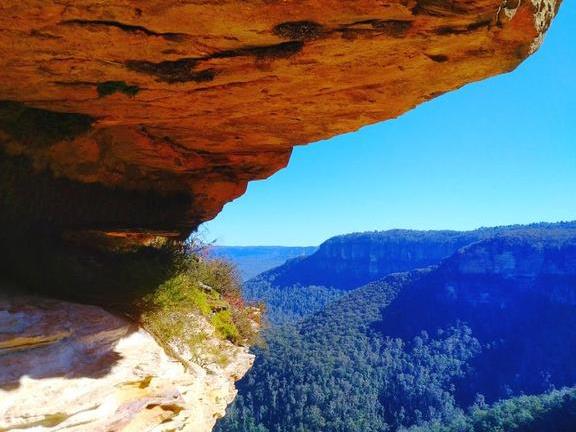
bushwalking the blue mountains: national pass walk
Posted 13 August 2017
The Blue Mountains region is so called because of the blue hue emitted from the eucalyptus gum trees spread across thousands of kilometres. The region acts like the lungs of Sydney, offering Sydneysiders a chance to escape the dusty pollution and soulless corporate towers of the CBD. This was our second visit to the Blue Mountains having journeyed here during our first visit to Australia in 2015.
Beginning at Wentworth Falls after a slap-up breakfast at the 'Blue Mist Cafe and Bookshop', we followed the 'National Pass' track, a three hour, four kilometres loop for "experienced bushwalkers" only, involving, as it does, a steep gradient and obstacles. The Pass affords you views of a truly awesome vista which, in my opinion, easily rivals the best in the world; that of Jamison Lookout, whose sheer immensity is a little vertigo-inducing. The Empress, Silvia and Lodore waterfalls peppered along the route in an area called the 'Valley of the Falls' added to the fairy tale magic of the place. It's quite easy to feel you are a million miles away from Sydney and, of course, that was the whole point.
a new life down under: one year on
Posted 23 July 2017
As a traveller you aren't often afforded the luxury of living somewhere for a sustained period of time; you parachute in, see the basics and, because time is money, parachute out again just as quickly - leaving with only a superficial sense of place and people. This particular Chronicle is, therefore, almost unique on my site; it's the result of living somewhere rather than merely visiting. This means I've had time to go beyond the predictable landmarks, get a sense of life here - from the ground up, and attend events and festivals I would otherwise have missed. Good or bad, all things are part of the wider experience of living in a country of which you are not native. Everything is interesting and daily life becomes one long tourist experience. And, of course, this is surely the whole point of emigration in the first place? One year on and I'm still in full tourist mode - my camera is very rarely off for long and my eyes are always peeled.
Out of all the places we could have lived in this vast continental country we, in a sense, defaulted to Sydney. We didn't really choose Sydney but, I suppose, Sydney chose us and there are worse places to start a new life Down Under. On my first visit to Australia in 2015 I must admit I favoured Melbourne over Sydney feeling that, aside from its giant bridge and iconic opera house, this 'Harbour City' seemed to offer little else. Sydney, like most international cities, can feel cold and corporate; its CBD (city centre) is a largely uninspiring concoction of anonymous financial buildings and retail outlets. Inevitably the tourist dollar skews the city even more towards a soulless candy floss. I came to Australia to be in Australia and enjoy the differences to home but, in places, if the truth be told, Sydney CBD could be absolutely anywhere in the world, aside from its smattering of colonial-era buildings which, despite the unsavoury and bloody past they allude to, serve to give the city some depth and history, a history which feels dangerously close to being engulfed by Sydney's over zealous development.

a cool winter's day at summer bay
Posted 26 June 2017
Fifty or so kilometres north of Sydney, and around an hour's drive, brings you to the rather unassuming Palm Beach. By Aussie standards it's nothing special. By British standards it's beautiful - and famous...
It's 'winter' in Australia now; whilst this does mean torrential downpours on occasion (and I mean torrential), it also results in large stretches of the week being characterised by crisp blue skies with bright sunshine and balmy temperatures hovering around twenty. Desperate to see more of Australia, albeit confined to New South Wales owing to its giant size, we, on the spur of the moment, decided to hire a car and head north to the beach which doubles as 'Summer Bay' in the Australian soap 'Home and Away'.
Aussie soaps resonate strongly with British expats, the colour and character of this distant, exotic country offering an escape from what were probably, for many of us, grey days in a colourless urban landscape. It was only a matter of time before us two Poms made the expat pilgrimage to Palm Beach - the place we'd seen, tantaslisingly, on our teatime TV screens so often growing up.
Despite its notoriety 'Summer Bay' was near empty, save for a cluster of die-hard surfers, a few Sunday walkers in contemplative mood and a pod of dolphins which playfully made an appearance as we arrived. A couple of laps of the bay was justification enough for a fish roll and chips purchase from the North Palm Beach Surf Club, one whose exterior doubles as the beach house in the soap. Indeed, a Summer Bay sign hangs above the surf club's doorway with a reference to the "Club Patron: A. Stewart" - one of a few clues that this location is one with a televisual double life! If you're no fan of Aussie soaps, I can highly recommend a visit here anyway - it's beautiful, quiet and the fish and chips was the best I've tasted so far on this giant, scorched continent. The only danger is that you'll probably end up humming the Home and Away theme tune for the rest of your day just as I did.

synchronicity: my moment with magwitch
Posted 03 June 2017
Magwitch: a character from the incredible mind of Dickens brought to life in 'Great Expectations'. A "ne'er-do-well" convict, exiled to live in the far reaches of the British Empire in a strangely-named (as I thought at the time) part of the world called New South Wales...
A remarkable day at work brought me face to face with a convict's ball and chain brought in by a student whose parents had dug it up in their Sydney back garden. The staff room hummed with 'wows' and 'awesomes'. Magwitch was now less a work of fiction but was there in person; the grim rusty relic a powerful conductor to Australia's murky past which, quite literally in this case, hovered just below the surface: colonialism, convicts, crime and other unmentionables carried out in the name of Empire that a delicate Pom would care not to think about...
A novel I had studied for my GCSE in English Literature at the age of fifteen and repeated at college had dramatically, almost rudely, aligned with my present. This moment of synchronicity had me thinking about things I normally dismiss as nonsense: destiny, fate and predetermination. This was my Magwitch moment.

critter wars: the never-ending battle?
Posted 16 May 2017
Australia's reputation as being home to a fearsome collection of spiders definitely precedes it. Unlike many rumours and stereotypes, this one is truly deserved.
Aside from the obligatory range of giant cockroaches (some with wings) scurrying past the bathroom door, crawling across the kitchen hob or across the back of the sofa, there are the strange-looking butterflies whose colour and pattern I have not seen before, the furry caterpillars crawling up the side of the house, not to mention the skink lizards which somehow find their way onto my sofa and under the fridge (their eviction back out into the garden is fraught with danger because, firstly, they are fast and, secondly, because they drop their tails when threatened leaving a bloody splat - with the disembodied tail left twitching). My backyard has also played host to Pie Dish beetles, Harlequin beetles and a creature I have never even heard of before: the Cicada which, Google reliably informs me, is a cross between the cricket and the locust. Oh, that reminds me, we've had crickets too - one lives in the roof and makes his rather wonderful musical serenade each evening, the others just gatecrash our home altogether, happily hopping around whichever room takes their fancy. Catching those is fun. Then there are the slug trails we find around the kitchen floor in the morning.
I don't exactly live out in the wilds of the outback, and yet it's no exaggeration to say that some days I feel like our city-based home, with its small backyard, is overrun. It's all we can do to block up every gap, hole, crevice and crack in a bid to insulate ourselves from them. I must say, stepping barefoot on cockroaches in my early morning bleary-eyed state has, on two occasions now, proved to be a particular low point in my battle with the critters. Our home is surrounded by a toxic spray - a ring of chemicals which zaps any 'roach which scurries over it. We find them near-dead outside, laid on their back, legs twitching, most mornings. I don't like killing creatures, but I hate these things - and this is war! Perplexingly, even our indoor-only moggy has fallen foul of the Aussie beasts, somehow catching fleas. An Aussie friend tells me they could have been carried in on the back of a mouse or rat. Rodents as well?!
Then.
I was sat at the kitchen window reading 'Twelfth Night'. Something caught my eye in the first of the four window panes. I grabbed my phone and filmed the infamous Huntsman spider crawl brazenly across the full width of the window in broad daylight, its fangs seemingly as big as its legs. As these can grow to the size of a human hand, it was clear this was only medium-sized - yet still the largest spider I've ever clapped eyes on. The Huntsman does not build webs, but hunts - hence its name. It has extremely good eyesight, therefore, but could not see me on the other side of the glass divide, allowing me to film it unhindered and with a feeling of relative safety (even though I know this species of spider is harmless to humans - despite its size).
Apart from the sound of screeching bats at dusk as I try to relax in my bath, this must rank as my most Gothic of Aussie moments to date. I do, however, get a weird sense of satisfaction from these heart-stopping experiences: they are uniquely Aussie and are part of the 'fun', flavour and fear of this foreign land. They are part of the whole experience and, for this reason, I suppose I wouldn't have it any other way.

the moment you realise you've made it
Posted 05 March 2017
There was a point in the last few weeks when I realised that I had indeed 'made it'. I was on my regular bus journey from Pyrmont, through the CBD and out to Bondi. The time was knocking on the door of 7am and the bus drove over Darling Harbour, its buildings lit up by the rising sun. Up stupidly early just to earn my Aussie Dollar, I was a Sydneysider, a commuter just like the rest. I felt the kind of irritation at the quotidian nature of it all: I must remember to tap off my Opal travel card; I hope he doesn't sit next to me; I despise this song (changes track on iPod [yes, I still have one]), this aircon's too cold...
And then it struck me. I had forgotten just how much time, money and stress it had taken for me to ride on this metaphorical bus to Bondi: the visas, the certificates, the accreditations, the language exams, the flights, the job interviews...
Paradoxically this mundane journey on a clapped-out State Transit bus was a symbol of my success; my goal of living and working in Australia had truly been achieved. Only when the foreign slips into the realm of the normal, only then can you claim to have become part of where you are, only then can you claim to have made it. This isn't a post about self-congratulation - more about being in awe of the fact that we've managed to pull it off. There were many times when I never thought we'd do so, when it all seemed so distant, so fraught with trouble and so littered with hurdles. But we have. I've made it. And no-one can take that achievement away from me.
We've also had our fair share of luck along the way which is, perhaps, testament to the Aboriginal saying which seems to play on a loop in my mind: "Go with a clear, open and accepting spirit and the country will not treat you badly." Tomorrow I'm on that bus again and I think this time I'm going to enjoy the ride.

surviving sydney's hottest summer
Posted 05 March 2017
The 1st of March heralds, officially, the start of Autumn in New South Wales and so it is from this more comfortable season that I reflect upon what has just been. As a Briton with vulnerable pink skin, a bald head and whom has a nasty habit of breaking out into a heat rash across his face when temperatures hover close to 40°, I must admit I was rather anxious about the onset of the Australian summer. I braced myself... Unfortunately for me Sydney was to experience record-breaking temperatures characterised by a cyclical weather pattern of long periods of intense heat and claustrophobic humidity broken only by terrifying thunder storms - after which the whole uncomfortable cycle began again.
Naively I associated UV levels with how sunny it was. This was Lesson #1: UV levels are extremely high and thus dangerous, even when cloudy. UV is no joke in Australia; a third of the population will develop skin cancer by the age of seventy. During my first Aussie summer, I didn't quite master the art of wearing a hat, long sleeves and sunscreen at the right times (I'd broken the golden Aussie mantra of 'Slip, Slap, Slop'). As a result, my face was perpetually red and my nose permanently sore. I have a UV app which sends me daily UV notifications but, to be honest, it plays out the same status most days: "extremely high UV". Many worry about deadly spiders and snakes, but UV light is undoubtedly Australia's most dangerous threat.
Lesson #2: British apparel just won't work Down Under. Teaching in a cheap suit in classrooms topping 45° owing to the lack of air conditioning prompted the buying of a whole new work wardrobe. Suits and shirts were replaced with 100% cotton chinos, 100% cotton short sleeve shirts and soft leather shoes. As one staff member commented, I'd transformed into an Aussie over the course of a weekend! My new work wardrobe helped a little but, alas, I still had to endure teaching Science Fiction to Year 9 with sweat dripping down my back. The heat is bad, but the humidity far worse.
Lesson #3: Australia is clearly not prepared for the increasing temperatures it is experiencing. This, I found, particularly shocking. At several points during the summer, factories were instructed by State Government to cease production in a bid to keep the electricity supply on as people across the State switched on their air conditioning units (western parts of New South Wales topped a face-sizzling 49°). At work, students were taken to the few locations where air conditioning was installed - classes were merged, students missed out on lessons - it was just too hot. The air cooling systems on public transport also couldn't cope. On too many occasions it was hotter on the inside than out. Back home if the weather was atrocious (wind, snow, rain, freezing temperatures) you stayed indoors if you could. The same approach applied here; if you didn't have to go out, you didn't. Cafes and city spaces normally packed with people were near-deserted, only coming to life in the (slightly cooler) late evening. Indeed, overnight temperatures barely dropped from the daytime ones. Sydney saw its hottest night-time temperatures on record at 29°. Even my Aussie colleagues were complaining - and they've grown up in these extremes. Luckily for me, our Pyrmont home has aircon but, to my surprise, I found that most people in Sydney don't have this 'luxury' (surely 'necessity'?)
Lesson #4: it isn't always safe to leave Sydney for a weekend road trip. Living a short, ten-minute walk from Sydney's glitzy (and characterless) Central Business District, we are a comfortable distance away from any risk of bushfires. However, hopping into a hire car for the weekend during a heatwave could leave you stranded and surrounded by flames. Vision of kangaroos jumping for their lives from bushfires in rural New South Wales is frightening enough, but the emergency warnings running in bright yellow across the bottom of the ABC News Channel screen are truly terrifying: "residents of X are warned to head to the nearest evacuation centre" or "residents of X have been told by the State Emergency Service (SES) that it is too late to leave - seek shelter where you can". Unsettling reminders for Sydneysiders at the start of 'Bushfire Season' come in the form of 'Controlled Burnings' where Sydney's outer fringes are protected by a ring of deliberately burnt out vegetation and forests (the white man has learnt this technique from Indigenous Australians and is deployed by fire departments). A blanket of smoke hovers uneasily over Sydney - the stench of which causes many an asthma sufferer to fasten their windows shut and others to avoid hanging out the laundry until the next day.
Lesson #5: cockroaches and other critters want to share the cool of your air conditioned home - expect, therefore, a mini-invasion of everything from spiders running around in your picture frames, cockroaches on your shower head and skink lizards on your sofa - not to mention the crickets jumping around the bedroom. Summer time in Sydney is 'invasion of the body scratchers' time.
The oft-dispensed advice that 'you'll acclimatise' or 'you'll get used to it' ring hollow. I don't think I'll ever get used to it. The Sydney summer comes with unusual and hidden dangers which go well beyond just putting on a bit of extra sunscreen. But, at least I made it – my first sticky, sweaty Sydney Summer. It has been an interesting and enlivening experience, one which has taken me away from the predictable regularity of Britain's seasons. I just wonder what this Aussie Autumn will bring…
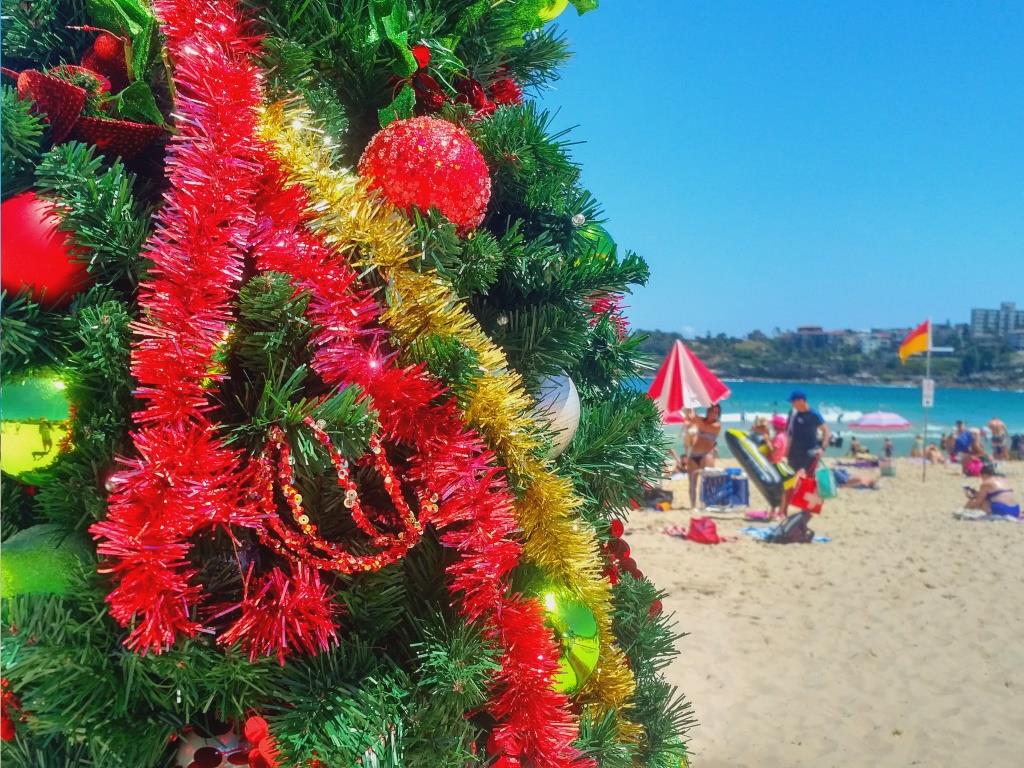
seasonal australia disorder: christmas in oz
Posted 11 January 2017
Sure, I've been abroad during Christmas several times, but this one was undeniably different. This was our first Christmas in Australia as permanent residents.
We deliberately booked our two week adventure around New Zealand so that we would be in Sydney on Christmas Day. Why? Because to be on Bondi Beach in the sun, wearing an obligatory Santa hat on Christmas Day, is a bit of a bucket list item with many a tourist, traveller and backpacker. No matter how cliché, we had to do this just once for the sheer novelty value! Spending Christmas Day on a beach in 32' heat was, frankly, for someone heralding from the northern hemisphere, utterly bizarre. Two things which do not belong together: a Christmas tree and a bakingly hot beach scene crammed full of parasols, factor 50 and thousands of people - some of whom had decided to bring their own Christmas trees along with their 'eskis'. Hitting the cold but powerful waves of the Pacific, losing my sunglasses and Santa hat in the process, was pretty awesome and, if I'm honest, brought out the kid in me. The fact that Channel 10 happened to be filming the Christmas edition of 'Bondi Rescue' was an added bonus...
A few days previous we attended the annual Pyrmont community carol singing service in Pyrmont's Union Square. I'm not big on Christmas but it was nice to be part of a community - especially being so far from 'home' and still very much an alien in this land. It's nice to experience a less garish Christmas - one which is kept in proportion and doesn't alienate you by trying to consume your every waking moment from September onward. Christmas only gets going in early December and in the increasing heat of the summer months, remains understated. For these reasons I preferred it infinitely...but don't mind admitting that a traditional wintery cold snap with a bit of ice, snow and travel disruption wouldn't have been unwelcome!
Christmas acts as a bit of a flashpoint for an expat and has highlighted an aspect of living Down Under which I have found the most unsettling: acclimatising to Australia's seasons and the order of the weather (not the weather itself, you understand). It's obvious, I know, but you don't really appreciate just how much your body, and, indeed, your emotions, are in-tune with the rhythm of the weather and calendar year until you live somewhere else where it is different. The weather, and what order it comes in, is a part of a pattern and pulse to which you’ve become accustomed: it’s a comfort blanket and is ingrained. This ‘meteorochronological’ order is also infused with memories, habits and expectations – all of which have gone out of my Sydney window in one big discombobulating throw. I think I've come down with SAD (Seasonal Australia Disorder).
driving tasmania's great eastern drive
Posted 11 December 2016
Tasmania sounds like it should be a country in its own right. It's a heart-shaped island, a little smaller than England, south east of the Australian mainland. Access to "Tassie", to give it its Aussie abbreviation, comes by plane from Sydney or Melbourne or you can set sale from Melbourne on a boat. Our flight from Sydney took just under two hours and crossed the Tasman Sea. Hobart airport is, therefore, a domestic airport only. No international flights land here - its destination boards featuring Australian cities only. This serves to give Tasmania a feeling of isolation and solitude. Having flown in from a people-packed, humid and noisy Sydney, believe me, this was all a refreshing change. Stepping off the plane into fresh air and the coolest temperatures I had felt for a long time (16 degrees) was instantly revitalising. The intention was always to head to Tassie when Sydney started to get hot and sticky - and we'd timed it perfectly. On the weekend of our departure New South Wales hit 38 degrees with all of the dramatic thunder and lightning that is guaranteed to follow (and which disrupted our return flight home). Tasmania was, quite literally, a breath of fresh air. Click the image above to travel to the full Destination Chronicle.
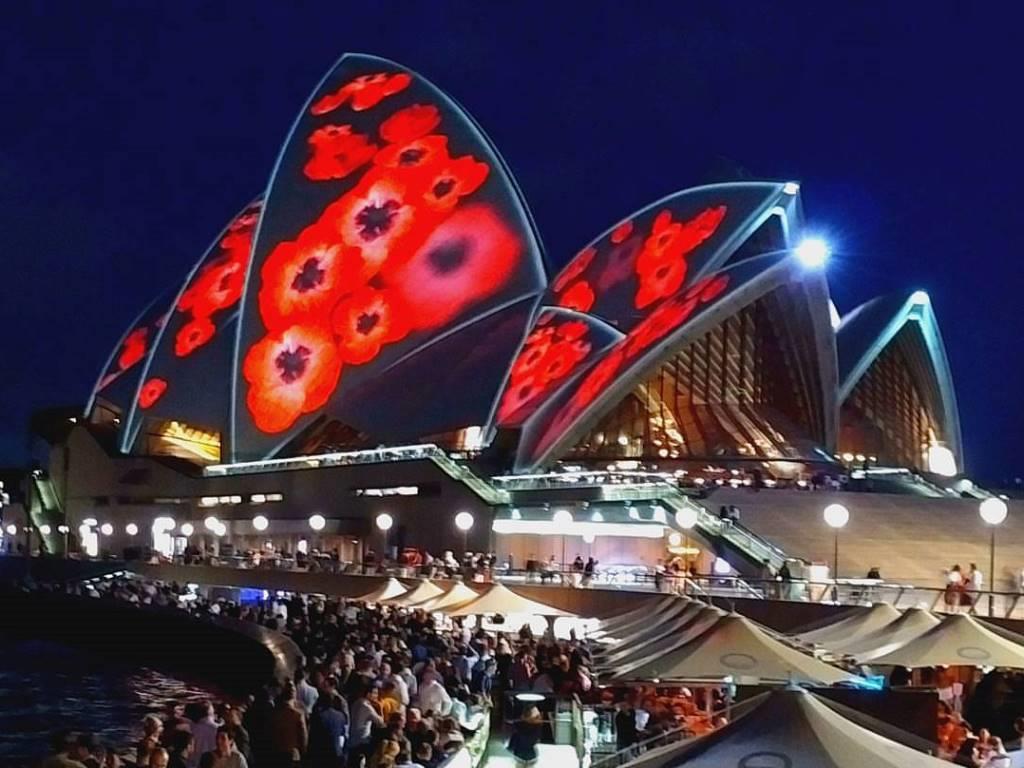
the sydney opera house lights up
Posted 12 November 2016
I was there because I knew it was happening. We were among a minority of people lying in wait. Unsurprisingly most were there just enjoying the end of another week: wine buckets, friends and food - the kind of things which characterise the majority of Friday evenings at Circular Quays. There was no hint of what was to be projected except for small illuminated crosses which, for the purposes of alignment no doubt, occasionally appeared on the landmark's tiled surface and vanished just as quickly.
Illuminated outlines of the Opera House's wonderful, and once-controversial, shell-like shapes appeared first, framing the giant poppies which then bloomed quietly and with no fanfare, slowly fading out and then majestically re-unfurling. Many were evidently not expecting it judging from the "oohs" and the "ahhs" I heard around me as the poppies bloomed to commemorate Armistice Day.The tribute was perfectly fitting: understated, beautiful, dignified.
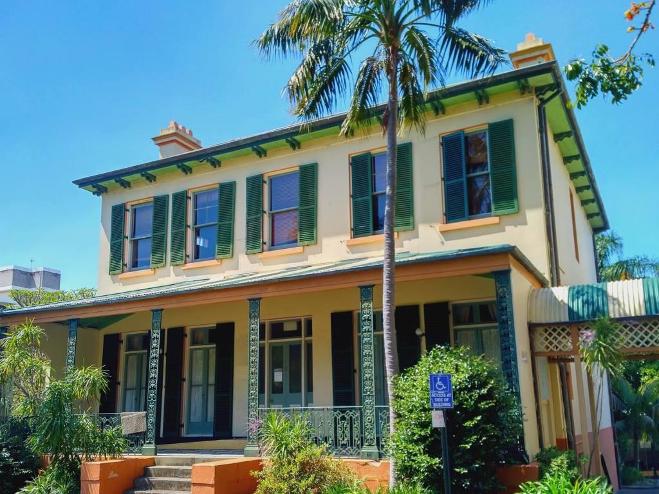
australian bureaucracy: a rant
Posted 03 November 2016
This is Australia. They do things differently here. We have to formally register our pet with the City of Sydney Council. Quite why we have to do this when our cat has a microchip, her details registered with the local vet and she is therefore fully traceable is anyone's guess. She has also been tracked every step of the way, via her microchip, from London to Sydney by the Australian Department of Agriculture and Water Resources. We have to pay for this pointless but painful layer of bureaucracy, too, with an annual subscription to the council.
To this end, I had to walk out to the local Bidura Children's Court, a strange and ever-so-slightly sinister looking building with tin roof, wooden verandah and flanked by palms (pictured), to sign a Statuary Declaration form to be witnessed by a Justice of the Peace! This didn't look like any court building I had ever seen - a Wild West-style thing set back from the main road with wooden shutters - an architectural relic of the time when this land was a British penal colony.
I waited outside with a gaggle of shiny black-suited people who, in the sun, looked more like giant glistening beetles. They all seemed to be clasping packs of documents - probably relating to some tragic child-related court case or other. Two o'clock arrived and, exactly to time, NSW state staff resumed their work post-lunch: not a minute before and thankfully not a minute after. The sun was blazing and I sought escape. The weather report said 26' - but I keep forgetting this means in the shade. It was at least 30' in the glare of the Sydney sun. I hurried indoors and had my bags put through an airport-style scanner.
I was waved across in the direction of the JP where a rather snooty woman of middle age served me at the counter. She's the kind of condescending pen pusher you can expect to find in any government department. There must be a special training school for these people. "Have you got the form?" she demanded, after I told her what my business was being there. "I was informed I would be provided with one", I said pathetically but with a grain of frustration - and hint of menace (I don't tend to handle these situations well). She huffed. "We charge for these forms". Charge?! Are you joking? Begrudgingly she laboured over to her beige PC circa 2004 and printed one off for me gratuit (the NSW Government's generosity knows no limits). The computer groaned almost as much as she did. Everything moved so slowly; I felt like I'd been drugged with the administrative equivalent of Rohypnol. I peered in through the glass hatch desperate for some visual stimulation whilst I waited...
The words 'BIDURA CHILDREN'S COURT' were emblazoned on a cheap strip of perspex above the counter. A man with a limp pootled around the office at a glacial speed, went to a bookcase, collected a pack of paper two reams thick and, looking at it with an expression that seemed to say 'manana', shuffled brokenly back to his grey, standard-issue swivel chair. He wore grey trousers and, in this heat, a grey jumper too. He blended into this grey-beige office in a kind of bland camouflage. The clock on the wall, I noticed, displayed "27th October". It's the 3rd November. No one had noticed or, if they had, didn't care. What's a week to a lifeless office which moves so listlessly? If there had been a section for the year I have no doubt it would have displayed 1967 - or thereabouts. What's a decade or two in an office like this?
With pointless bureaucracy completed and the all-important stamp plunged emphatically onto this most pointless of pages, I headed out of the building, Stat Dec in hand and ready to send this to the Pet Registrar at the council. God only knows what the next step will be in this scorched land - a land with beautiful beaches and the bluest of oceans surrounding it - but also one with a disturbing love of drowning itself in bureaucracy. I think I will always struggle to reconcile this place, which is so full of vivid colour, with its soul-sapping penchant for paperwork.
But my cat's worth it. Rant over.

whale watching in the pacific
Posted 16 October 2016
We left Sydney's Darling Harbour and headed into where the harbour's waters become the Pacific Ocean to do something I've just never got round to doing but have always wanted: whale watching. This wasn't just any whale watching, either. The 20,000 Humpback Whales which pass by Sydney each year on their summer migration route south is one of the longest whale migrations in the world. Theoretically, at this time of year, mothers escort their young calves south to their feeding ground on Australia's east coast. Amazingly, this is exactly what happened...
The first hour of watching was characterised by glimpses here, half of a tail there, a bit of blowhole spray here - and all too quick to capture on camera. Exciting but frustrating. These Humpbacks were shy beasts. Or so I thought. The captain turned off the engine and we waited. Foolishly a rival operator's boat ran out of patience and zoomed off leaving this part of the Pacific all to us. And that's when it started - a three minute performance I have dubbed 'tail ballet' where mummy seemed to be showing her little calf how to flick its tail in and out of the water (pictured). Their tails were almost rhythmic and, at points, wonderfully synchronised choreography-wise, but indelicately making a belly-flop sound on their re-entry into the sea. Us paparazzi-like whale watchers billed and cooed contentedly. Tail ballet was soon over. We thought that was that. We’d had our money’s worth and cameras, which beforehand had been on frantic sentry duty clicking ten shots to the dozen, began to stand down.
Stupidly. Without warning, and about fifty metres from our boat, the larger of the two mammals breached the surface. It leapt into the air, lifting all of its huge bulk out of the water. Within point five of a second she was back in her watery world. No-one captured it on camera, of course, but we had all seen it. Photographs didn't matter. It was a remarkable sight. My British reserve left me and I joined in with the rest of the crazy tourist mob shouting, cheering and swearing. As our captain said, this was “the money shot”.
What followed were a succession of mini breaches by the calf as it swam in the opposite direction North, with mum swimming after it to bring it back on course. In my mind I couldn't help but add a human dialogue to this wayward child episode. But, alas, we were already on borrowed time: the captain had gone well over so that we could see this heartwarming display of mammal matriarchy. Some board this boat filled to the brim with expectation but, crushingly, see nothing. I was more than satisfied with what I’d witnessed and stepped back on terra firma at Circular Quays grateful to Mum and her Littl'un for their hospitality.
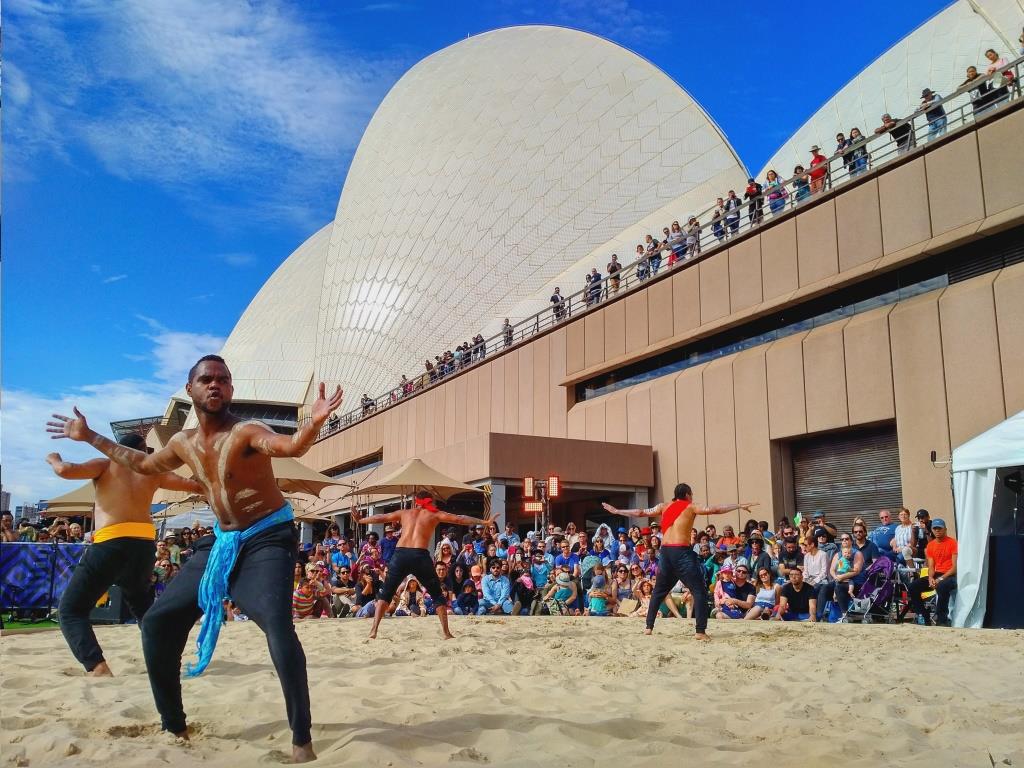
home ground festival: hearing first nations' voices
Posted 10 October 2016
I found out about the Home Ground Festival purely by chance. A post by ‘702 ABC Sydney’ on social media showed photographs of dancers and performers from the previous day. Home Ground was only a two day festival based in and around the Sydney Opera House and billed itself as celebrating ‘First Nations’ worldwide, not just Australia. This was its last day and it was midday already! We immediately scrubbed our plans to travel out to the famed Manly Beach (who wants to see yet another perfect Australian beach anyway?) and got the Sydney ferry from Pyrmont Bay to the port hub at Circular Quays.
I’m fascinated by Indigenous Australia and the story it has to tell. I don’t yet understand it and this makes me all the more hungry to understand. I do, however, understand enough to know that the story I am hearing in Australia about the ravages colonial Britain has wrought, is depressingly familiar.
I was sceptical about the festival. There is always a danger that such events can feel ‘theme park’ and synthetic – like cultural candy floss. I go out of my way to avoid anything like this. In a world where almost everything feels contrived and packaged safely ‘for all the family to enjoy’ I search, in my travels, for authentic experiences and places. Just how authentic was a small festival on a sunny weekend outside a world famous Opera House in the de-facto capital of Australia really going to be? I also have concerns that such events are a demonstration of the ‘old colonial hand’ of Australia placating Indigenous people by permitting them their performance - after all, Australia is still yet to sign any formal, legally-binding treaty with Aboriginal Australians – setting it apart from countries like Canada and New Zealand who have already done so. Australia has never entered into negotiations with Indigenous people about the taking of their lands or their place in the new nation. Still, with virtually no experience of Indigenous culture, I brushed my nagging doubts aside and went with the touristy flow. I was interested but my expectations were low.
I made sure we got a good position sat, as we were, close to the circular, sand-filled arena a full half-an-hour before the dancing was due to start. Without any performers on it, the arena filled with naughty kids kicking sand and building castles. I was really beginning to regret coming, “we should have gone to Manly”, I thought. The one saving grace of this annoying spectacle was that this giant sandy circle had succeeded in bringing children, whose differing heritages were written in their faces, together in one big, fun play pen. How apposite considering what was to follow. A man in a characteristically Australian ‘Kangaroo’ leather hat (thankfully without the dangling corks) did his best to dislodge the children embedded, as they were, in all manner of sand mounds and sand holes. He brought reinforcements in the form of two extra staff members who brandished ‘sand flattening’ devices and a water hose! The performances, by NAISDA and a dance group called Excelsior, were now imminent…
Children vanished from the arena. The sand was flattened and sufficiently wet. The music started. I sat there not really knowing what to expect… The dancing lasted less than forty minutes but was as powerful as it was authentic. The music stopped and, from the main tent, a solitary man emerged with microphone in hand. He was the dancer who, I had previously observed, had felt every movement and every gesture. The passion was etched into his face. He was not just dancing to become something. He was that something. This was authenticity. He delivered an eloquent and moving speech over a melancholy soundtrack. When he mentioned his love of the land and its animals the hairs on my neck stood on end. “And I’m proud to be an Aborigine” was met with spontaneous applause from an enraptured audience. The theme park atmosphere immediately dissolved. We were all now in the realm of real-life, of real hardship, of real meaningful struggle – and the audience could taste the injustice. Using assonance he twinned “Aborigine” with what was the final, and most politically-charged word, of the whole piece: “Treaty”. He left the sandy stage to applause and with his head facing stridently forward, but then bowed...
The world famous Sydney Opera House and Harbour Bridge, perhaps symbols themselves of unwanted colonialist development on these lands, looked on. They seemed to lose a little of their magnetism. The real magnetism, of course, was on stage. The sun was beating down. My camera had overheated. I ambled away from the arena humbled and contemplative, looking up at the white man’s so-called world of progress and enlightenment glittering their gold in the unforgiving Sydney sunshine: anonymous, corporate glass skyscrapers devoid of character, compassion, culture and place. Money, money, money. Take, take, take. Steal, steal, steal. Money. Take. Steal. By force. All that glitters certainly is not gold.
I tasted a bit of real Australia today. I can only hope that the people who were here first do not associate me with the people who were here last.
a road trip along coastal new south wales
Posted 06 October 2016
Proportionally speaking our route from Minnamurra in the south to Port Macquarie in the state's Mid-North, despite being over 1000km, covered a modest slice of the state. However, the sheer abundance of beauty and the diversity of sights created the sensation that we had, in fact, experienced several countries over the course of the long weekend. There were the Amazonian -like rainforests with their unusual, and slightly intimidating, flora and fauna which punctuated our walks out in the bush; the spectacularly beautiful paradisal beaches which would give any tropical island in the Caribbean a serious run for its money; the lush green pastures of rolling fields full of sheep which, perhaps fittingly, conjured up the words 'South Wales' in my mind and, perhaps most incongruously of all, the giant sand dunes which, with a little blurring of the eyes, could have been in the Western Sahara. Indeed, the dunes at Worimi Conservation Lands come with an impressive superlative: they are the biggest shifting sand dunes in the Southern Hemisphere. Welcome to a particularly stunning chunk of coastal New South Wales... To read the full Chronicle click the image above this post.
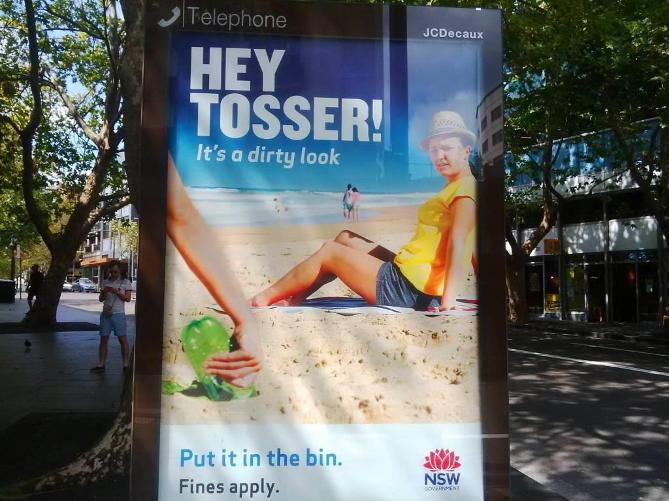
five lessons of the aussie language
Posted 26 September 2016
It’s English, but not as I’ve known it. Moving to any country is about as immersive as travel can get. Some opt for countries with a different language (crazier people to countries with a different script) to maximise the experience. I, however, opted for one whose official language was the same as my own. It wasn’t laziness or cowardice on my part – I just have other priorities and learning a new language on top of everything else just wasn’t one of them. Or so I thought.
I’m not naïve. In my time I have watched my fair share of Aussie soaps and with my teenage self being an avid fan of Prisoner: Cell Block H, I started my life Down Under this year with a respectable number of pre-filled entries in my English-Australian dictionary. Bea Smith was always “bashing” someone, Lizzie was often found feeling “crook” because of her weak “ticker” and Doreen was regularly to be found in the “Rec room” playing a “ripper” game of cards. You see, I grew up on this stuff and so the Australian accent I now hear around me, and to some degree its slang terms, feel familiar and friendly. A linguistic homecoming, if you will. As a twice graduate of the English language and an English teacher by profession, listening to the Aussie tongue in its native habitat is all rather fascinating. A journey in itself.
Of uppermost importance is to understand how language is used in Australia. It is not how the British use it. Brits use language metaphorically; we are masters of encoding what we say desperate, as we are, not to offend anyone – ever. We invented the euphemism so as not to say anything which others may find uncouth or uncomfortable. We spend hours planning difficult conversations in advance – and then pour over them afterwards. We sieve and strain our intended message through a series of filters removing any offending content and, by the end, we are left with a bunch of words with no impact and no meaning. Our response to a friend’s invitation to join them at a restaurant is not “no, I don’t want to” but “Yes, I might see you there” or “I might pop along”. Our response to a friend’s ridiculous suggestion is not “no, that’s ridiculous” but “that’s interesting.” It is the language of avoidance. Sure it’s skilful but it is also painful. It takes time – and it’s so tiring to be a part of. No wonder everyone in England looks so exhausted and fed-up. Thankfully Australians do not have the same approach to Language.
Enter, stage bottom right, Australian candour and the most important first rule about the Aussie tongue. For Aussies, language isn’t about protecting others from offence, painstakingly letting people down gently, carefully – oh so carefully. Language here is principally functional: it’s about the conveyance of meaning – the whole point of language in the first place. It’s more literal and less metaphorical. It’s about revealing and not concealing. Why is this important? It’s important because knowing this may just help you to avoid thinking that people here are unkind, forceful or even discriminatory. Once this realisation has been made, you can move on to enjoying some of the other idiosyncrasies this unique take on the English language has to offer…
Rule Two: Leave Your British Sensibility Behind
It is perfectly normal to hear the words “bloody”, “bitch”, "pissed" and “crap” on television and radio at all times of the day – often spoken by reputable presenters of equally reputable programmes. There isn’t a hang-up about these words. Indeed, an Australian marketing campaign aimed at attracting more British tourists to the country was banned by the UK’s Advertising Standards Authority because it featured the word “bloody.” Similarly, an anti-litter campaign at home, run by the New South Wales state government, saw posters with the words “Hey Tosser!” displayed around Sydney. If you happened to be at Sydney Central railway station at around this time the posters were also accompanied by loud adverts played on a loop on screens with the word “Tosser!” voiced with gusto. Could you ever imagine this happening in an English city? Oh the complaints there would be. Mary Whitehouse. Grave. Spin. But this example underscores a key point about language in this country: it is used here to have a direct impact; an immediacy; a functionality. I often imagine what the English equivalent poster would have had as its heading. Perhaps something along the lines of “Would you mind, could you, erm, possibly, make sure, if you can, put your detritus in the bin – pretty please. When you have time”? Case in point. Language in Britain has become so careful, so agonised that its intended meaning has become diminished. Our social mores mean that anyone speaking too honestly or too directly is generally considered rude or ill-educated. Aussies find my very British linguistic perambulations frustrating. Say what you mean is the mantra here. There is virtue to be found in this approach to language, but sometimes it’s a little unpalatable… A discussion on the morning talk show ‘Studio 10’ on the offensiveness of the word “wog” had me truly shocked and choking on my museli. The word, which was voiced several times without reservation, was also writ large on the graphics bar at the foot of the screen in quotation marks with the strapline “Is it offensive to call people “wogs?”” I wonder what the English equivalent would have been in this case? Perhaps the “W word”?
Rule Three: Know About the Strange Suffixes
Often using ‘ie’ or ‘o’ as a suffix resulting in a contraction of the original, these words sound musical and friendly. Australians are famed for shortening their words in this manner and to go some way to illustrating this, here are a few examples I have heard along the way:
“Bottl-o” = off licence
“Renos” = renovations
“Preso” = presentation
“Pollies” = politicians
“Pozzie” = position
“Journo” = journalist
"Tradie" = workman or labourer
“Garbo” = bin man.
Rule Four: Learn the Weird and Wonderful – and Enjoy Them!
A favourite among friends and family on my Facebook page is my weekly series ‘Aussie English wot I learnt this week’. Here’s a compilation from the last two months . Aussie lingo is a veritable goldmine. Some are understandable, others utterly bizarre – and they’re the kind of words you’d only come across by living in a country, rather than visiting. Some of these have been found out the hard way…
“Back flip” = doing a U-turn
“Flip flop” = doing a U-turn or changing one's mind
"Gazetted" = officially sanctioned or appointed
“Leadership spill” = political leadership contest
"Laneway" = alley
“Watch house” = in police custody
“Stoush” = battle or wrangle
“Muck-up day” = prank day for senior school leavers in NSW
“Free dress” = non uniform day
“Wowser” = kill joy / party pooper / fun police
“Jackaroo” = male farm hand / cowboy
“Get a root” = get laid
“Punch on” = fight
“Spruik” = pr ‘sprook': spiel or sales patter
“Larrikin” = loveable rogue or scoundrel
“Eftpos” = a ridiculous acronym meaning paying by card in a shop
“Ice” = crystal meth
“Jam it” = shove it up your posterior
“Housing Commission” = council house
“Ute muster” = a festival where owners and their utes (pick-up trucks) gather
“King punch” = a deadly single punch attack
“Hoon” = boy racer
“Rort” = a scam or underhanded trick
“Sledging” = sustained intimidation of a sporting opponent / psyching out
“Goober” = goofy
“Bludger” = scrounger / sponger
“Billy” = a tin cooking pot used for camping
“Locked bag” = PO Box
“Divider” = central reservation
“blindside” = to surprise or to shock someone unawares
“Rug up” = wrap up
“Desexed” = neutered
"Jaffles" = toastie
“Cattywampus” = wonky
“Sanger” = sandwich
“Post pay” = mobile phone on contract
“Powerboard” = multiple plug sockets on a lead
“Pay wave” = contactless card payment
“Unit” = apartment
“Daggy” = grubby
“Strewth” = God's truth
“Home invasion” = burglary
"Stoked" = Very happy
"Telecast" = Televised
"Silent line" = Ex-directory phone line
"Op shop" = Charity shop
"Sourced" = Getting drunk
"Peak" = Rush hour
"Scripts" = Prescription
"On the schedule" = Medicines available on the Medicare system
“Nature strip” = I love this term for a grass verge
“Goon bag” = box of wine (with the bag/tap)
“Globe” = lightbulb
“Super” = short for superannuation and means pension
“Casual” = supply teacher
“Esky” = a portable cool box you take to the park
“Doona” = quilt or blanket
“Yabbies” = cray fish
"Vision" = footage. Had me thinking that all Aussie newsreaders were future-gazers
"Bulk-billing" = a medical practice where you don't have to pay
"BSB" = No, not the British satellite company before Rupert Satan Murdoch got his hands on it but your bank Sort Code
"Synoptic" = weather summary
"Plebiscite" = a very strange word for a referendum
"Victorian/Territorian" = a person from the state of Victoria/Northern Territory
"Equals" = hot drink sweetener.
Rule Five: Know the Linguistic Legacy of Place Names
Australia has some very unusual place names. A quick check on a map of New South Wales and, indeed, any other state or territory in this vast country, shows names like “Wallangarra”, “Boorowa”, “Mungindi”, “Zig Zag”, “Wagga Wagga” and my all-time favourite “Woolloomoolloo”. These, of course, reference – very importantly – Australia’s Indigenous heritage, named by the people who were here first. These names are a wonderful counterweight to the generic, off-the-shelf ones brought over by the British: “Sydney” (named after a man called Sydney), “Darwin”, “Perth”, “Exmouth”, “Carnarvon”, “Newcastle” – and even “Tamworth” for crying out loud!
Mercifully, the giant red sandstone monolith in the Northern Territory once-named “Ayers Rock” has had its Indigenous name of “Uluru” restored but is still officially listed as “Uluru / Ayers Rock” – the slash, of course, extremely significant here representing, as it does, an unresolved issue around power and language. It has, however, been given back to the Anangu people.
The British have also left another linguistic legacy in their ruthless wake – a whole host of pathetic, Carry On-style names which, far from being funny, are just plain embarrassing. A map of “Actual Australian Place Names”, published today by the ABC, shows names like “Creamy Hills”, “Blowhard Point”, “Licking Hole” and “Andy’s Knob”. Rather than being humorous, I think this smutty assault on a country with thousands of years of Indigenous history, sums up the causal arrogance of a colonialising force.

that was the week that was
Posted 09 September 2016
Sunday. What has perhaps been the most worrisome part of the whole move came to its conclusion. Our wonderful cat had reached Sydney - having travelled from Manchester via Leigh-on-Sea in Essex, London Heathrow, Dubai and after ten days in the Melbourne quarantine centre. There was nothing left but to collect her from the Qantas Freight centre at Sydney Kingsmith International. We will never know if we did the right thing bringing her. Still, an important part of our family came 'home' – albeit bewildered and rattled. She's now reasonably content and is fast asleep next to me.
Tuesday. Two days later our shipment arrived after its 11,000 mile journey across the seas. Things we had done without for close to two months, and which had almost adopted a mythical, legendary air were now here. The taupe army had returned - weary and battered from their journey. A partially empty home, but one to which we had established a sense of order, was once again thrown into turmoil. We had mixed feelings about some of the stuff we had chosen to ship. It felt like the past had come back to haunt us - things we appreciated in the UK seemed incongruous and a little out of place in Sydney. This was meant to be a new life - but was beginning to look a lot like the old one. Three things I was really glad to get my hands on? The microwave, the alarm clock so I could see the time during the night and my house robe.
Friday. This was a day of mixed emotions as our three bedroom home in south Manchester, the sale of which had been proceeding at a glacial pace, completed. We were no longer property owners in the United Kingdom. The home we'd spent so much time and passion renovating transferred to people we hardly knew. Another connection to the UK was broken. We were quids in - but we were also out.
That was the week that was. Emigration complete? Well, nearly....

channel 10: getting myself on aussie tv
Posted 31 August 2016
Getting tickets for Channel 10's 'Studio 10' programme was nothing more than a few clicks on a facebook post. Two days later, on a Wednesday morning from 08:30-11:01, we found ourselves, true to the triumphant words announced at the show's start, being "beamed across Australia" from the channel's Sydney studios.
Sure the show is populist (what television output in Australia isn't), and putting its dreadful infomercials to one side, I happen to like it because it broadcasts live a mere stone's throw from our Aussie home and so it feels like our local station. The show's panel, made up five Aussies stuffed full of character, wit and japes, is instantly likeable. Their contrasting personalities and sometimes opposing politics makes the programme engaging and the must-watch morning show in our house. I've learnt a little about the Australian character from it, too.
We arrived around 8am - half an hour before the broadcast began - to make sure we got our hands on the much-promised "breakfast and coffee" which turned out to be a very Australian pancake (eat as many as you want) and, sadly, some Nescafe instant. Seeing as the programme is sponsored by the Australian coffee chain Gloria Jean's Coffees, whose miniature mock coffee shop, complete with barista, sits in a corner of the studio for maximum product placement punch, I was a little peeved to be dealt this inferior source of caffeine. However, every member of the audience is in line for a freebie. Each day a company is given a minute to display its product and, as part of the sponsorship deal, everyone in the audience gets one when the show's over. Luckily for me the product featured was a small canvas bag, worth $100 and, which, just so happened to be a perfect replacement for the increasingly tatty bag I take with me on my travels (so tatty, in fact, that on I took to mending it with needle and thread in a bus station in Bosnia and Herzegovina as I waited for my bus to Montenegro).
"Have you been here before?" the Audience Coordinator asked as we arrived, to which I said it was our first time. "Welcome to the family", she beamed. With our photo ID checked and our bodies waved with a security wand by an equally friendly security guard, we were into the studios along with, seemingly, twenty or so regular audience members one of whom was celebrating his 65th birthday and who received a happy birthday sing song from the presenters at the end of the show.
Unlike being in a TV audience in the UK where TV production can be ever so serious and a little pompous, I was able to take as many photos as I wanted to during the programme. Watching an Australian TV show being put together in front of me, with switches between vision, changes in set, live inserts from a reporter 'out in the bush', an unexpected breaking news item and a seamless changing of guests, was all rather fascinating. Seeing Sarah Harris, Joe Hildebrand, Denise 'Ding Dong' Drysdale and Jessica Rowe, who've regularly lit up my TV on a weekday morning, in the flesh, was pretty awesome.
We sat at the back by choice but still managed to appear on screen, albeit briefly, as the programme opened and a camera panned across a clapping audience responding like robots to the flashing "APPLAUSE" sign. For two seconds my face was indeed, and unfortunately for the Aussies, "beamed across Australia" from Studio 10. Ripper!

birthday on the bondi to bronte coastal walk
Posted 15 August 2016
Walking the 6km from the world famous Bondi Beach, through Tamara and onto Bronte Beach (and back) is an awesome way to spend your birthday - especially when the winter weather in New South Wales isn't wintry in the British sense of the word. Sure, 'winter' here can comprise tempestuous storms with sheets of water falling unrelentingly for days but, more often than not, is comprised of the very opposite: beautifully blue skies, temperatures at a balmy twenty and a light breeze.
This most famous and most walked track in Sydney comes with a kaleidoscope of unusual flora (reds, pinks, yellows - even silvers) and the opportunity to snap iconic sights such as surfers with their boards riding the waves and groups of friends playing Beach Volleyball. There is also some pretty good street art to be found around Bondi Beach itself which, through skilful deployment of the spray can, helps to capture the trendy, surfey essence of the place.
Such a picturesque coastal walk as this, meandering along the coastline, and which looks out into the azure and turquoise blues of the South Pacific Ocean, brought me face-to-face with some of the deepest, richest natural colours I think I have ever seen. It is quite possible to imagine that you are partaking, as an extra, in an episode of Home and Away where someone has turned the colour temperature and brightness knobs to their maximum position. Your artificial instagram filters are superfluous on this walk - Mother Nature takes care of it.
"everybody needs good neighbours..."
Posted 28 July 2016
I'm constantly wrong-footed by neighbours wishing me "G'day" - even when I go to bring in the bins. They don't seem to understand that the proper way to treat your neighbours is:
a) to regard them with ongoing and completely unfounded suspicion;
b) to believe that every neighbour hates you and therefore needs to be ignored at all costs except when the situation renders this completely unavoidable (i.e: when walking along the same pavement and an awkward 'meeting place' occurs);
c) to ensure that a scowl is your default facial expression, rather than a smile, in a bid to shut down any likelihood of a dangerous situation of verbal interaction occurring;
d) to plan any exiting of your property well in advance by surreptitiously looking out of the window to check that no one deserving of even superficial interaction is about to socially ambush you with a greeting. Skilful operators of this particular rule will, from long study, know their neighbours' daily routines and will make maximum use of this information in avoiding the distress of coming face-to-face with a friendly neighbour.
Aussies could learn a lot from the British. I'm convinced these greetings are a local plot hatched by my neighbours to make me feel totally uncomfortable in this new land and a way to bully us out of the street.
The photo which accompanies this post is the view from our front door - the little white letterbox is ours. Our house faces 'Paradise Reserve' - a small patch of land somewhere between park and grass verge set aside for nature (these are all over the city). It's home to eucalyptus trees, some amazing-sounding birds and a bag lady who goes rummaging in the bushes in the morning from time to time! The whole ensemble is a wonderful sight when I go out to collect the morning post from our letterbox - if I'm accosted by a friendly neighbour it's an added bonus.
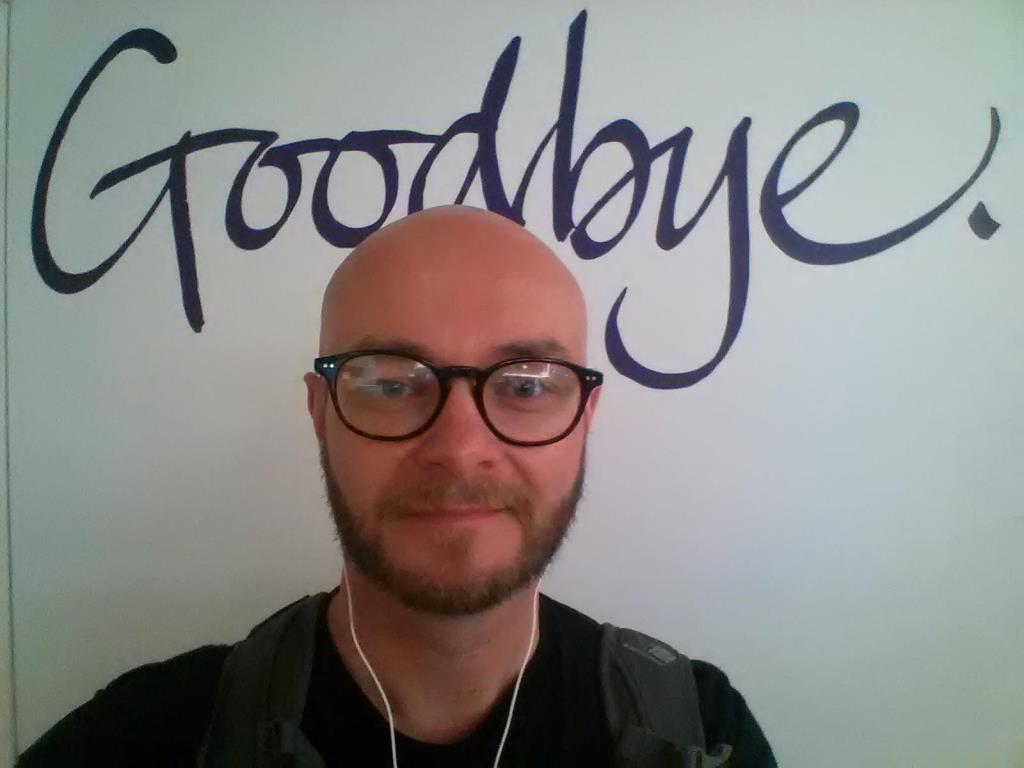
back to the future with a one-way ticket
Posted 25 July 2016
I have purchased many a one-way ticket in my time. But this was different; momentous, even (and not so because of its extortionate price tag). This was a one-way ticket from London to Sydney: my emigration had reached its second, and final, stage. I had spent the last three months back in the UK tying-up some very important loose ends but I was now leaving the country of my birth for the last time - with only a distant, foggy idea that I may return at some point in the future. Having been out here in March setting up the basics of a home I was, quite literally, heading back to the future. My flight, lasting close to twenty four hours, slowly but surely shifted Australia from the future and in to the present. I would no longer be able to think of life in Oz using the future tense. It was in the now and it positively demanded use of the present participle. This ticket signalled a shift in tense, but also status. Typing this in our little house with its Aussie-style tin roof and a 'dunny' in the yard, I am very obviously no longer a traveller here; no longer a visitor or a tourist. I'm now a permanent resident of Australia and 'Sydneysider'. Trust me, it's as intimidating and exciting as it sounds.

end of the northern line: all change please
Posted 24 June 2016
This post marks the end of what has been the most formative chapter in my life: seventeen years of living in England's North is now coming to a close. I have been an honorary northerner for most of my adult life - and now I'm set to swap its humble red brick buildings, familiar grey skies and cold snaps for the glass towers, oppressive heat and bright lights of a corporate Sydney. The image which accompanies this post is particularly fitting - even prescient and prophetic. The evocative Tyne Bridge in Newcastle being, as it is, so reminiscent of the iconic bridge at Sydney's Harbour.
The North has been good to me. This oft maligned part of England has motivated and inspired me in equal measure. I know more about Northern England than I do the part of the country where I was born and raised. I understand its mentality and adore its architecture. I take great joy in listening to its accents and have marvelled at its landscapes. I have studied in its universities, taught in its run-down schools and danced, perhaps badly, in its nightclubs and bars. It was in Leeds where I met the love of my life. It was in Leeds where we bought our first home. Our adorable cat, who is joining us on our Australian adventure, is also from Leeds and meows with a proud, Yorkshire accent. It was in Sunderland where I discovered I could be a great teacher. It was in Newcastle-upon-Tyne where I learned that I could get through to even the most disenfranchised and damaged of children. It was in Manchester where my career reached a new peak - and it was in Manchester where I got married.
And it is Manchester which now represents the end of my journey on the Northern Line - one which has taken me from the soot-stained sandstone cottages of Yorkshire, to the majestic and masculine bridges of Tyneside, and to the red brick Victorian glories of Granadaland. At the risk of mixing my metaphors here, the Northern Line runs through me like an artery. It is, however, time to disembark; time to alight here. I've reached the end of the Northern Line. Thanks for the journey. It's been real.
The Station Master of Life trumpets triumphantly through the tannoy, "Your next destination will be Sydney Central. Please take all of your belongings, wits and hope with you. All change please, all change."
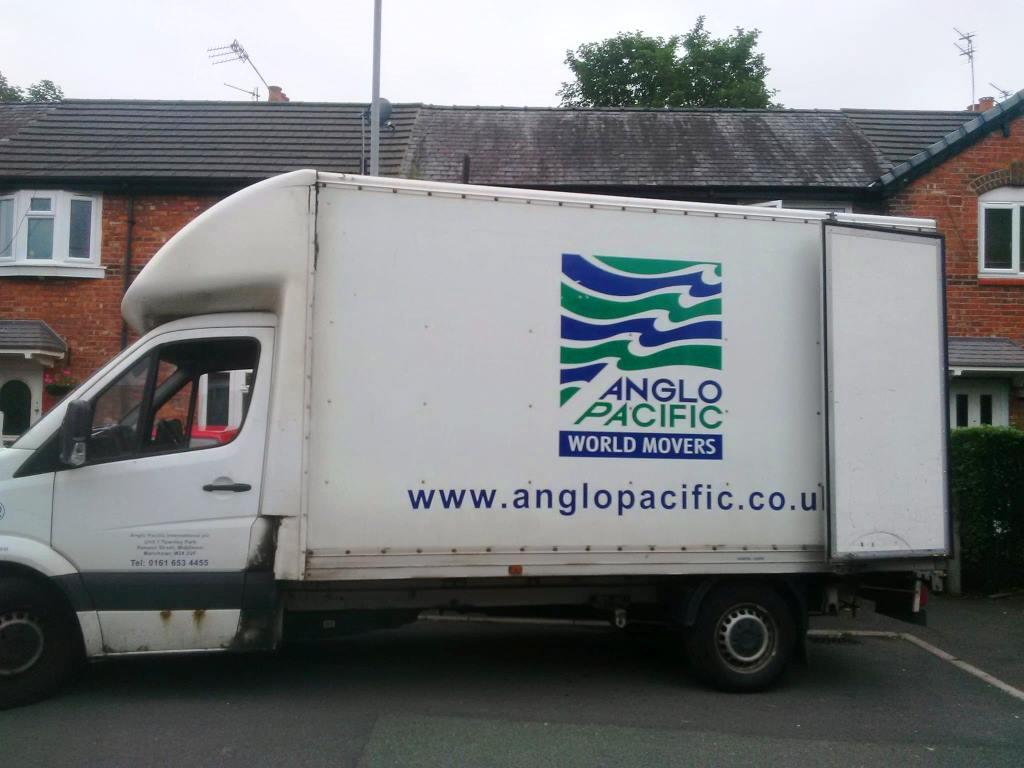
the day the movers came: a magical burglary
Posted 24 June 2016
One of the most stressful episodes in our emigration (aside from those relating to securing the visa) has now passed: the dismantlement of the home. Of course, the home has been slowly disassembled over many months now: unwanted, broken and duplicate things binned, more valuable but superfluous items sold on, other things too specialist or special to vend have been given away to friends and family. The slow erosion of the home is manageable – liberating, even. You gain extra space you never knew you had. You make money from things you don't care for.
Today, however, was different. This was a full disembowling of domesticity. Three whirling dervishes with Mancunian accents descended on my home: their brown packing materials and long tape reels swirling and flying in the air like an ill-thought out beige fete. Within a mere three hours our colourful and characterful possessions were encased and suffocated in default, standard-issue packing materials. The lounge quickly became populated by strangely-shaped taupe objects: a new emigrant people preparing to set sail on their maiden voyage. For me, the whole spectacle hovered uneasily between burglary and impressive magic trick. The appearance of a white van outside meant that this act of magic could draw to its inevitable conclusion. Everything vanished in a puff of petrol fumes.
The house now echoes to my voice and to my footsteps. It’s a strange and unsettling feeling – but an emancipatory one, too. The cat looks around the empty shell befuddled and anxious. It is, perhaps, fitting that, emblazoned repetitiously across this cardboard army, were the words FRAGILE FRAGILE FRAGILE...
I went to make a cup of coffee only to find my coffee cups had vanished along with everything else: Ta-Dah! and Ta-Rah!
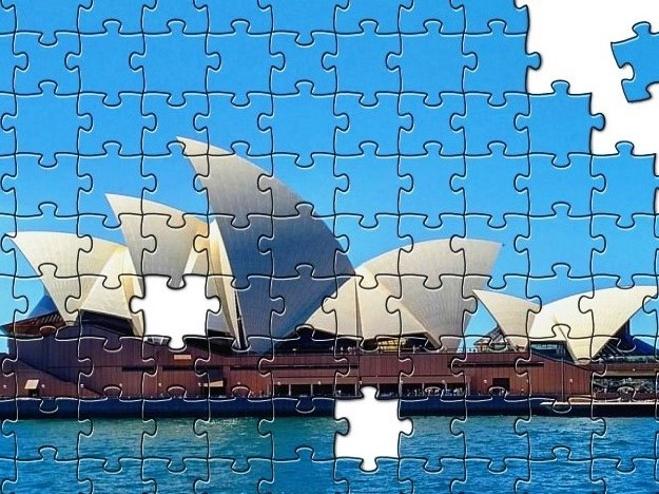
completing the aussie administrative jigsaw
Posted 28 April 2016
Today's post has been prompted by the overnight arrival of the last piece of what has been a rather unforgiving Australian administrative jigsaw. It's the final stage of a process which has taken well over a year to complete. As I fix this final bit into place, I am unsure as to the picture this Aussie jigsaw has created. I can say one thing for certain: it's a picture of uncertainty.
One thing you learn early on in the process of migrating to Australia is that the Australian government, and its states, are rigorously officious and love paperwork. They eat, sleep and breathe registration numbers, documents and evidence: you will not enter Australia unless they want you to and on their terms. The authorities, whose multifarious departments and wings thereof I have grappled with, know everything about me: my heritage, my qualifications, my pension and the state of my health.
Obtaining each piece of the jigsaw has cost, too. I have had to pay at each stage of the assessment. Nothing has been helpful, nothing has been gratuit. This is no free ride. For posterity's sake I have added the approximate costs of each stage of the process alongside. Of course, this migration is not about money - but so often has been. As part record, and part therapeutic recount, this is how I completed my Aussie jigsaw...
Stage 1: Gather all documents required for my teacher assessment with the Department of Immigration & Border Protection's gazetted quango AITSL. AITSL will assess my eligibility to be a high school teacher in Australia and is, for migrating teachers, the gatekeeper to Australia. Without its say so, I will not be permitted to apply for a visa. This process involved certifying documents, obtaining fresh transcripts from all three of my former universities as the originals were deemed lacking and countless emails backwards and forth seeking clarification. In one case, the University of Newcastle's Education Department had to produce three separate transcripts of my teaching qualification. I am glad to say that, in the end, it was third time lucky. AITSL charge: £350. Certification of documents costs: £250. University transcripts: £60. Time taken: 22 weeks.
Stage 2: I now have my AITSL certificate. It arrived in the post from Australia. This means I can progress to the next stage. Here I set up my IMMI account with the Department of Immigration & Border Protection. However, I do not make the threshold of a minimum of 60 points. Without this I will fail the points test and not progress to the next stage. Therefore...
Stage 3: I book my IELTS (International English Language Testing System) at Manchester University, revise and prepare, sit the exams alongside a whole host of international students on the day and, a fortnight afterwards, I receive my results: Superior English (the small matter of having two degrees in English and being a native English speaker cuts no ice with the Australian visa system - I must prove it. Even my first class degree in English is not proof, apparently). Superior does not only mean that I now meet the minimum threshold required - but go way above it, with a new total of 75 points and thus I leapfrog over others who have more average visa points scores of 60, 65 and 70. I will be among the first to be invited by the DIBP to apply for a visa having submitted my Expression of Interest (EoI). IELTS Cost: £150. Time: 10 weeks.
Stage 4: I return to my IMMI account and input my IELTS scores and submit my EoI application just in time for the next invitation round of ehich there are two per month. Some people with lower point scores languish on the EoI list for months, whilst those with higher scores go to the 'top of the pile'. It's cruel but part of the Aussie mentality - they only let the best in. I received an invitation to formally apply for my visa four days later.
Stage 5: This is a big one. It involves an upload of nearly fifty documents covering identity, skilled employment, language capability, a police background check, a health check and the nature of my relationship with my partner. Cost: £2150. Time: 30 weeks.
Stage 6: In order to teach in New South Wales I need to be registered with the Board of Studies and Educational Standards (BOSTES). I can't complete the online application form until I have a Working With Children Check (WWCC) number to input. To obtain one I need to have proof of address and need to pay the fee in person in a New South Wales state registry office. Bugger! I have to satisfy myself with a part setting up of my account with the Office of the Children's Guardian (OCG) and wait until I'm New South Wales next. The process is now on officially on hold but, in the meantime, I make sure I have sufficient copies of my qualifications and identity documents certified and ready for rapid deployment in this neverending bureaucratic battle. Cost: nothing but valuable time. Time: 3 months until I am in Australia in person.
Stage 7: I am now in Australia. Without doubt the most efficicent part of this whole affair was attending the NSW state office - a one-stop-shop of of state bureaucracy. First I had to register with them. At the same time I submitted an online application for my WWCC and used my newly-created account with the state of New South Wales to pay the $80 fee for my check. To my relief I had just the right documentation for them to register me and, in a rare example of flexixbility, allowed me to use my very temporary AirBNB accomodation booking (visible on a printed receipt) as proof of my address otherwise I would have had to wait until securing a proper shorthold tenancy... My WWCC comes through a fortnight later as an email just as I land back in the UK. Cost: £70. Time: 2 weeks.
Stage 8: Now that I have my all-important WWCC number, I can now complete my online BOSTES registration. I submit the form and deploy from their base in Sydney, via Australia Post, my certified qualifications certificates which had, military-wise, lain in strict, regimented order for their instruction to charge forth. I was getting good at this. My BOSTES registration comes through a week later as an email. Cost £50. Time: 2 weeks.
Stage 9: Now that I have my WWCC and my BOSTES numbers I can complete the Department for Education & Community's (DEC) online form to be eligible to work in state schools. This costs me nothing but I do have to complete a short module on child protection before submitting it. I am now in a queue on a first-come first-served basis for casual work in the Sydney area of NSW. Cost: £0. Time: Still waiting.
...and that is the story of how I assembled my Aussie jigsaw: sometimes a battle which I was close to cowardly waving the white flag at but one which brought out the stubborn fighter in me. It was a battle I won but only because of a tenacity I never knew I had, and a relish for beating the system - which I always knew I did have.
Total cost: £3100. Total Time: 16 months. Sleepless nights: Inestimable.
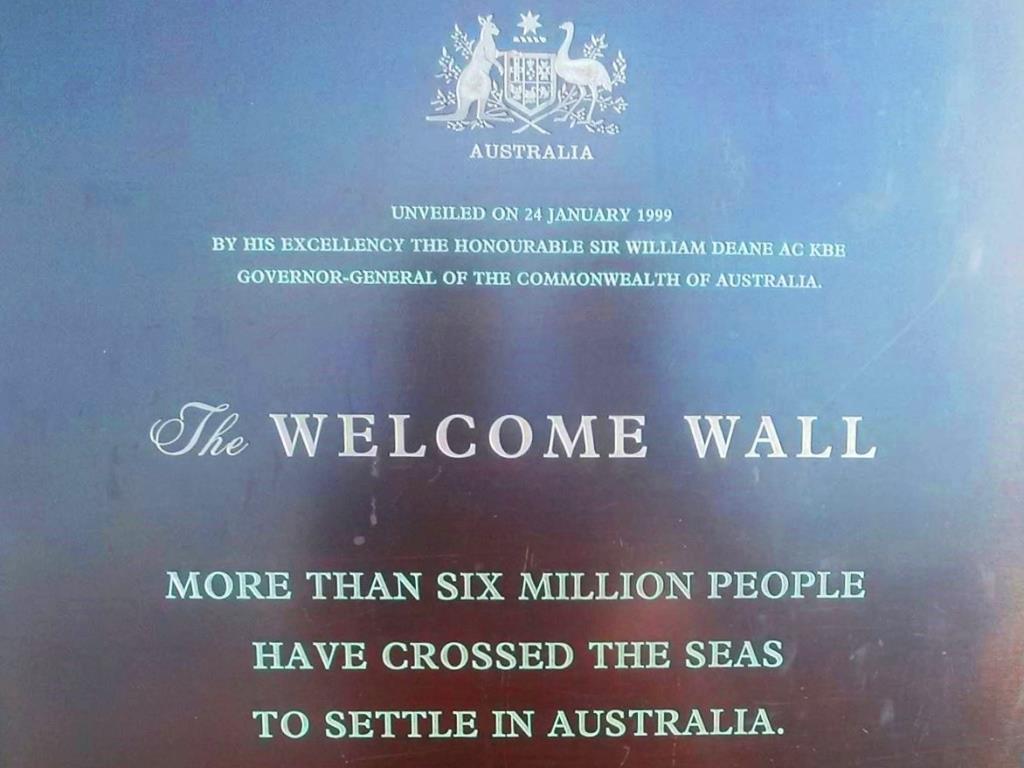
moving words at the welcome wall
Posted 10 April 2016
The word 'immigrant' is so frequently bound up with negative connotations and this blog is not the right place to debate this moot issue, suffice to say that having been firmly on one side of the fence all my life (the native, the indigenous, the homegrown) I am now on the other side (the alien, the foreigner, the outsider). I am now an immigrant - doing what so many others have done for hundreds of years: seeking out a better life for myself as I realise, in these days of 'yolo' and bucket lists, I only have one and so had better make the most of it. It is a migration I have had to fight for, a migration I have had to spend thousands securing and a migration I have had to dedicate hundreds of hours, jumping through ever more complicated and demanding administrative hoops, to achieve.
Featuring extracts of immigrants' experiences from a range of sources, The Welcome Wall, installed in 1999 at Sydney's Darling Harbour, commemorates and celebrates the six million plus people who have "crossed the seas to settle in Australia." I am now one of them. A bronze installation which I walked past and glanced at only nonchalantly at first quickly drew me in as personal tales of hardship resonated at this, the end of my third week as one of Australia's newest immigrants. One inscription from a Lebanese man struck a cord: "Everyone in Lebanon saw Australia as a dream country. When you get there it's not so. You have to start again. Ninety percent of the people from Lebanon come from the country. It's hard enough moving in your own country from the bush to the city let alone doing it on the other side of the world."
I suppose I found this entry consoling - personal testimony to how hard being an immigrant can be. Some 10,000 miles away from Dover's White Cliffs, I reflected on what we'd taken on; reflected on what we'd done; reflected on what we'd managed to achieve so far and reflected on the as yet unknown difficulties which inevitably lay ahead.
Thanks to my good friend Marjorie Morgan for the perfect 'Moving Words' title of this post.

cheapskate immigrants: vinnies & 2ndsworld
Posted 07 April 2016
The fact of the matter is that 85% of emigrating is dealing with the practical and the everyday. It's less about wandering off into a field of dreams and more about which telecom company you're going to choose or which is the cheapest supermarket in your area. We had a rental agreement for a home, we had the keys and we had a bed, but that was about it. The panic at not even having a plate to eat off can easily lead to you throwing money at the problem by walking into the nearest expensive department store and spending hundreds on everyday essentials simply because you lack the local know-how.
Thankfully the Glebe branch of the Australian institution that is Vinnies came to the rescue. It was a veritable scrum of a charity shop with all of the basics we needed... An hour later I emerged from the store with a document shredder, two glasses, two mugs, two large plates, four small plates, three bowls, a glass water jug, a chrome jug for the coffee machine and two Ikea storage boxes all for $35 (£18). With so much of our emigration being super expensive, it was satisfying to feel like I was beating the system for a change. Thanks Vinnies!
In the UK renters are used to having white goods included with the property - even if it is labelled as an 'unfurnished' rental. This means that renting Australians cart their washing machines, fridges and freezers from house to house. It also means that if you're new to renting you have to buy your own. A tip from the estate agent led us to another of Sydney's secrets: 2ndsworld. Through its clunky and outdated website 2ndsworld specialises in end-of-lines, carton damaged stock and appliances with minor blemishes, shaving hundreds of dollars off of what I consider to be 'perfectly good goods'. In a single order delivered to our door we bought a small fridge freezer, a TV, a quintessentially Australian top-loading washing machine, a DAB radio, a telephone with answering machine and an iron. Thanks 2ndsworld!
Between them, Vinnies and 2ndsworld kitted our house out, turning it from an empty white box and into a liveable home with all of the basics in place. An obligatory trip to Ikea was up next - but I'll spare you the details suffice only to say that the Australian version of Ikea had some very interesting tweaks to its usual layout which reflected the cultural differences in this part of the world.

surviving my first aussie spider experience
Posted 06 April 2016
The fear of Australia's nasty insects is the hook upon which many an Englishman hangs his fear of emigrating to Australia. It's often cited, perhaps melodramatically, as the reason 'I could never live in Australia'. Australia's reputation as the home to some dangerous spider species certainly precedes it. To the British, whose experience of spiders reaches its peak at a pathetically-sized, half-limp-from-the-cold and harmless spider coming in for a quick warm by the radiator, Australia's in comparison are the stuff of many a Brit's nightmares. In the English mind Australia is synonymous with spiders first and cute kangaroos second. This has not gone unnoticed by Aussies. The British are renowned for having particularly acute arachnophobia.
Within two weeks of emigrating to Sydney I had my first spider experience. I had just collected the keys to our new home in Pyrmont and had hired Karl and his ute to help me get a bed and mattress from Potts Point over to the new house. As he was getting the mattress from the back of his ute I took to opening the metal insect screen and then the main door to the property. Something dropped onto my hand from above, hitting me and then fell further to the ground. Karl was alerted by whatever exclamation I had made. "I think I've just had my first Aussie spider experience", I said, looking at the ground. He bent over to take a closer look. "Ah, that's one of the good guys. He'll eat all of the insects in your house, you know." He knocked it across the front yard with his boot - pretty much deadening it (I think by accident). I put my house keys alongside it to place its size in context and took a photograph which I later shared on social media, much to the horror and revulsion of friends back home. Karl then undid his reassuring stance: "Funny that this should happen to you today as this morning I brought a plant in from the garden and a redback spider ran across my boy's legs. He must have been on the plant. I thought my son was being a big drama queen shouting "redback!" but I saw it too when I ran in from the kitchen". I laughed, not really knowing anything about redbacks. Quickly correcting my laugh, Karl, more serious this time, said "it could have killed him". My laugh quickly morphed into a silent and stunned open mouth. Karl went on to educate me thus: any bite from a redback results in excruciating pain and a life-and-death phonecall for an ambulance (dial 000 he advised further). He returned to reassurance mode: "Don't worry, it's been years since anyone has died from a spider bite. All ambulance crews in Australia carry anti-venom for redback bites."
I don't mind coming across spiders if I happen to be lifting rocks out in the garden. I would expect it. But this thing fell on me from above when I was opening my front door! This is what had unnerved me the most - even considering that, by Australian standards, this spider is a titch (but by British standards a beast). After this incident, part of me wished we had opted for the relative safety of a white box apartment ten floors up in a modern block, rather than an old Australian bungalow with a tin roof and located opposite a wildlife reserve. I don't mind admitting that after this brush with an Aussie arachnid I have taken to shaking out all footwear before putting them on. I also hang clothes up at night, rather than leaving them on the floor.

home sweet home?
Posted 05 April 2016
Well, after my post of the 29th March our luck in house-hunting changed. I suppose you could say that we made our own luck in finding our first home in Oz.
We were in Pyrmont, district 2009 to locals, viewing another property. It was run down, had the worst back yard imaginable (best described as a concrete slab sloping at near 45°) and faced directly onto a main road with all the inevitable noise and fumes that location would suggest. There was a four hour gap between this and the later viewing and so decided to 'walk the street' to check out the area. We were several hours before the official viewing time but, we noticed, a man was inside who, we thought, was a maintenance man doing a bit of last minute tidying up (it later turned out to be the landlord). We took our chance and asked if we could look around. He was Chinese and spoke very little English. He could only say no, right? Luckily for us he was more than happy for us to have a free roam around as he finished off some paint work. The house had every thing that so many in this price range didn't. The place felt right instantly. It was the complete opposite of yet another soulless apartment in yet another anonymous glass-clad tower accessible only by lift. This was a bungalow with a characteristically Aussie tin roof, was part of a little neighbourhood and faced a small wooded area with grass, a couple of benches and eucalyptus trees (these areas are known as reserves in Australia) with some awesome-sounding birdsong. This, my friends, was a traditional Australian house stuffed full of quirks and idiosyncrasies. We had to have it.
We had three hours' head start against the rest of the rental horde destined to descend on the property and so we immediately got to work in pulling out all the stops to secure the property. As UK homeowners we had no rental record nor references and so were, in this competitive Sydney market, on the back foot. We hot-footed it back to our AirBnB rental apartment at Potts Point which quickly became the nerve centre of our mission to get this house: extra detail was added to the application form, a letter was drafted to the landlord listing all of the reasons why we'd make good tenants, character references and even the pdf of the estate agent's flyer for our UK house sale, showing a cared-for and stylish abode, were offered up to the agent who passed them onto the landlord - as were the two financial sweeteners of an extra $25 per week in rent (about £15) as well as a month's rent in advance. Excessive? No. It did the trick - and we got the house the next day without any other Sydneysider seeing it.
So, after what initially seemed like an impossible task, we had secured our first home in Australia in the Pyrmont (pronounced 'Piermont') district of Sydney. I take great comfort from the fact that, unlike so many others moving to Sydney, we didn't head straight for the much-celebrated area Surry Hills. Instead we carved out our own path and didn't default in this way. As it happens, our Pyrmont home has a perfect location: it's a stone-throw from the newly-opened Light Rail with a direct link to Sydney Central station; a GIA supermarket selling all of life's essentials (even more essential when you consider we arrived with little else than the shirts on our back) and a dozen or so small restaurants and cafes serving cuisines from all over the world including Korean, French and Thai. The icing on the Pyrmont cake is the fact that Channel Ten television studios are a mere three-minute walk from the house with opportunities to be in the audience for a variety of light-weight television programmes. It's quite a strange thing to be watching a live show on 'ten' knowing that it's all coming from the bottom of your garden...
Welcome to Pyrmont, our first home in Australia...
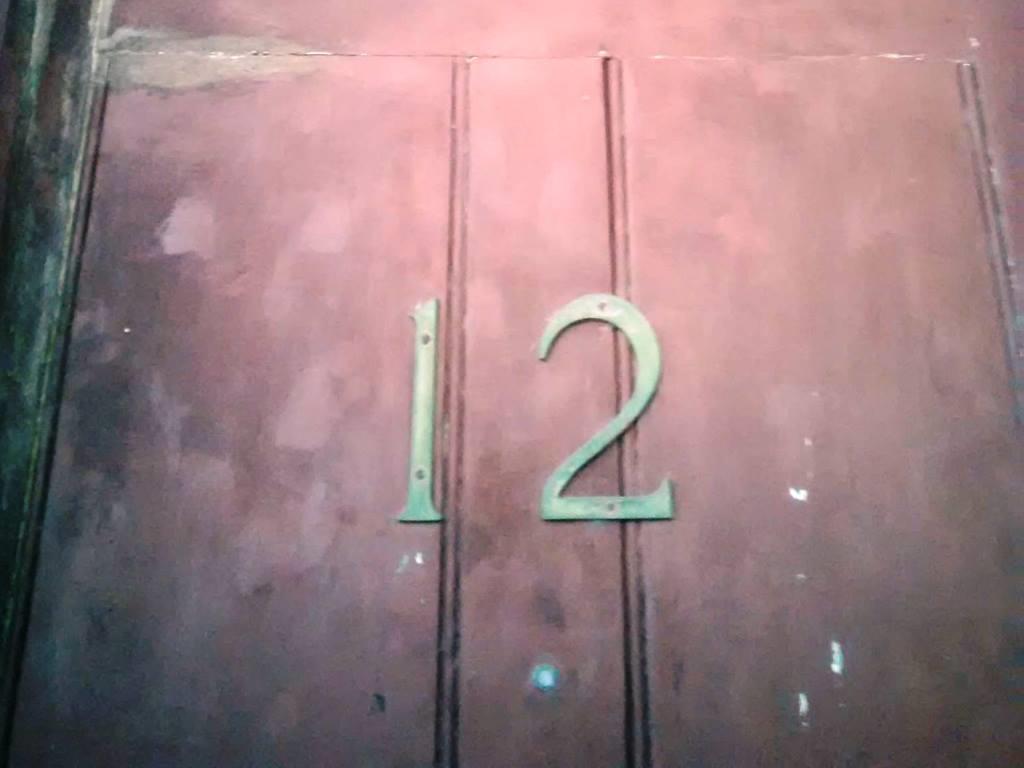
rental mental
Posted 05 April 2016
Renting in Sydney: I didn't expect it to be easy, and of course I expected for there to be a high demand for property, but I expected it to be nothing like this. Sydney is most definitely a landlords' market. Firstly, you have to register for viewings online and receive text message confirmations - there is no human involved. Unbeknown to us you must have an Australian mobile phone number to do this otherwise your 'application' will not be accepted - computer says no. Cue hot-footing it to the local Coles supermarket to buy a SIM card which was not accepted by either of our locked mobiles. Cue second visit to Coles to buy a cheap handset. We were then given our long-fought for fifteen-minute appointment time. Computer said yes. Everyone else is given the same time, too: group viewings not individual ones. You're so naive. You arrive at the property in good time - and watch as, slowly but surely, half of Sydney arrives by foot and by taxi. You view them as competitors. It's not unlike going for a job interview. A minute before the allotted time the estate agent arrives, giving only a cursory glance to the ever-growing cohort of expectant, and tired, faces. She sets up a small advert board with the company name emblazoned across it. She knows the cards are stacked in her favour and gives not one iota more effort or politeness than she has to. She doesn't care for your plight - doesn't care that this unfair affair could scupper your dreams of a new life abroad. This is brutal supply and demand at its most cruellest and she is a small part of the machine. She beckons the crowd in who walk around the property, beleaguered and disheartened at seeing yet another over-priced, underwhelming abode. Some prospective tenants try to schmooze her in the hope this will advance their application should they put in their offer. It doesn't work. She is a robot going through the motions. She has twenty other viewings to do in Sydney today - and her route is mapped out by a computer which seeks to maximise number of properties by minute.
Our first day of viewings got off to an ominous start with a viewing at an old Victorian terrace in the Paddington area of the city. We were the first to arrive but were soon joined by others. The outside of the property was absurd - but this was no comedy. This house, with guttering missing, rusting tin corrugated roof, barred windows thick with dust, a rotting balcony and a door which hadn't been painted for at least fifty years was, indeed, up for rent. We decided to go through with the viewing - but only because, having made the long walk there, we felt we may as well see the whole, strange process through in the hope that it would place us at a greater advantage in later viewings. It may also illuminate us (ironic use - see later) as to the dimensions of this very Australian style of terraced property. What shocked me most was that others were still keen to view despite the Hammer House of Horror exterior - much of which was obscured by a large overgrown tree with tentacled roots swaying in the wind and whose trunk had spilled over the kerb, liquid-wise, and onto the road itself. I noticed that the electricity box above the door (which had number '12' on it but may just as well have had '13'), had a large yellow sticker across it saying 'disconnected!' Umpteen horror film clips replayed in my mind like a Gothic celluloid montage. The viewing of the interior took place in dim light owing to the lack of electricity but also because the sunshine was impeded by the overgrown tree and by the filth on the windows. We were in and out within four minutes - stopping only to marvel at the audacity of the faceless landlord who thinks this is all okay. I left angry and disillusioned. We retreated back to our rented flat in Potts Point for a regroup and an evening searching our souls and the internet for more dwellings.
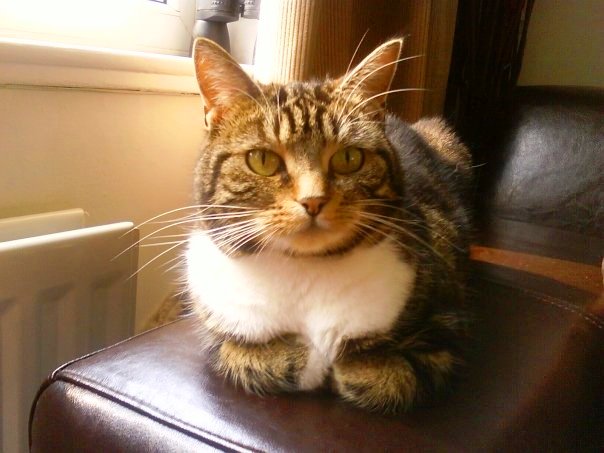
the dilemma of moving our moggy down under
Posted 24 February 2016
I'm a real animal lover and, over the last decade, have become immensely fond of our cat. We bought her from a rescue centre in Yorkshire and it has been the best £80 we have ever spent. As any cat owner knows, taking on a cat is a lifelong commitment. She really is the centre of our home and contemplating life without the little ball of fluff is very painful. From the off things were clear: no cat = no Australia. It's a dealbreaker.
You find yourself asking whether it's selfish to put a cat through the challenges of injections, quarantine and a near 11,000 mile flight. If only we could ask our cat what she would like to do but, of course, we can't. Of all of the things we'll be taking with us, Muffin is indeed the most precious of cargos.
We've enlisted the help of PetAir UK, a pet emigration company which is co-ordinating Muffin's journey from Essex to Heathrow to Melbourne and then another flight onto Sydney after a ten day stint in quarantine. She'll be placed in a heated part of the plane's hold and, I hope, be in no more discomfort than the human passengers above. She'll be in her own purpose-built cage which is sprayed with relaxing pheromones.
I'm concerned that, if we left her behind, she'd never be cared for in the way we care for her and that she'd pine for us. You only have to see her perform and roll about on the carpet when we return home from a few weeks of travelling to know that she really enjoys our company and that there is a special bond between her and us. Talking to a mother whose daughter has emigrated to Sydney reassured me: she had left the cat behind with a close friend but, after a year, the cat was still so miserable that she had no choice but to arrange for her furry pal to join her, at great expense, in her new life Down Under.
The realities hit home this week with a rather unpleasant set of events at the local vet who was trying to shave a patch of fur to complete the blood sampling required for the Rabies certificate for importation to Australia. Muffin had to return a second time to be sedated in order to allow the vet to do what he had to do. It is rather distressing seeing an animal you love upset and frightened and it has left me wondering, again, whether we are doing the right thing by taking her. As I type this she is sat next to me purring away as if the events of today at the vet had never taken place.

the revenge of the stuff
Posted 06 February 2016
Above everything else, bizarrely, this is the issue which has plagued me the most about emigrating: what do I do with all of my belongings? One accumulates so much stuff without even realising - especially if you have settled in one place for a few years. The anxiety about what's going to happen to it all is almost enough to stop your dreams of emigrating dead in their tracks. The old adage that your belongings soon end up owning you has never felt more true. 'We can't emigrate - look at all the stuff we have!' and 'We'll lose so much money trying to sell it ' and 'It's taken years to earn the money to buy...' are some of the thoughts which have plagued me endlessly. I want to start a new life - but this is the revenge of the stuff!
Of course, it sounds ridiculous to not start a new, exciting chapter in your life just because of some clothing, furniture and objects d'art. Clinging to possessions is really a proxy battle: for 'possessions' supplant 'home' and 'the familiar' and you can see why the things you own can quickly end up owning you. It's the displacement of fear onto inanimate objects.
I began where most migrators do: ebay. I've managed to raise around £1,000 from selling stuff tucked away in cupboards, duplicates or things I'd fallen out of love with. The charity shop is the next port of call - the perfect place to send all of your 'what the hell is thats' and 'what was I thinkings'. It's when you progress from these two easier stages to the third where things become tough - the getting rid of stuff you actually like but know you don't or won't need. At this particularly tricky third stage seeking out friends or family who will really appreciate (and care for) some of the things you give away can take the sting out of this tail and keep you on course to win the battle.
For the stuff I just can't let go of I have to 'fess that it'll sail across the world's oceans and meet me at a port near Sydney in a few months' time courtesy of a shipping company. Not only will this mean I feel less bereft in my new home but it may just help fend off the worst of any homesickness once the initial excitement of 'Oh my god I did it!' has subsided. I'm all for a mid-life reboot but a complete annihilation of my life so far is discombobulating and far from healthy. I prefer to think of my emigration as a continuation and augmentation of my pre-existing life - not a complete wipe out and so some stuff is here to stay. It's a tie-break.

...and now the start of something else...
Posted 29 January 2016
It has been a long time coming but a visa, which gives me the right to live and work in Australia permanently, has arrived and it's all systems go for my first ever emigration - a mere 10,000+ miles away from everything I know. It will be great but I also have no doubt it will be really hard, too. There are lots of opportunities and, I have no doubt, lots of hurdles. I'm approaching this pragmatically: not everything is going to be sunshine and koalas.
Obviously the awarding of the visa is the near end of the bureaucratic journey which has lasted, seemingly, years. It has taken us through periods of hope, periods of despair and periods of naive ignorance along the lines of 'it'll be okay' to get to this stage. It has been a process with its own rules, unfamiliar use of language, a whole host of new acronyms (AITSL, BOSTES, IMMI, DIBP, WWCC, VEVO) and unique sense of glacial timing...
This administrative roller-coaster has also included the expensive certification of documents by notaries, the contacting of three former universities for amended transcripts and other course-related documents, the sitting of English language exams at Manchester University (even though I am English born and have a first class degree in the subject) to increase my visa points score and thus my chances of receiving a visa invite sooner rather than later, and the humiliation of standing in my tighty whities in a med migration clinic being given the once over - including a HIV test. All of this has cost the not insignificant sum of £3,000. One thing is for certain: if you're not committed to migrating to Australia, you simply won't make it. You need stamina, a degree in Franz Kafka, another degree in patience - oh, and lots of money.
Having completed all of the hard work, it is only now that the real hard work begins. This is only the end of the beginning and the start of...something else. Not to overwhelm myself too soon but among my next steps are the finding of a place to live, getting a tax file number, having a Working with Children Check, registering with the teaching body in New South Wales and the small matter of finding a job!
travel tips, links & resources
- I’ve been through the process of applying for, and attaining, a visa to live and work in Australia and, later, Australian Citizenship. However, I am not in a position to offer visa advice. Please consult your nearest Australian consulate or embassy. Alternatively visit the Australian Government’s Home Affairs website.
- Australia offers a wide range of visa types for different employment vacancies but the number of roles on the Skilled Occupations List (SOL) changes regularly. Before you get carried away with your big Aussie dream, make sure you’ve kept a close eye on what occupations are on this list.
- Be warned that in applying for a visa you will be required to produce a mountain of documentation evidencing everything from your work experience, relationship status and health and wellbeing. The process is frustrating and intrusive: but that’s because it is meant to be. One thing’s for sure: only those who really want to get into Australia will manage to do so.
- Applying for a visa is also an expensive process. Be prepared to pay for the very bureaucratic process you will quickly come to despise.
- My advice would be to cut out the middle man when applying for your visa. I have read some truly terrifying horror stories about would-be migrants putting all of their faith in a visa company which then either went bust or vanished into thin air. In my opinion there really is only one way to go: do it yourself. The process is a little labyrinthine and the process quite complex, but over time you begin to get the hang of it. You will also feel a huge sense of accomplishment when you receive that magical 'VISA GRANT NOTICE' email.
- A good source of information for British expats is the online forum pomsinoz.com. Head here if you have a burning question about life in Australia on anything from keeping cats in strata properties to finding out if your British television set will pick up Australian television.
- I would advise you to ship your belongings to Australia rather than sell or give them all away with a view to re-purchasing them when in Australia. I soon discovered that the consumer market is different in Australia. Not only will you struggle to re-source the things you have given away, you’ll soon realise that they're very expensive to buy again at Aussie prices (times most prices by at least two). Just ship your stuff over – you’ll be glad when it arrives. We used Anglo Pacific as our shipping company and had a good experience. You can expect to wait anything from one to three months for your worldly belongings to arrive.
- Finally, emigrating to Australia was one of the best decisions I have made in my life. I count it in my top three. The hard journey is worth it in the end.
you may also like


